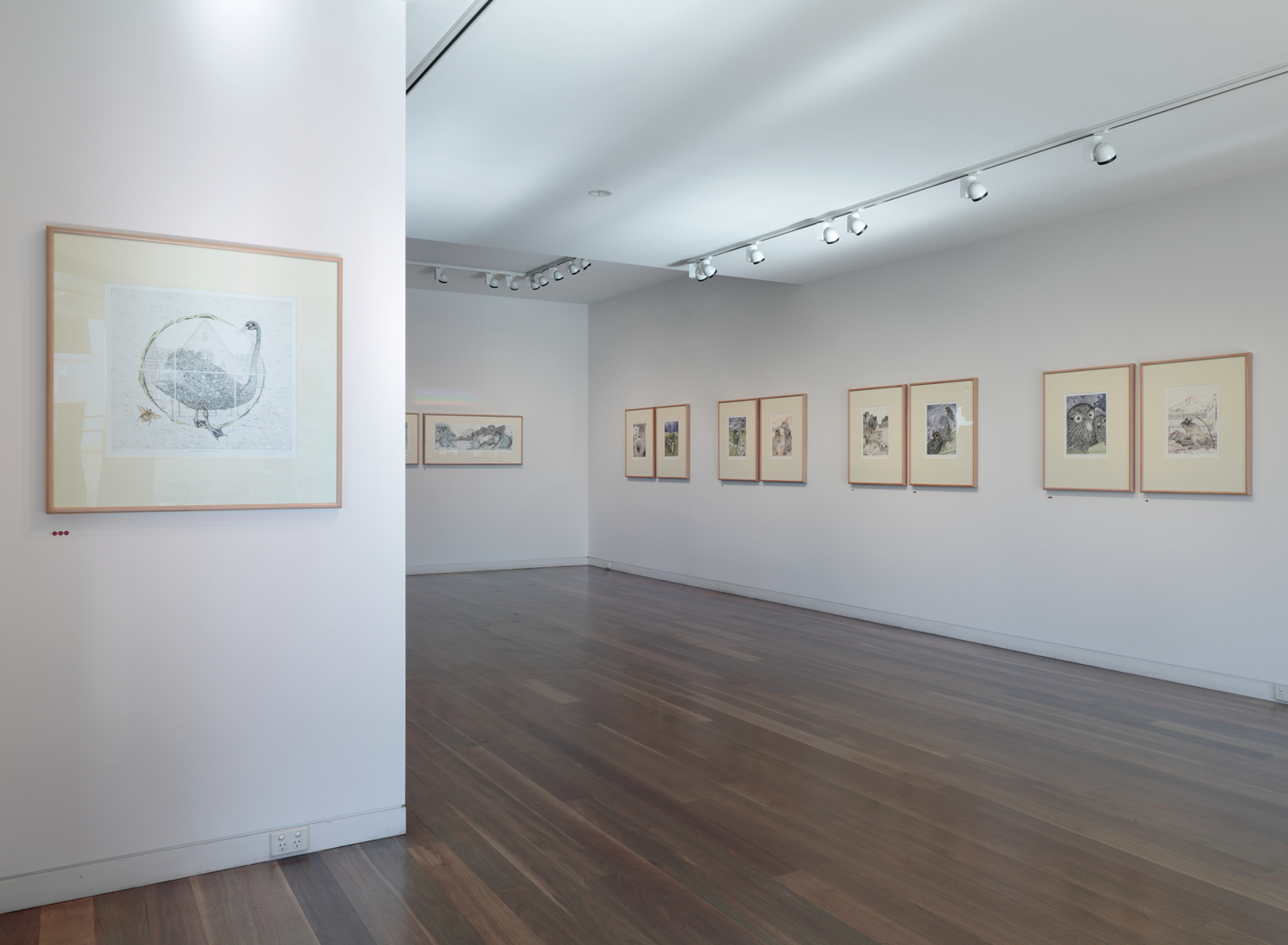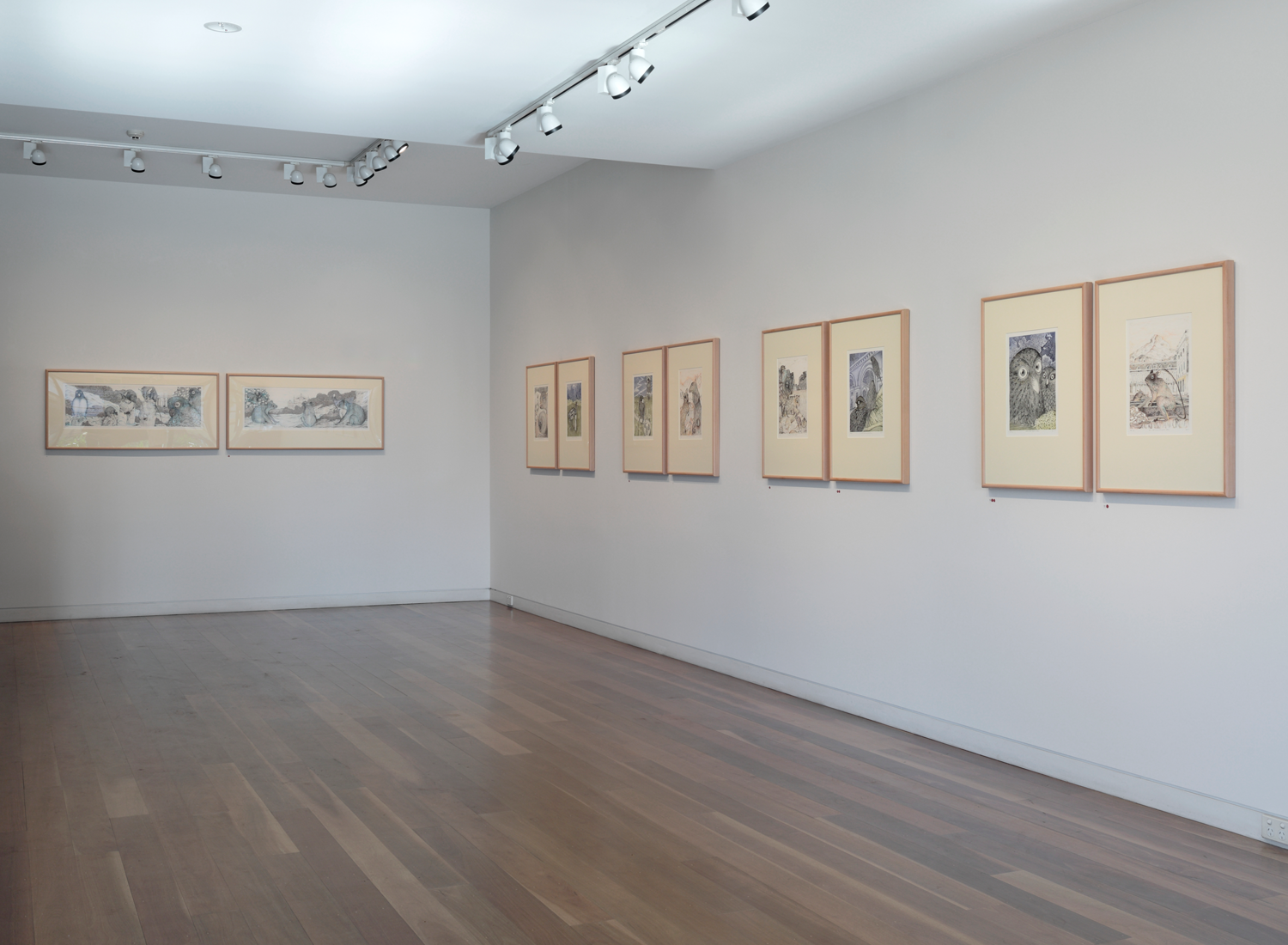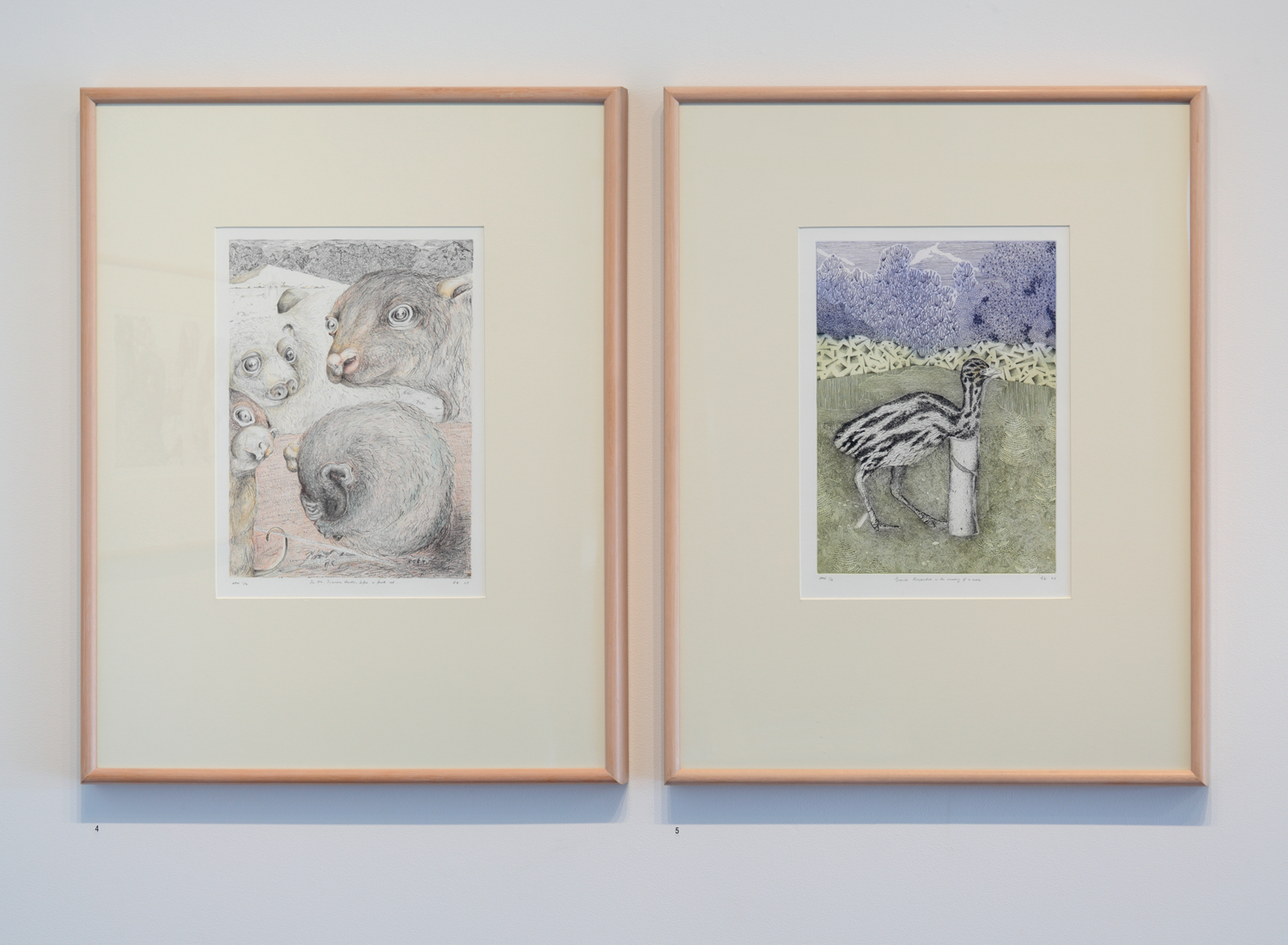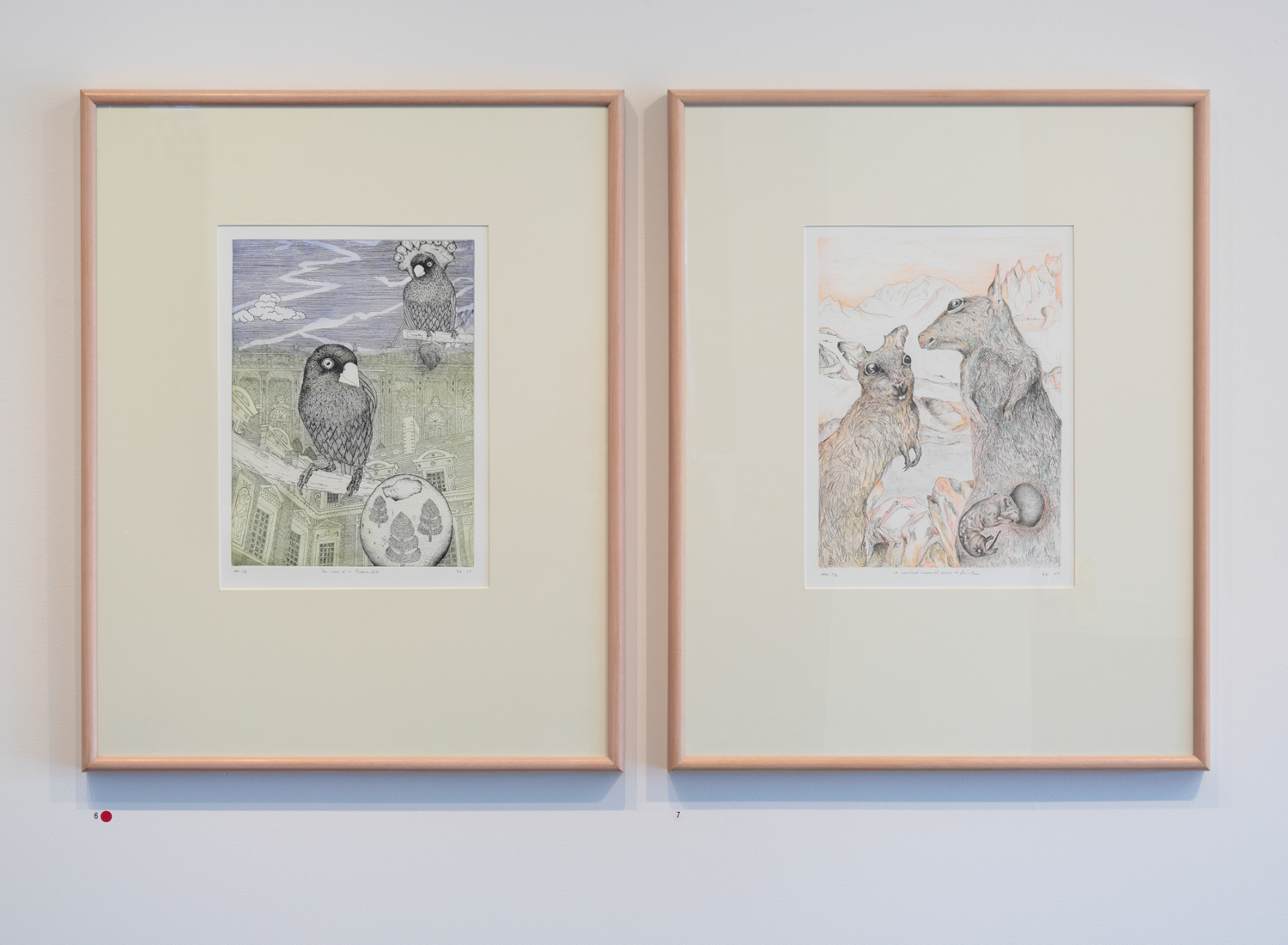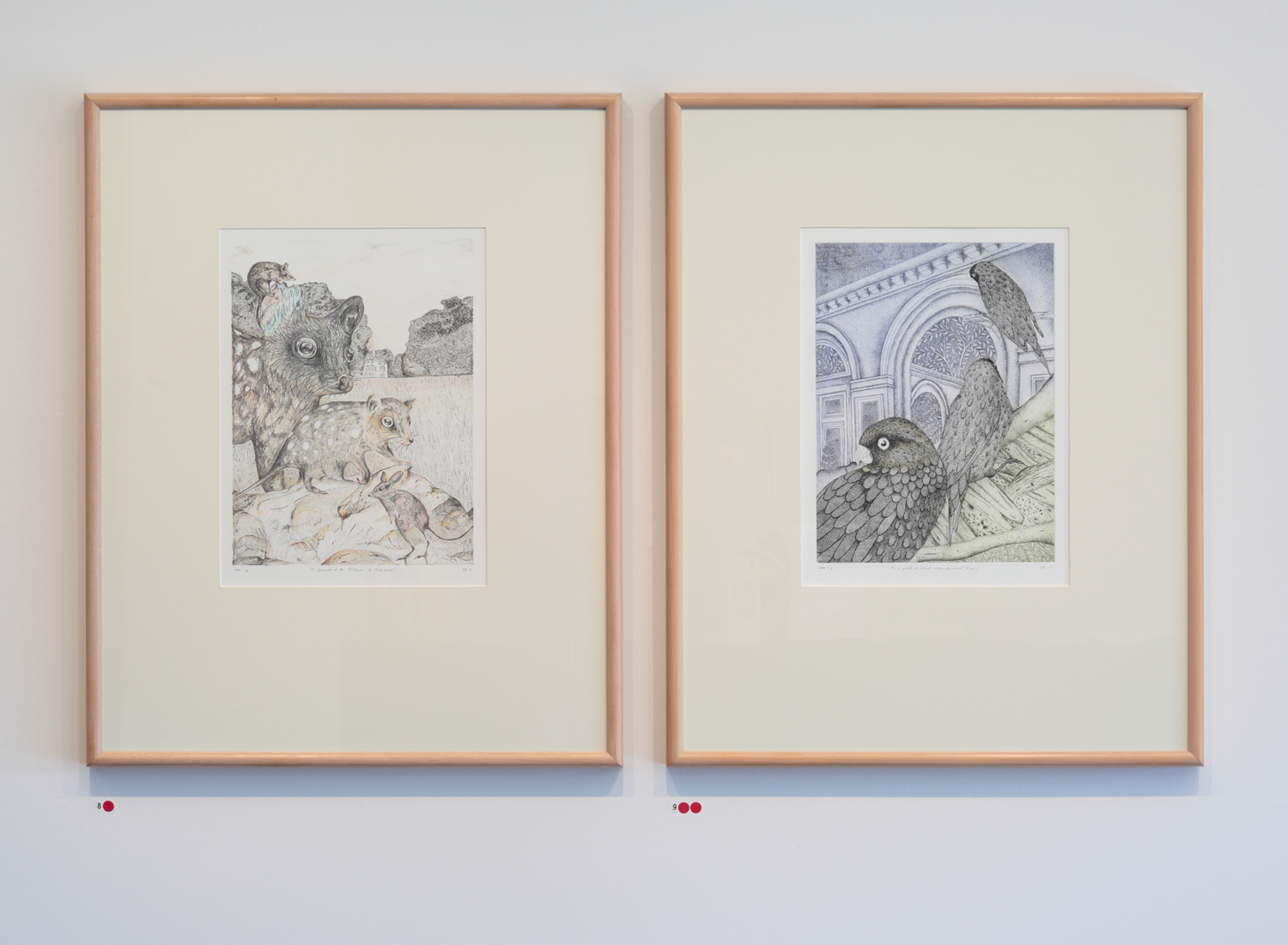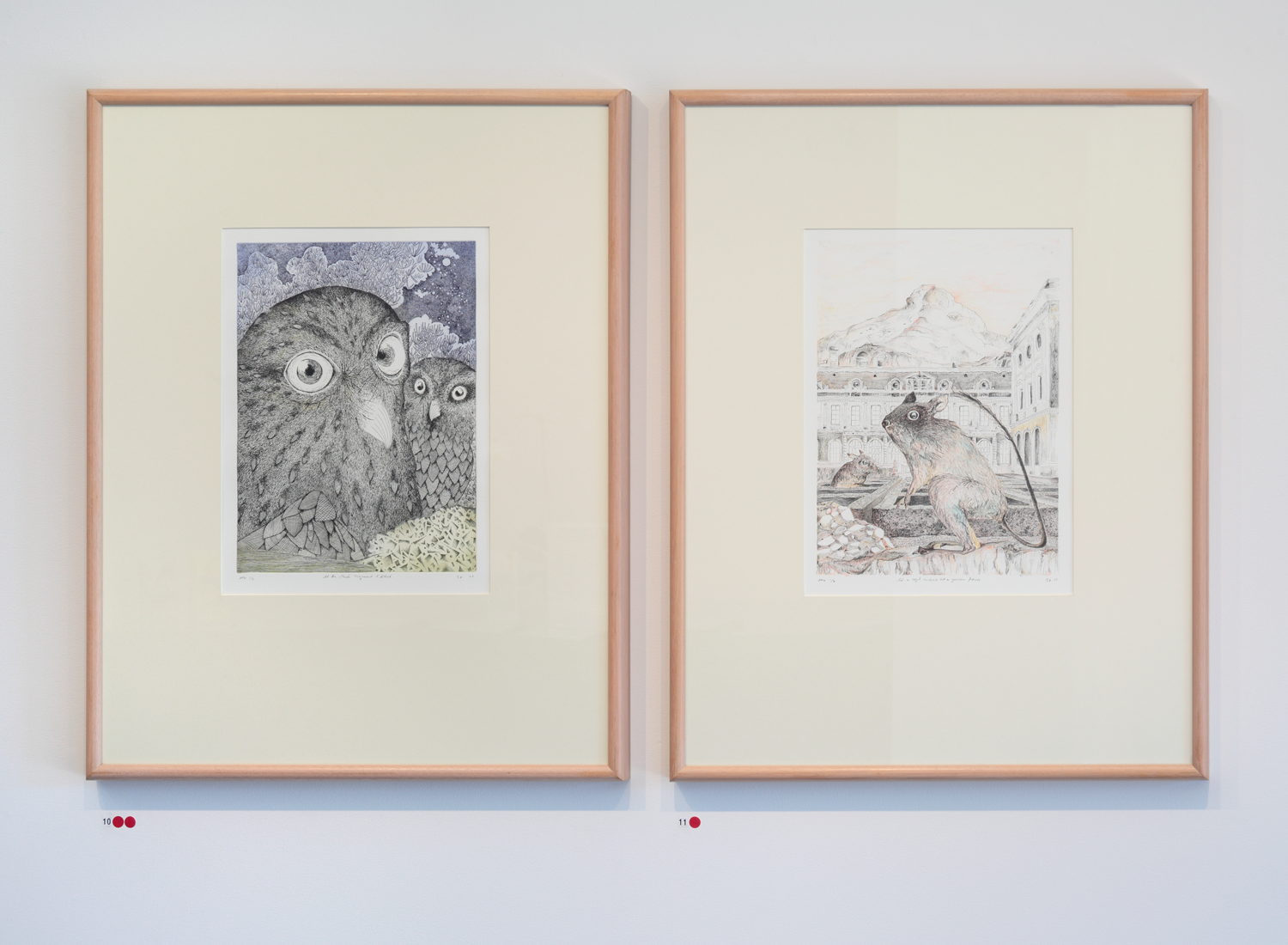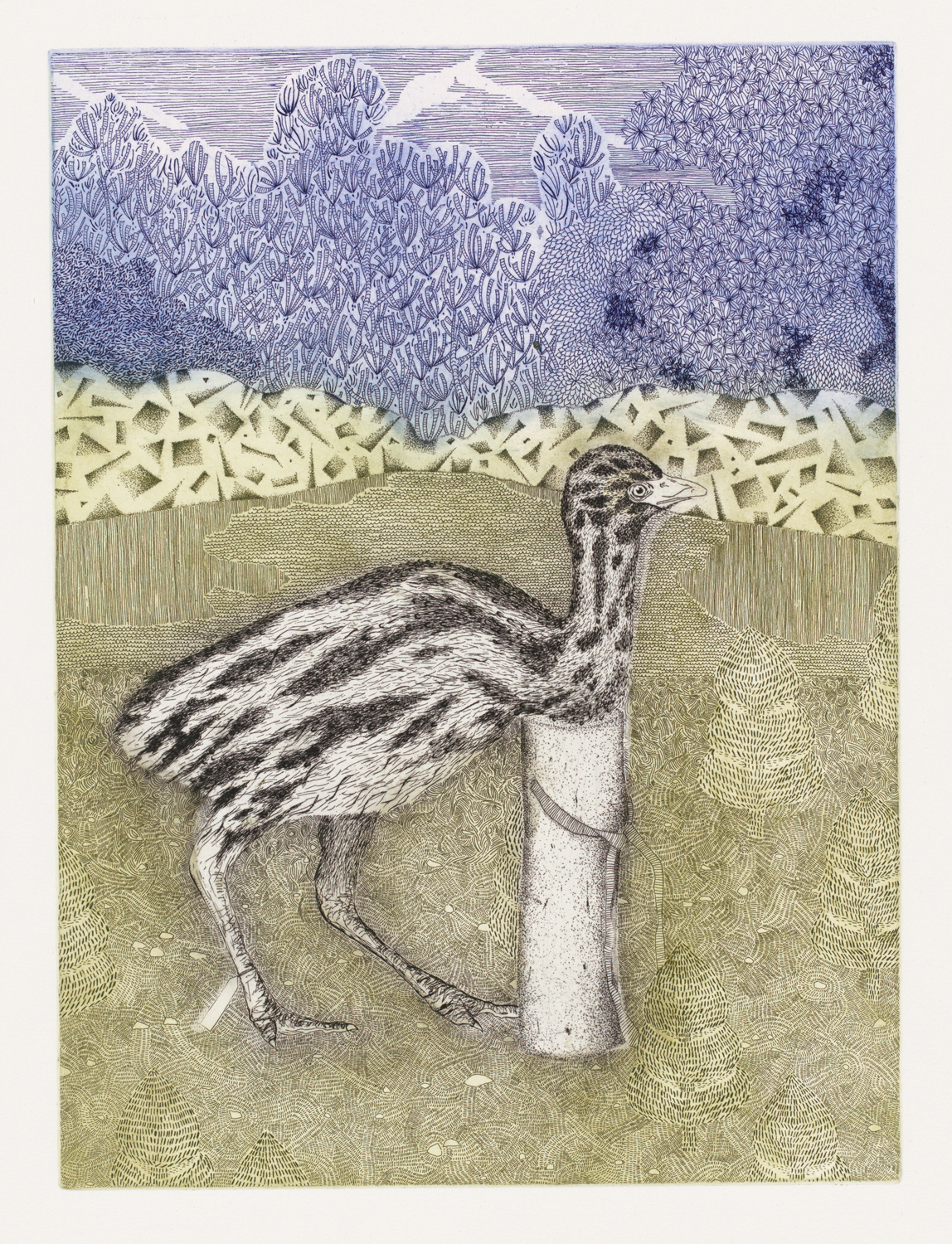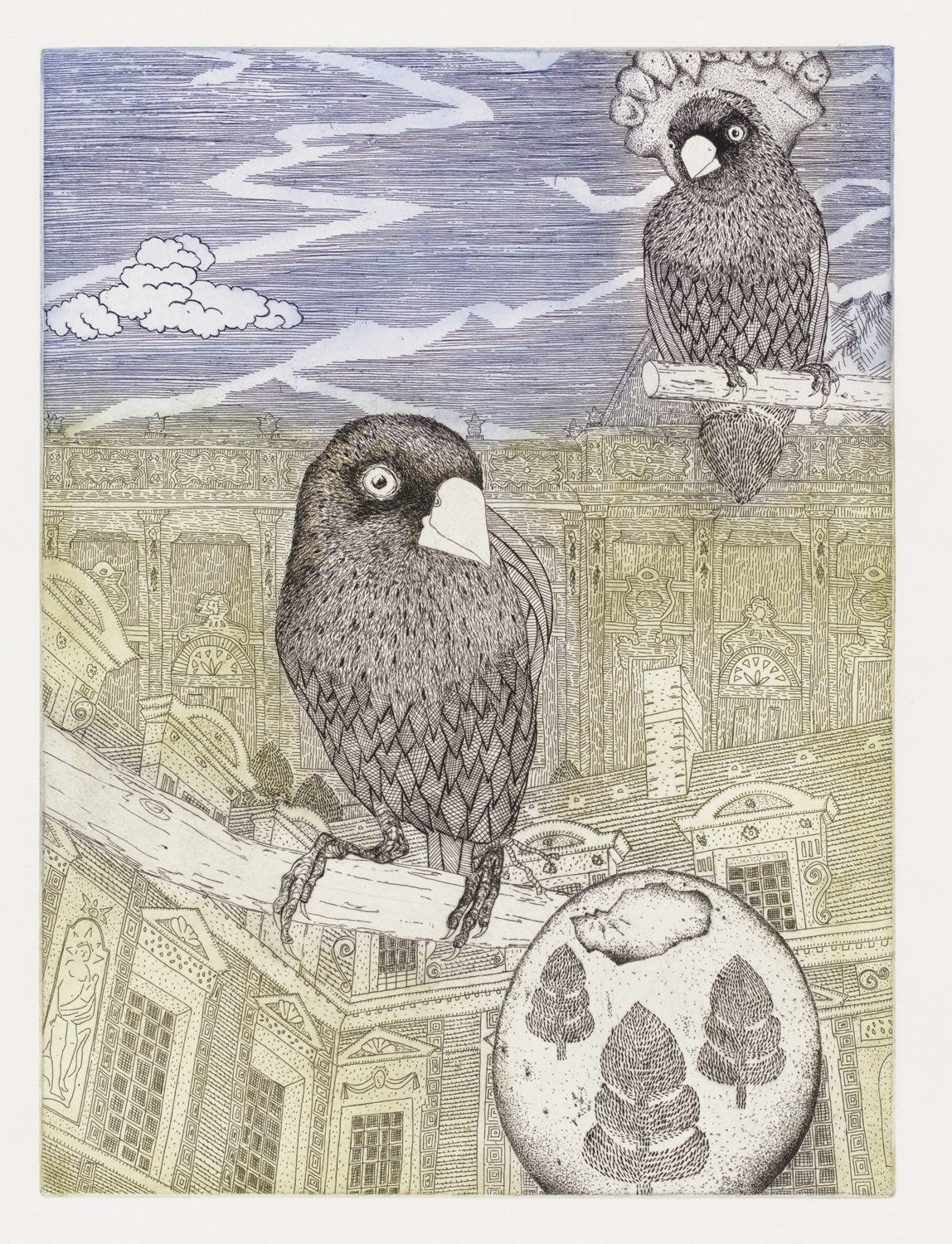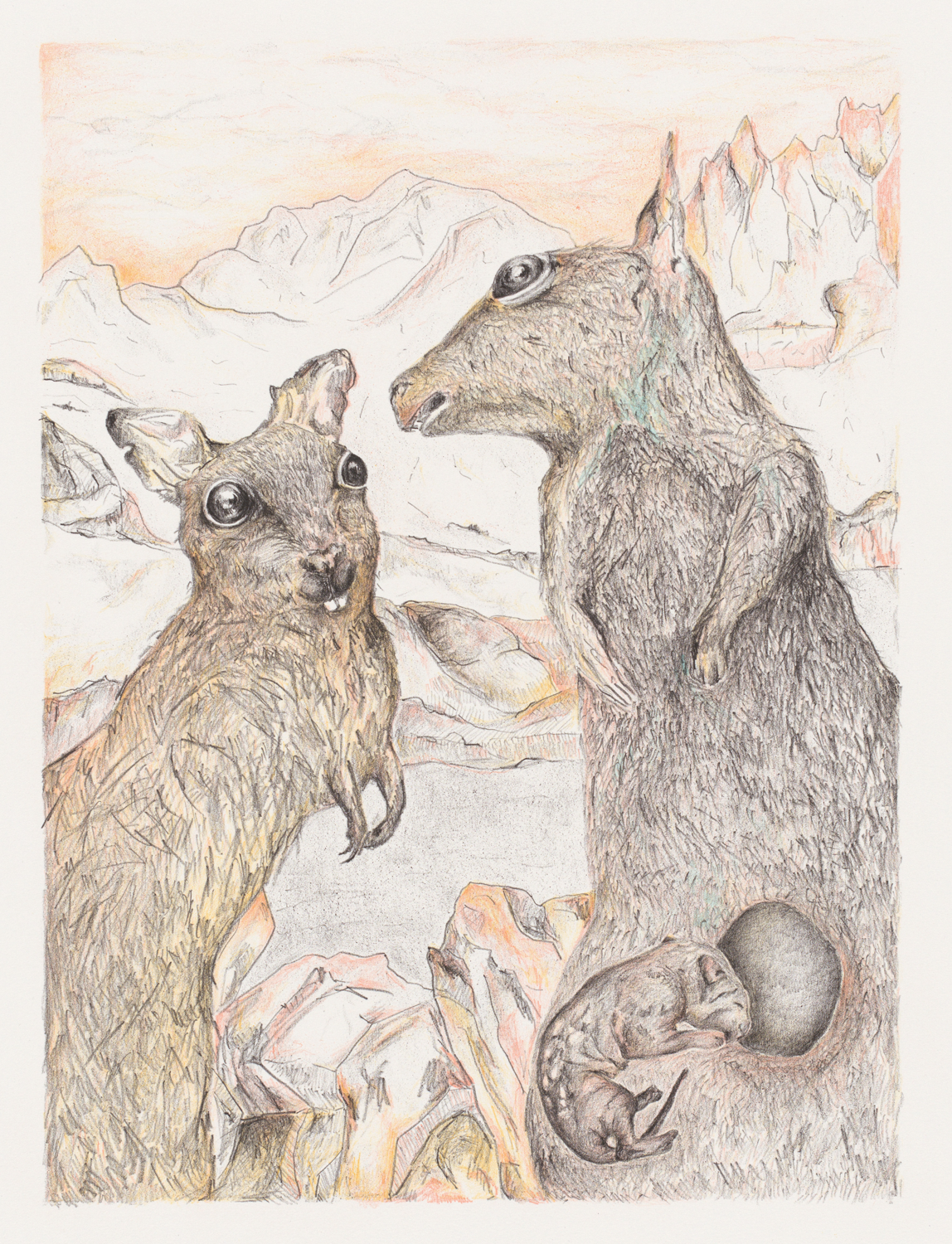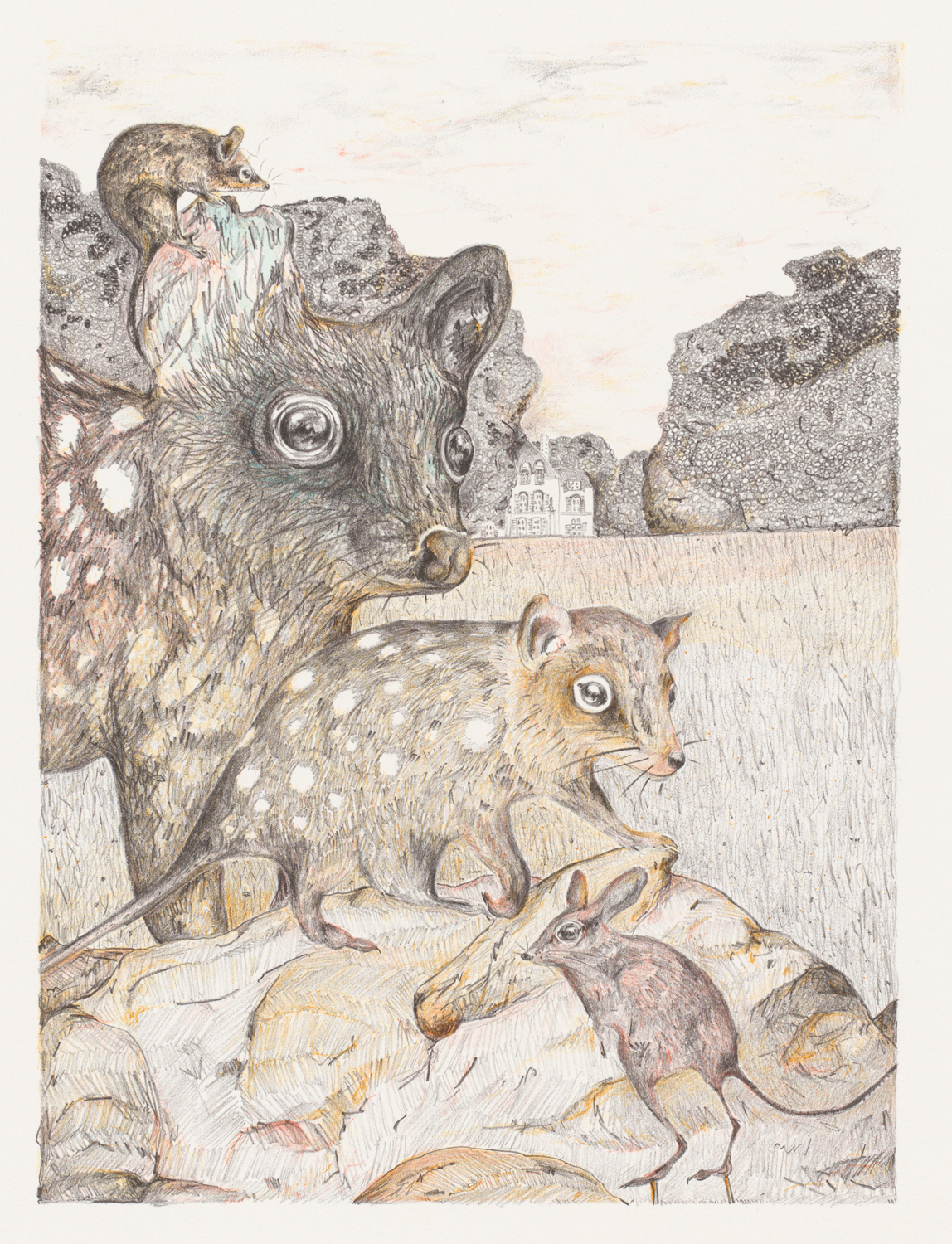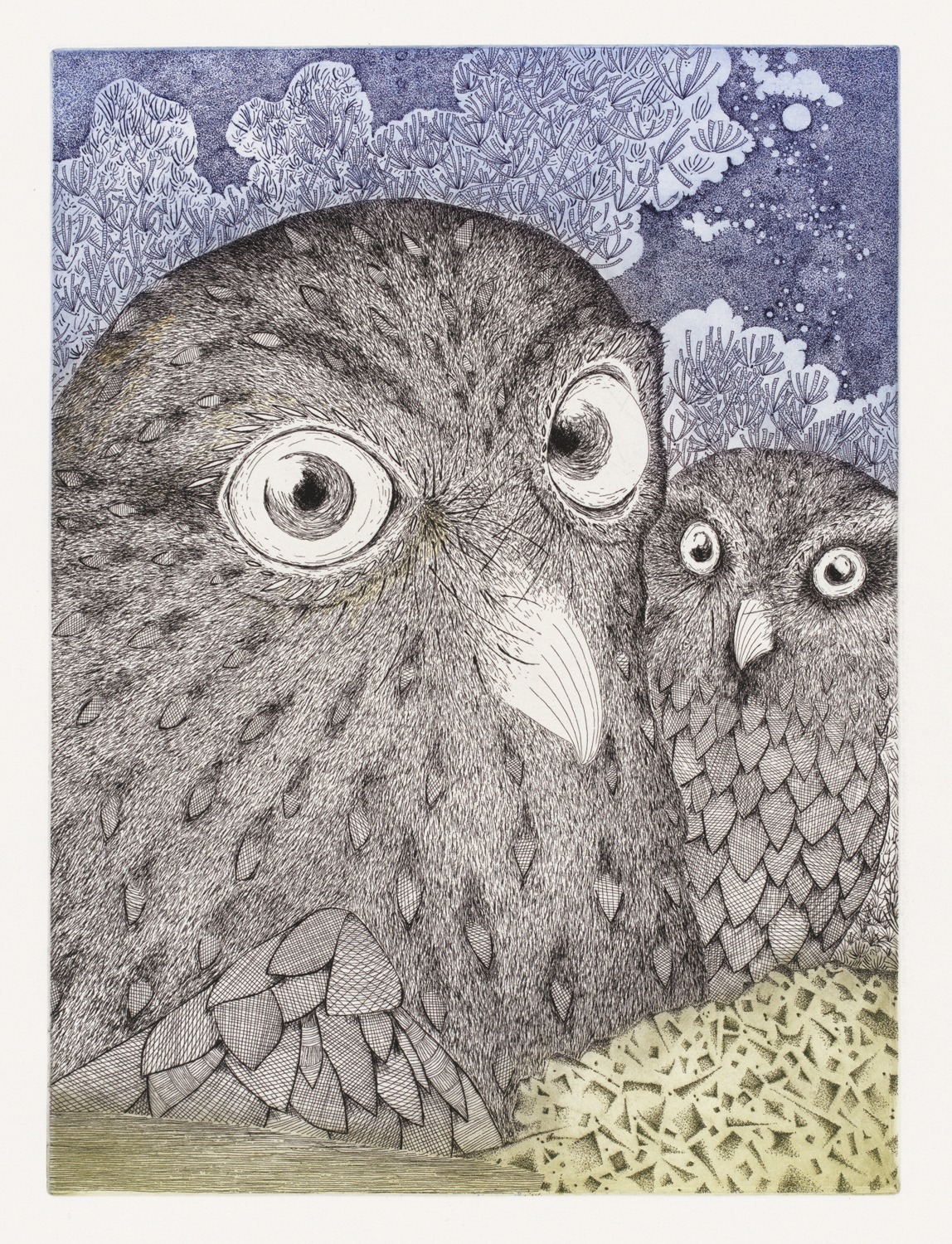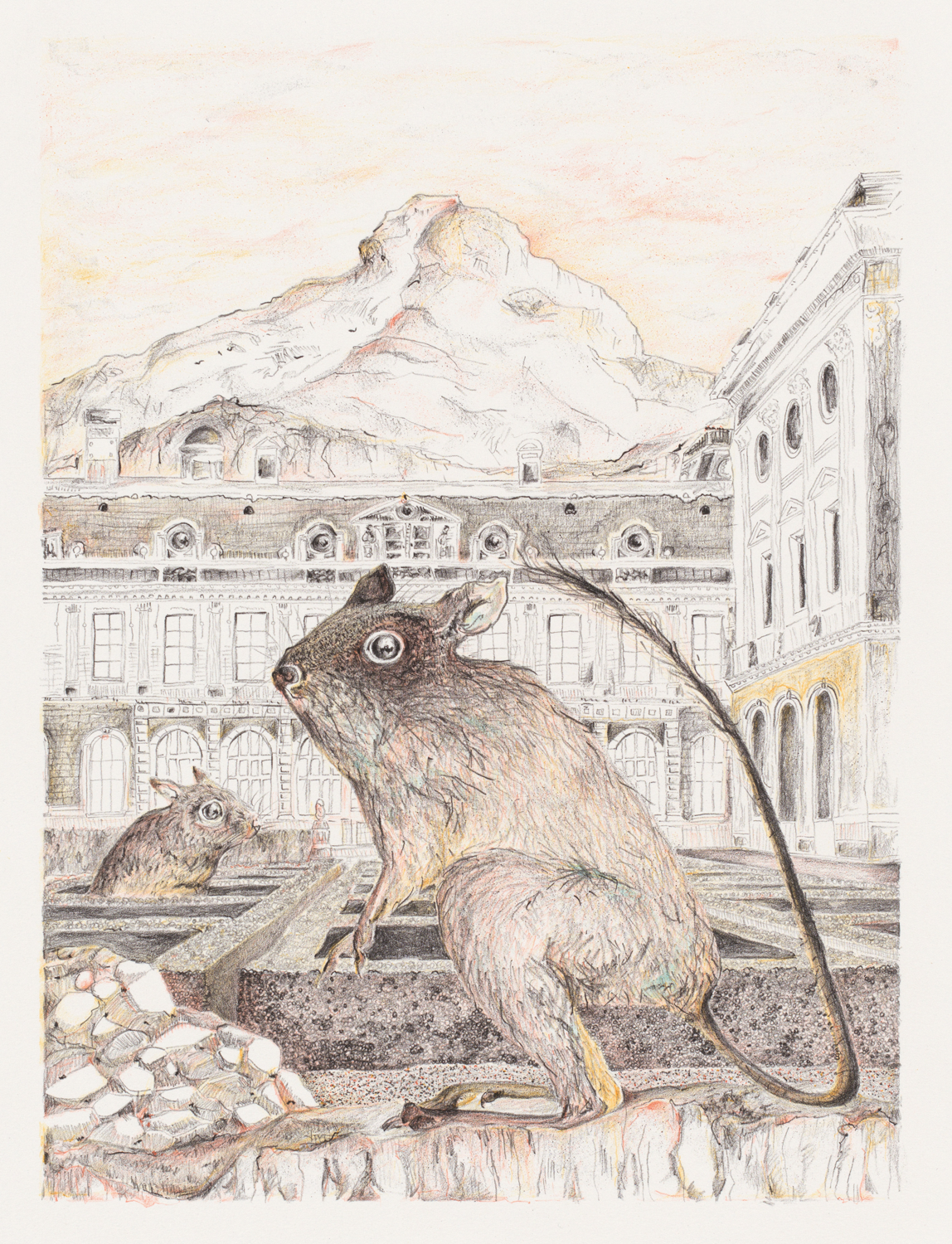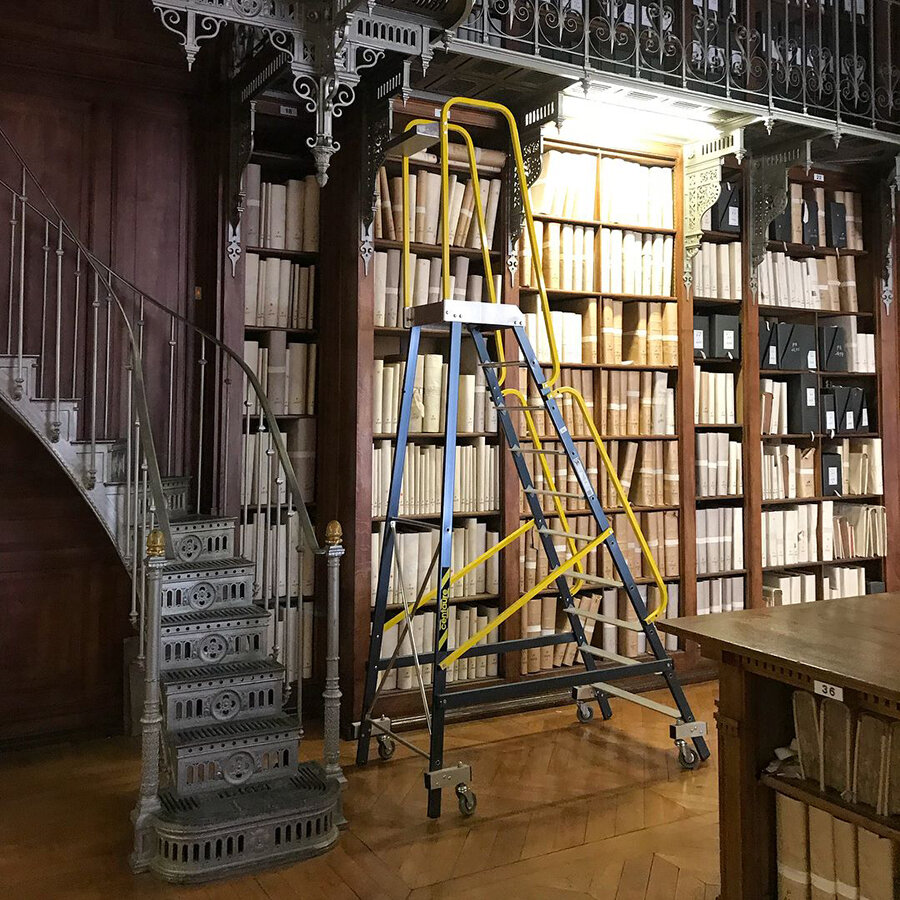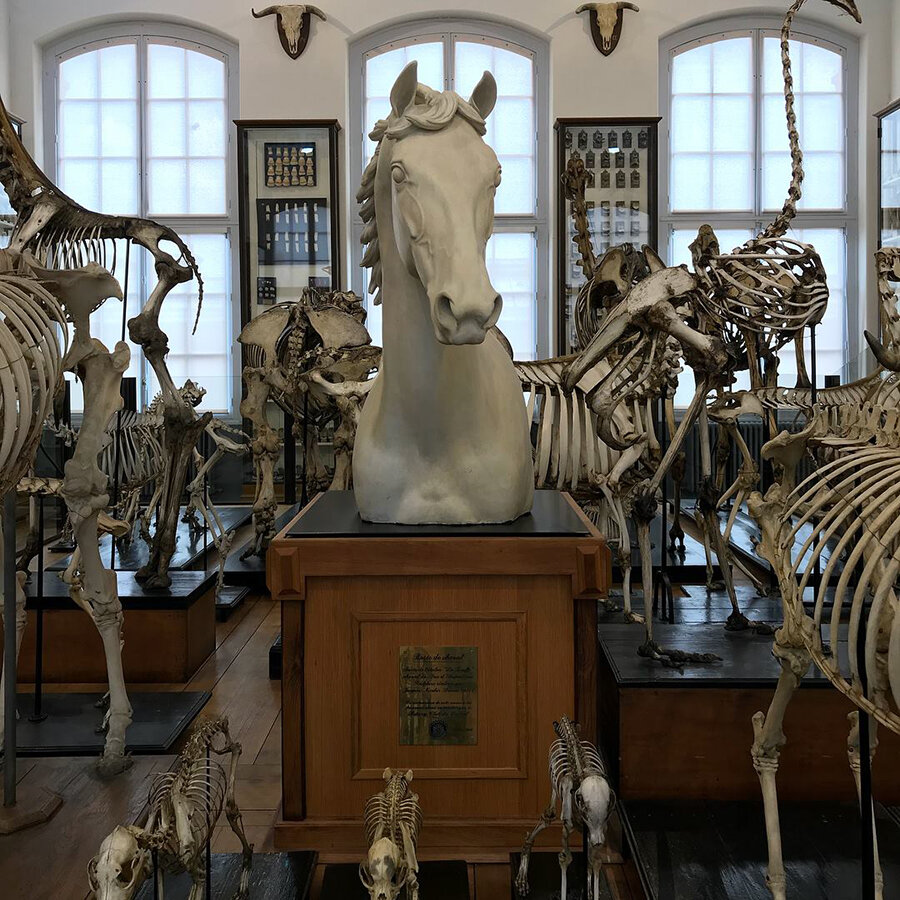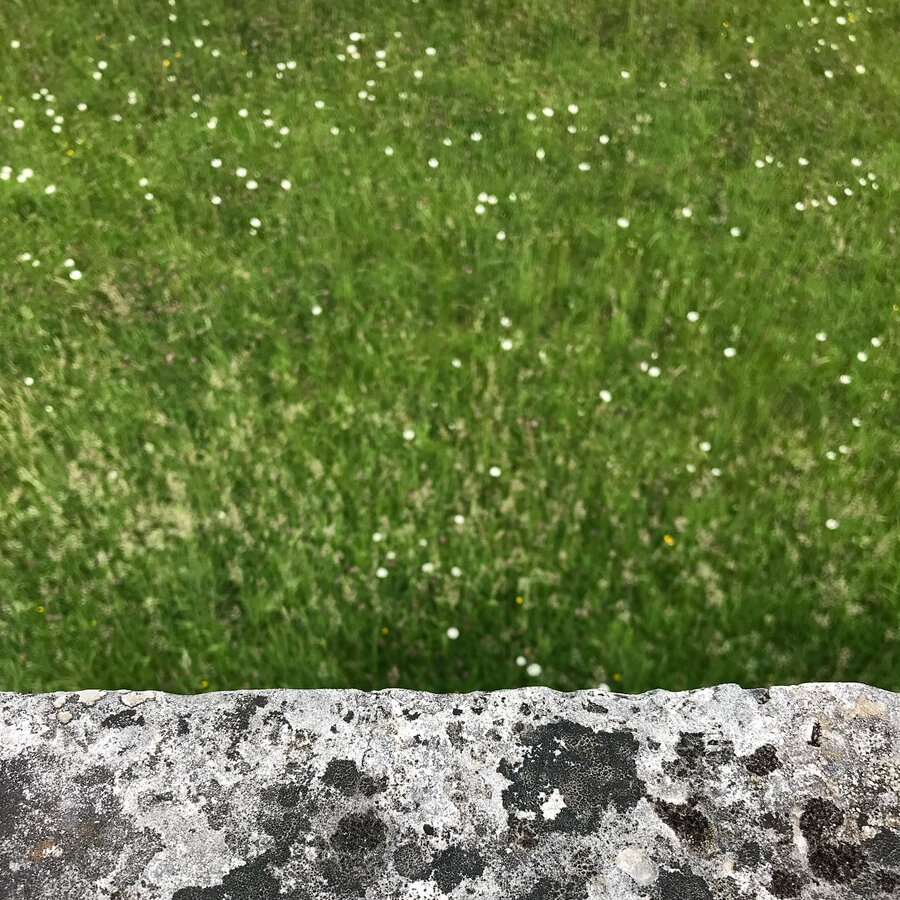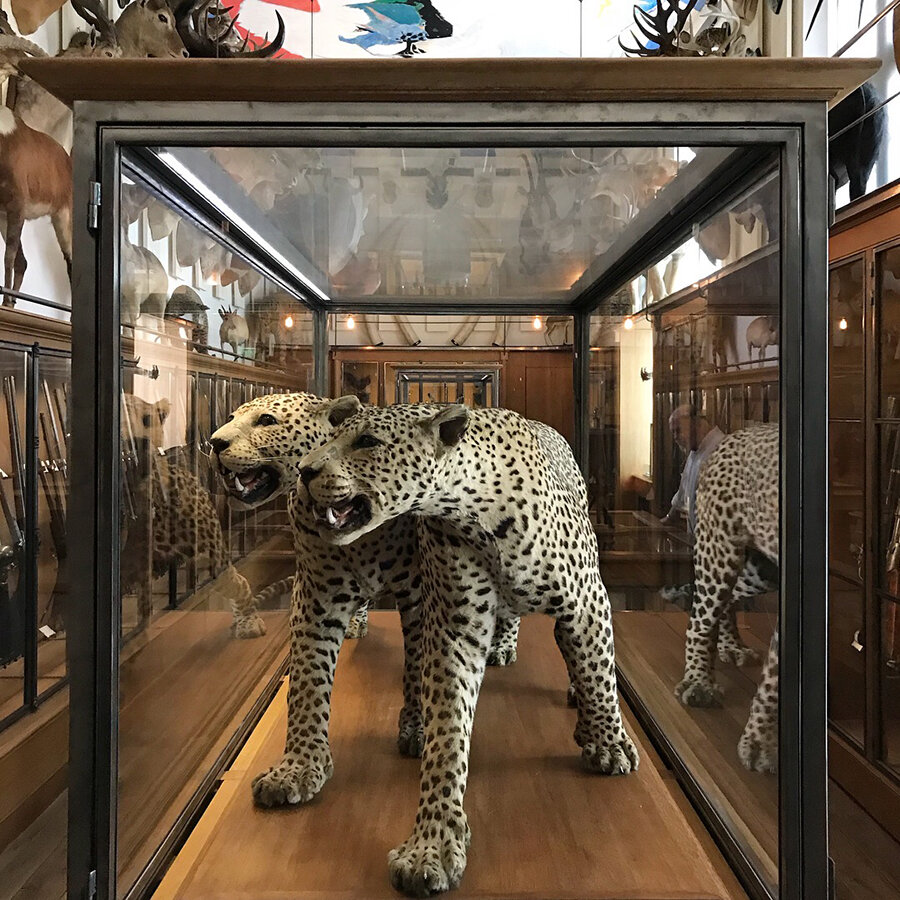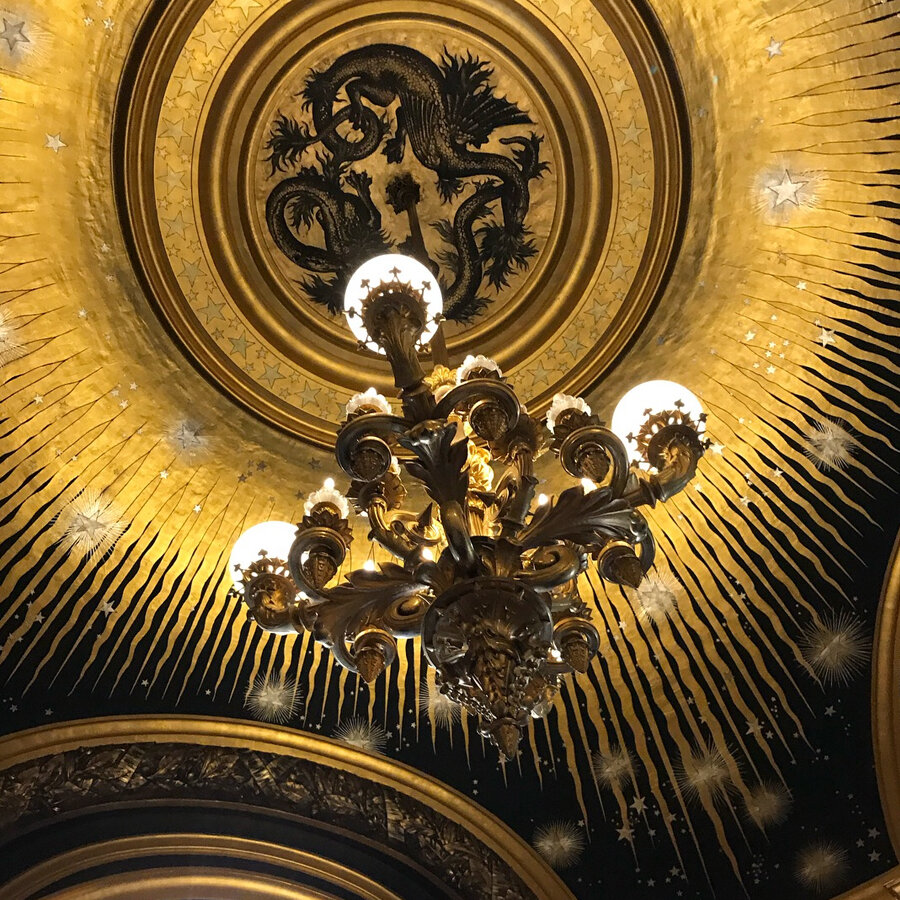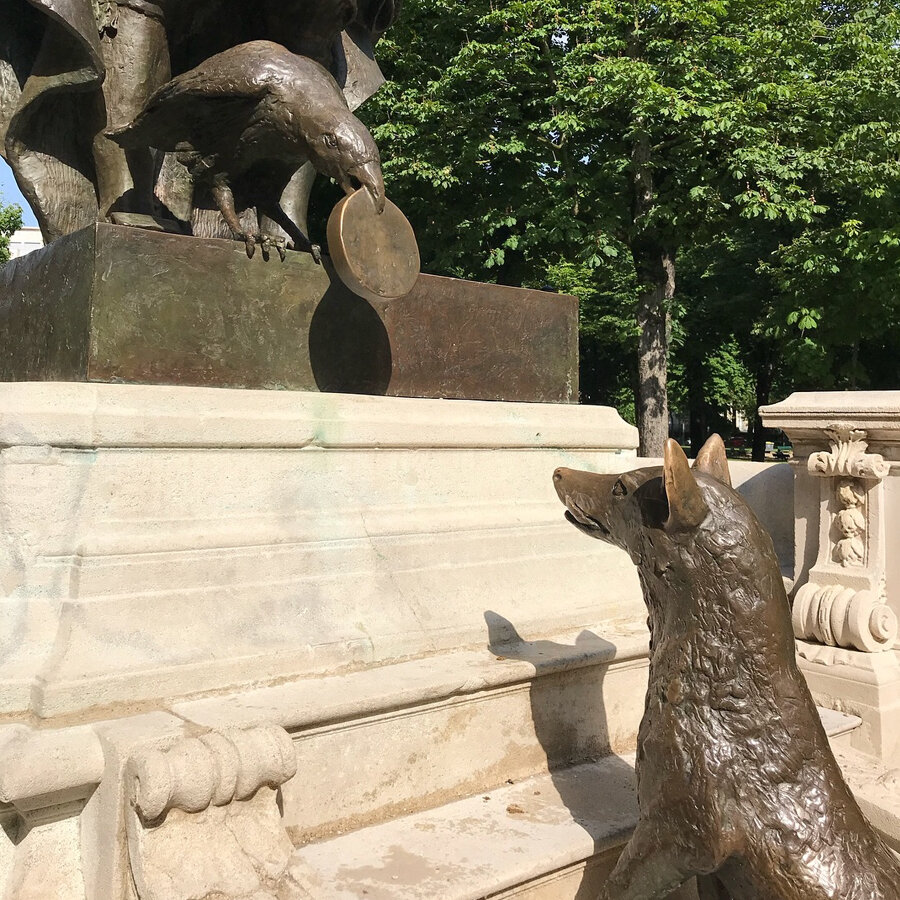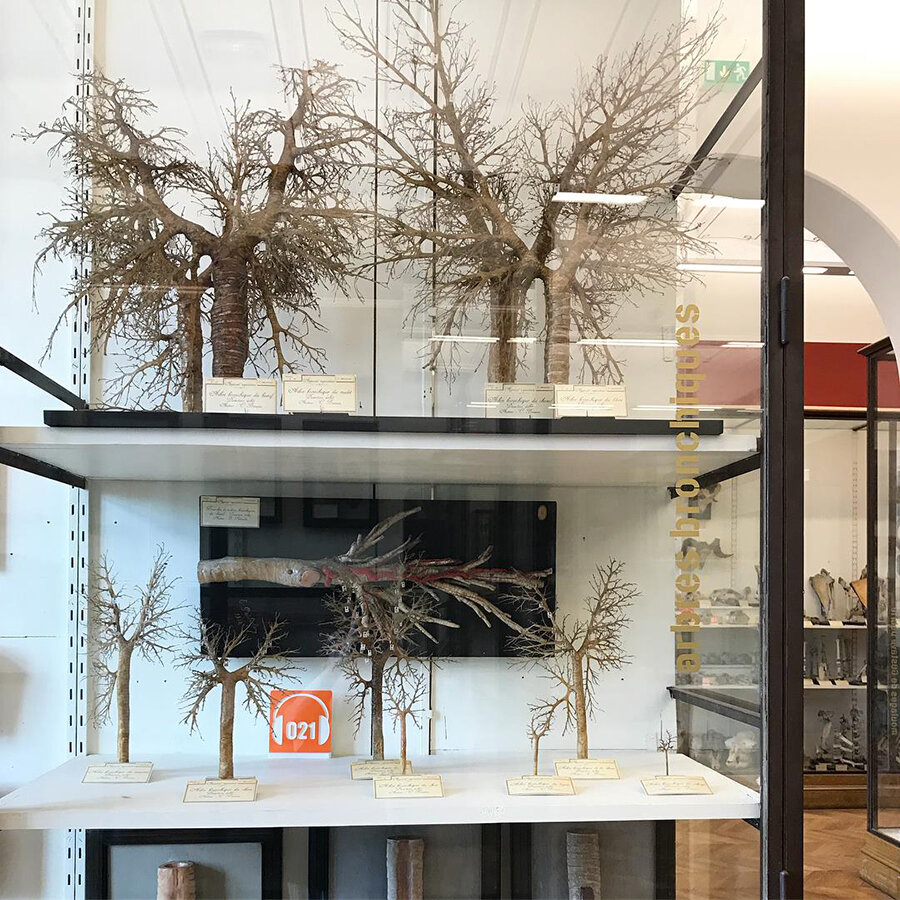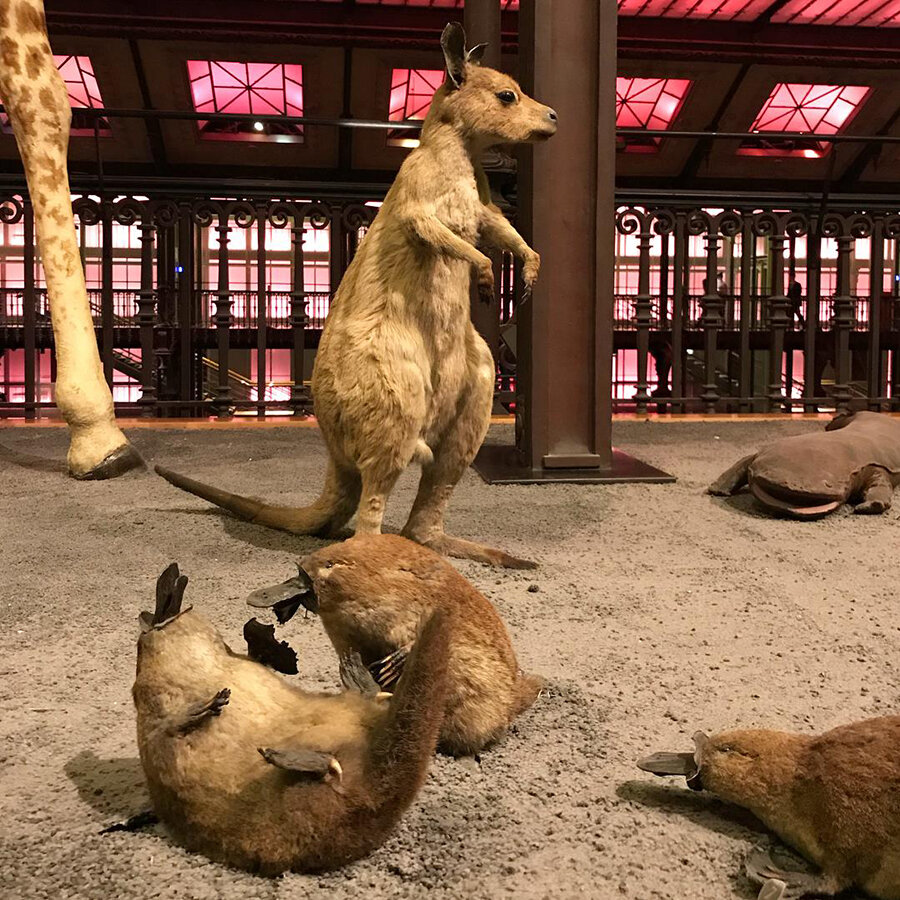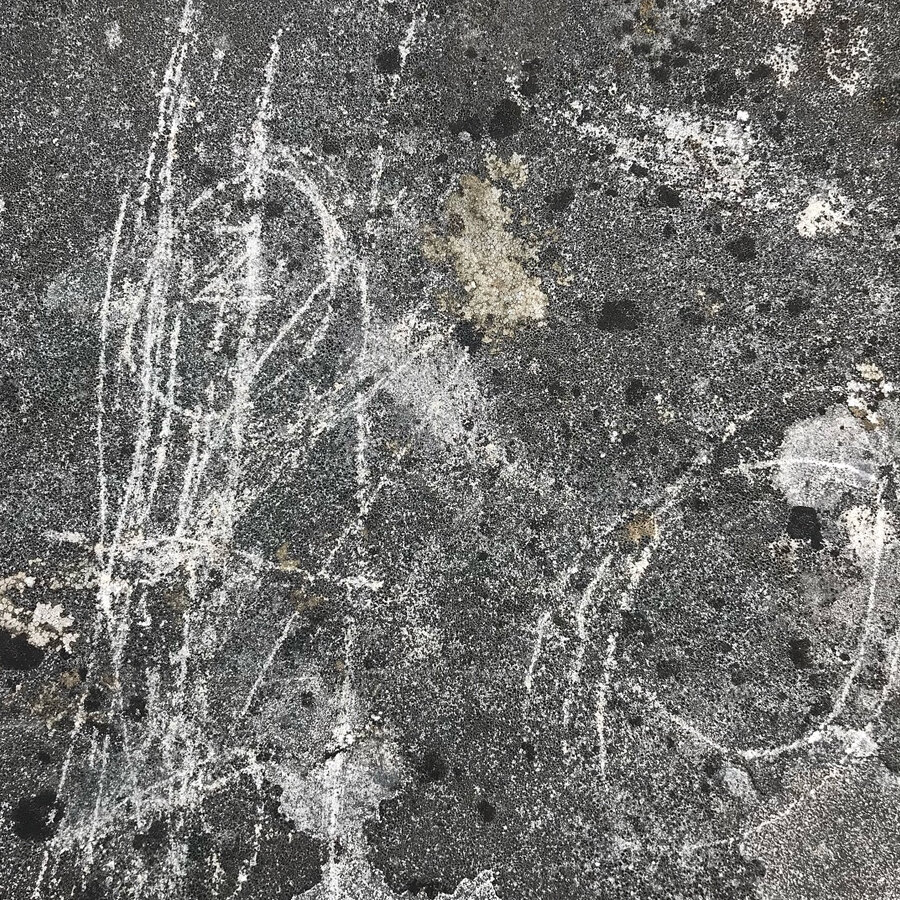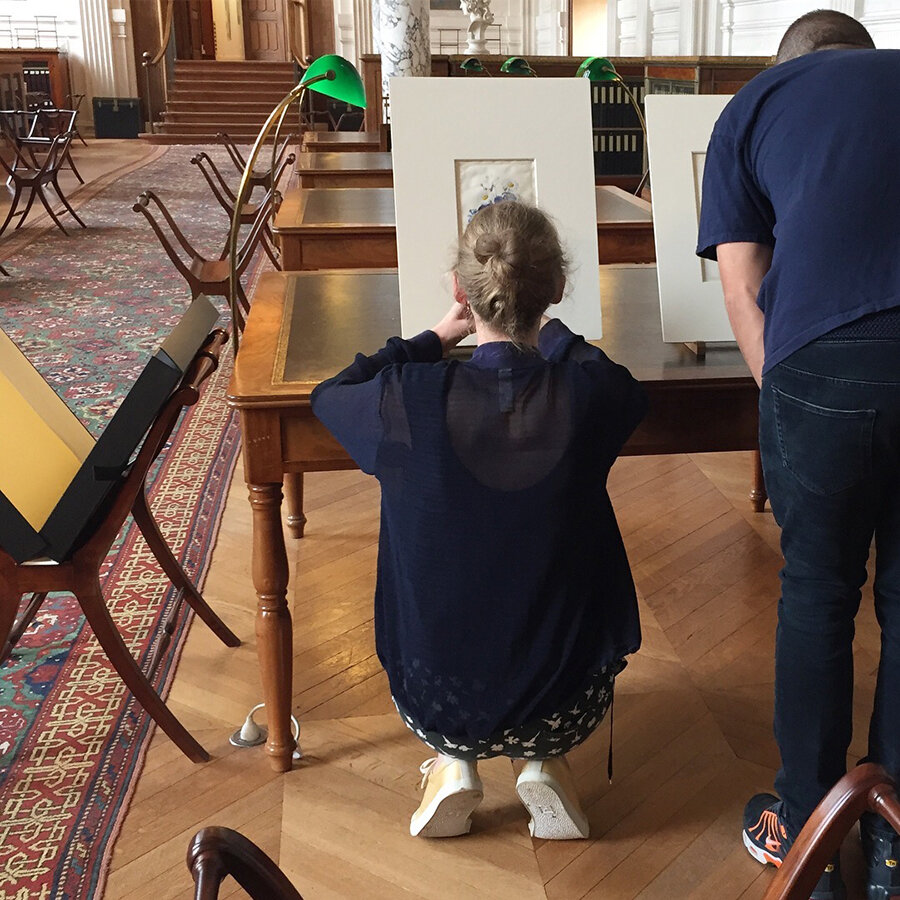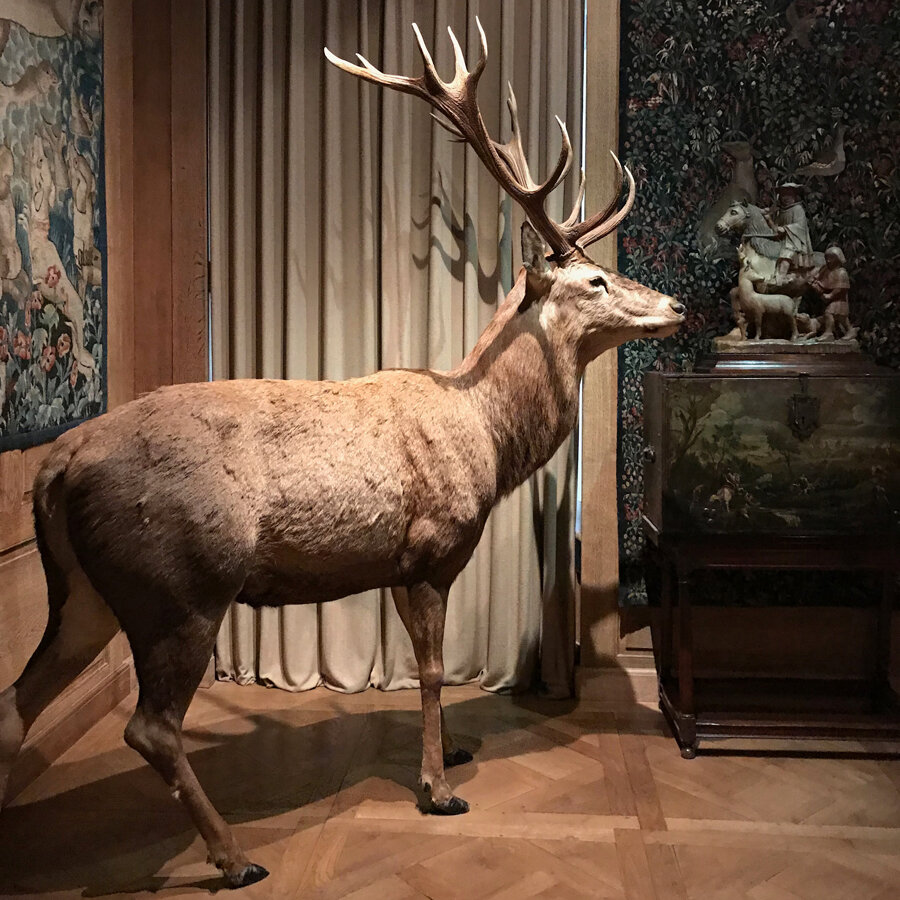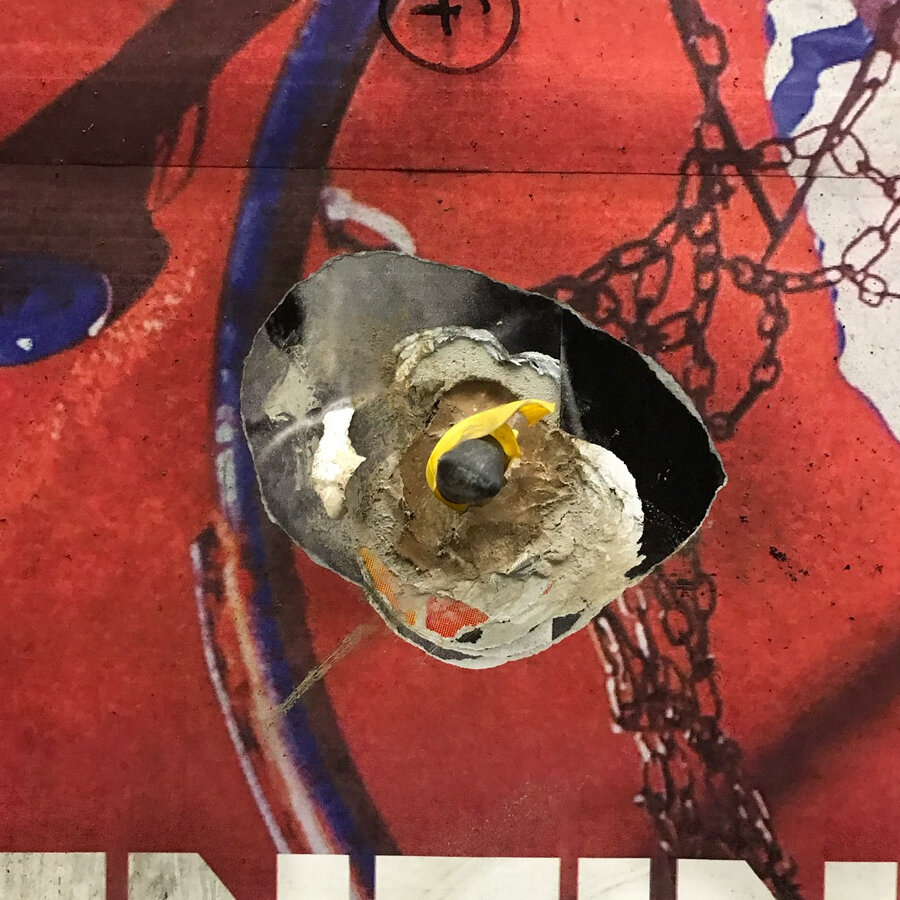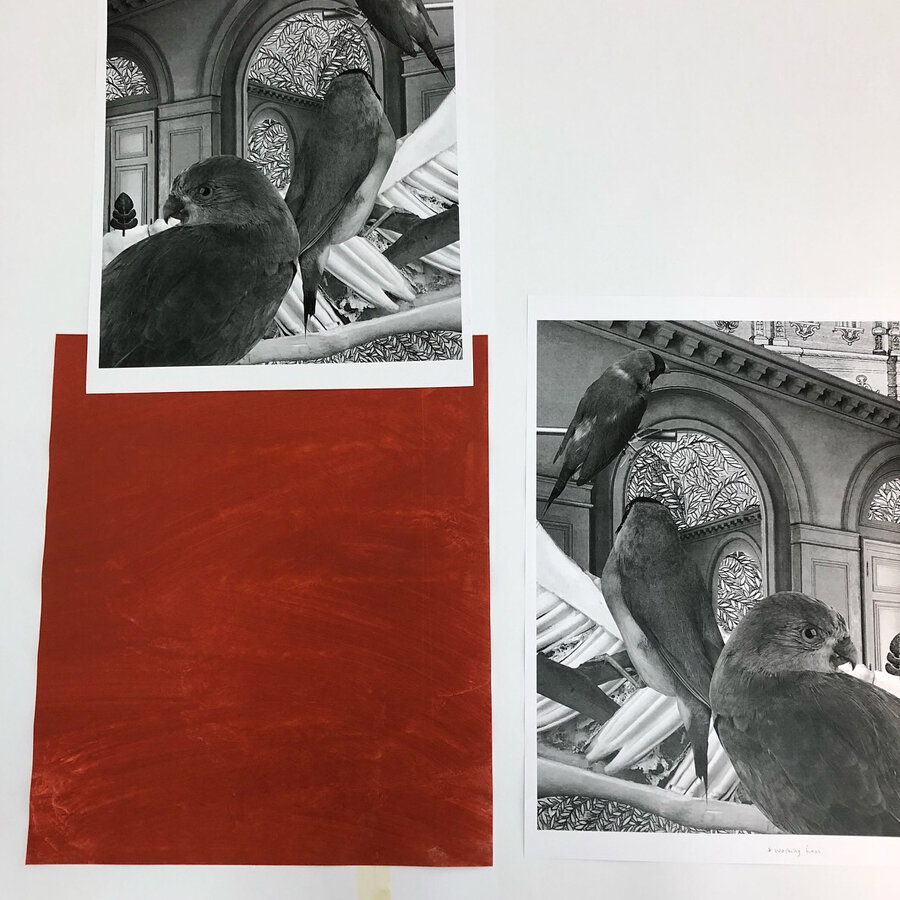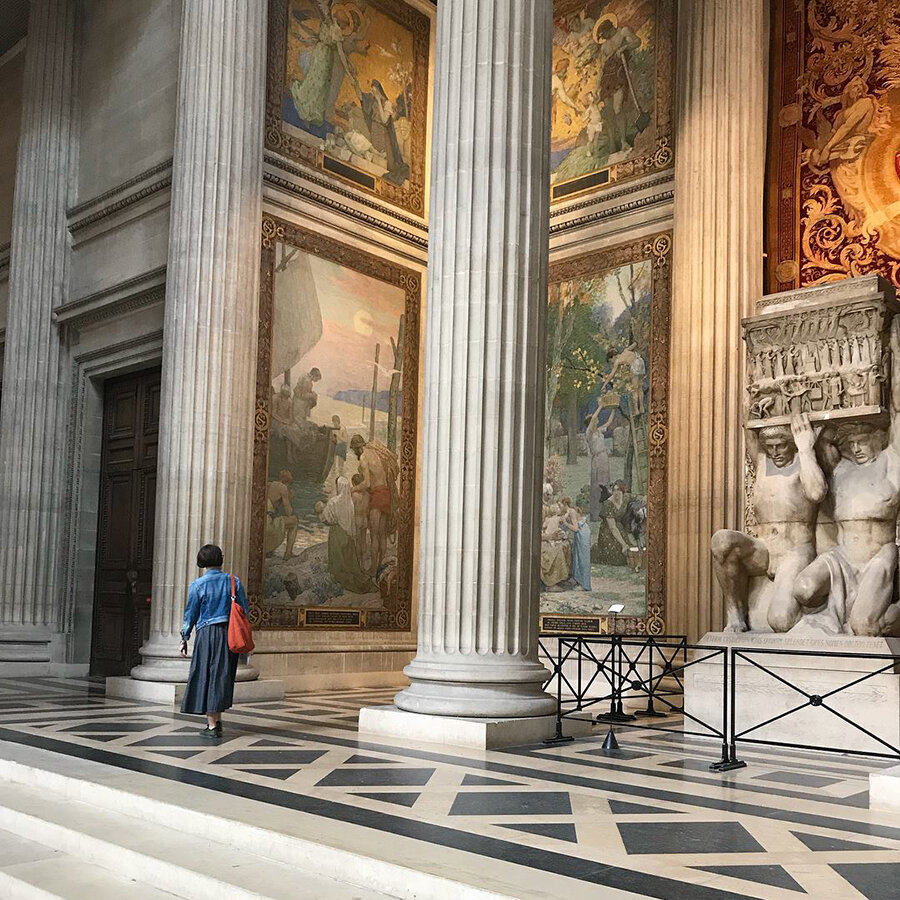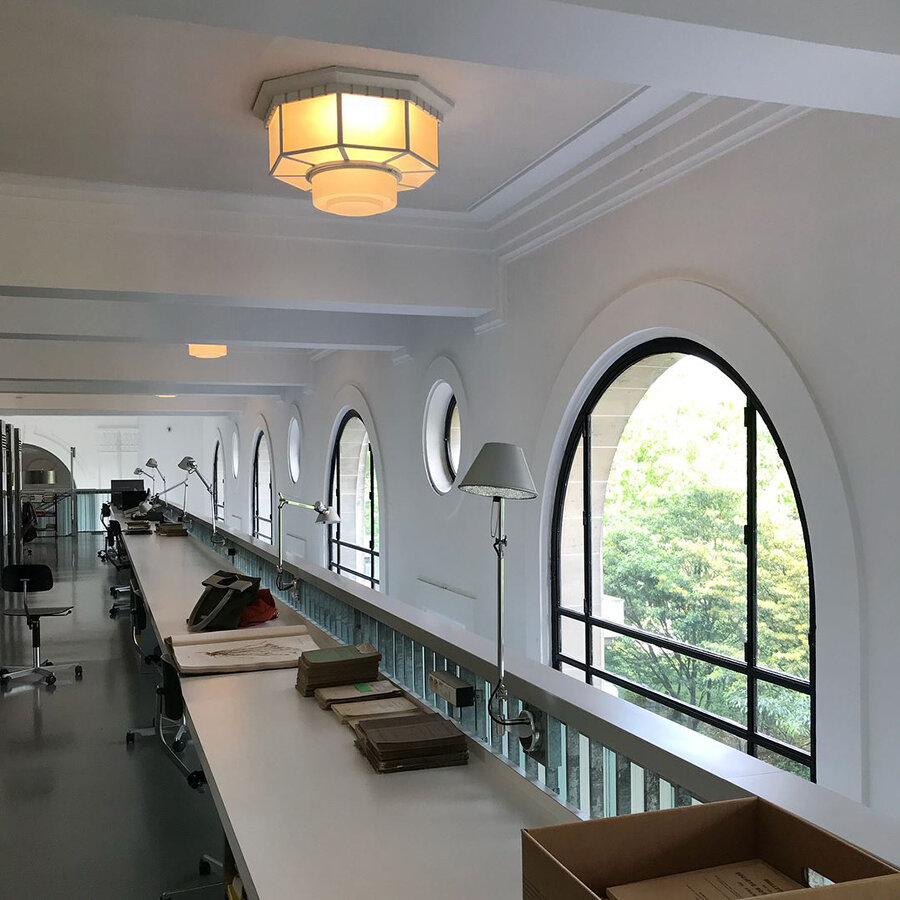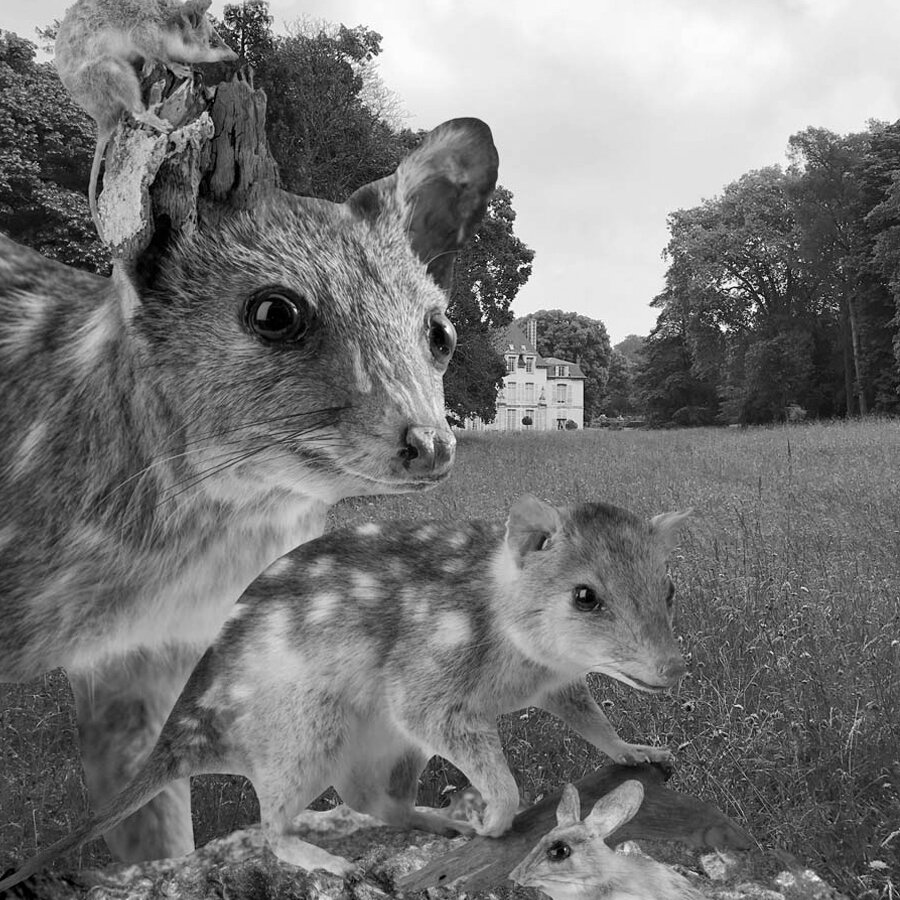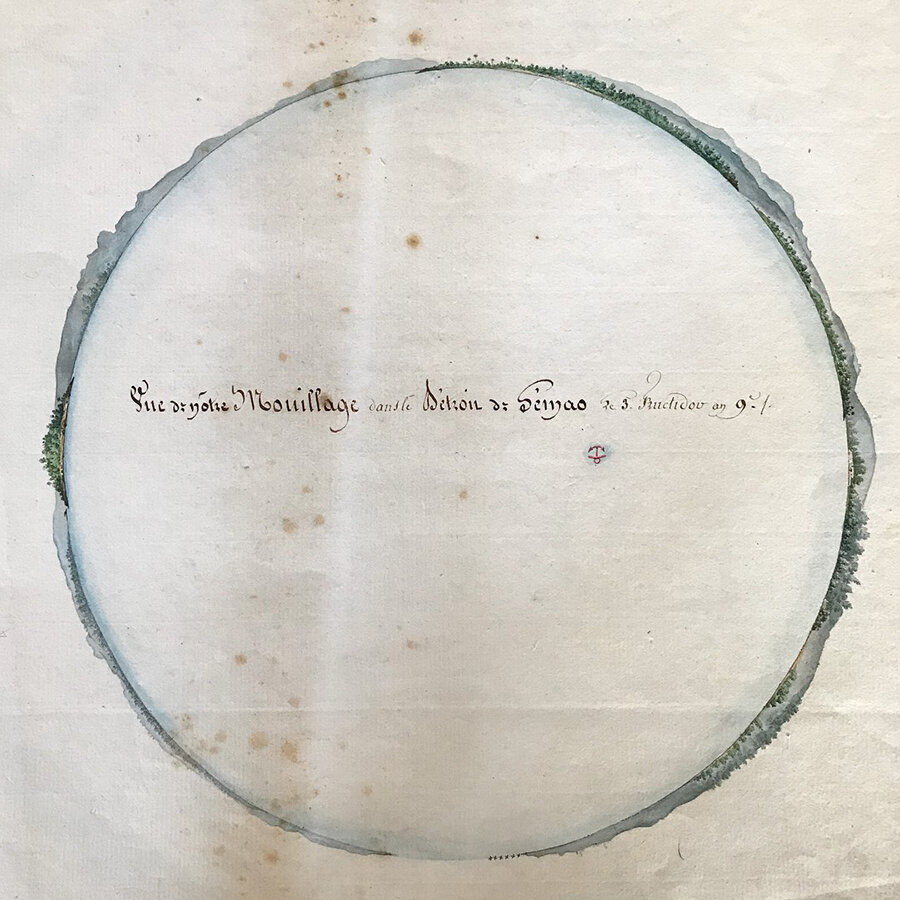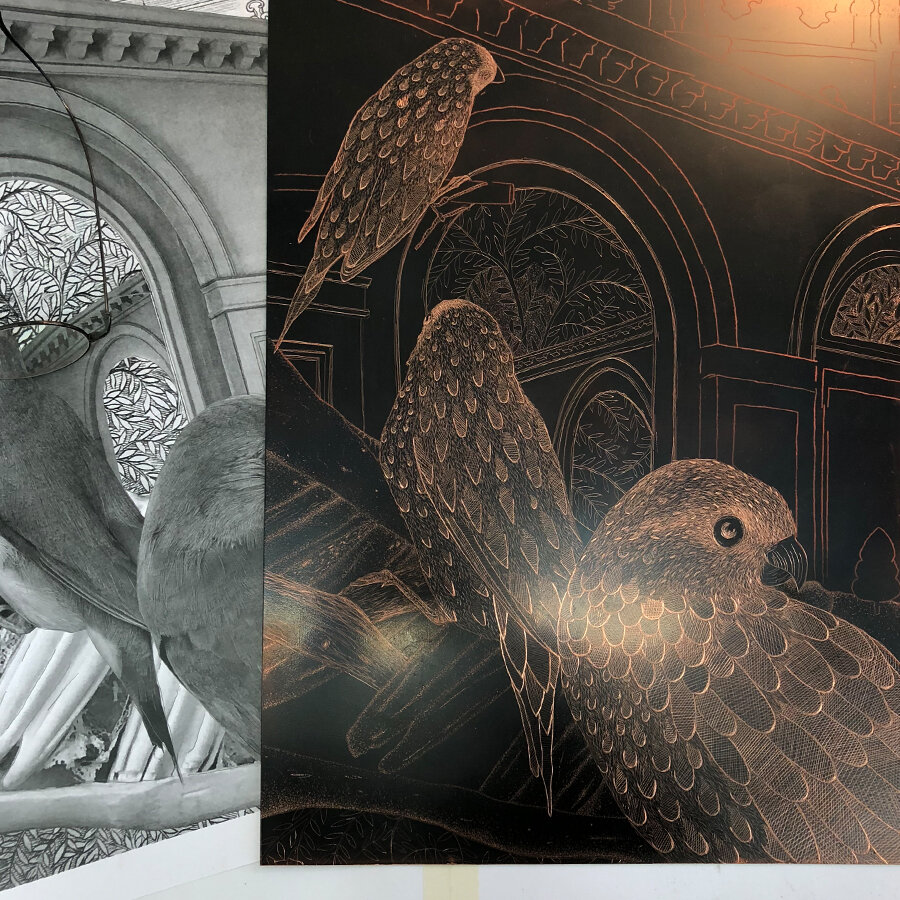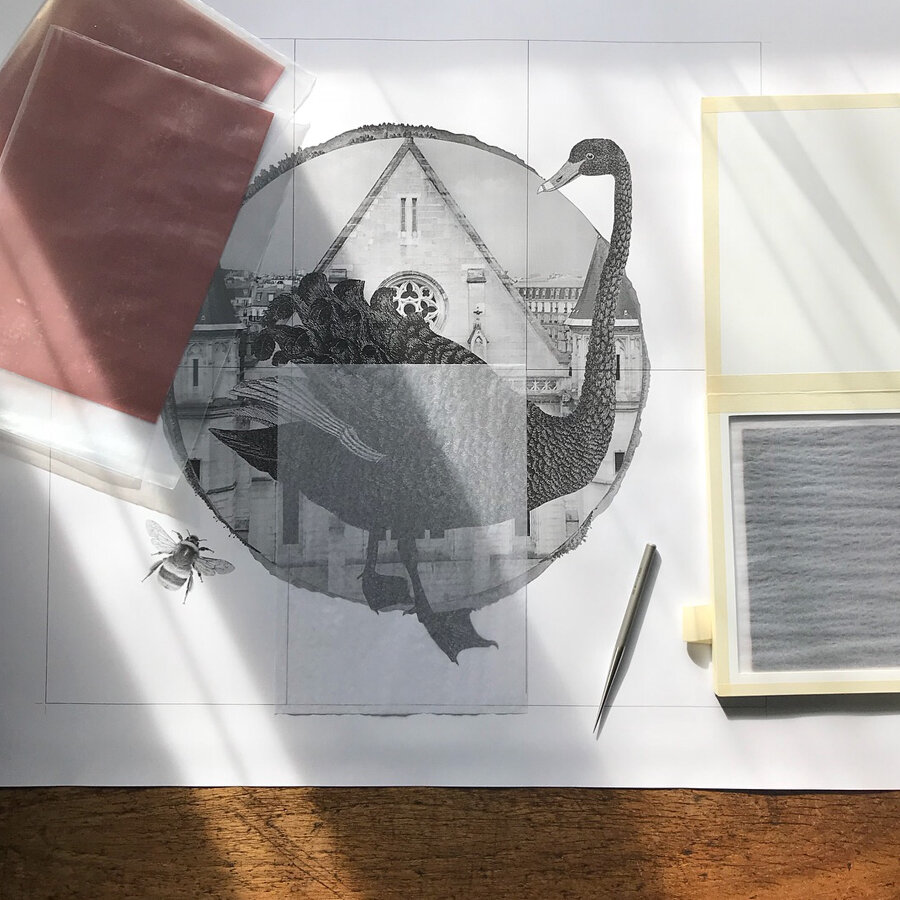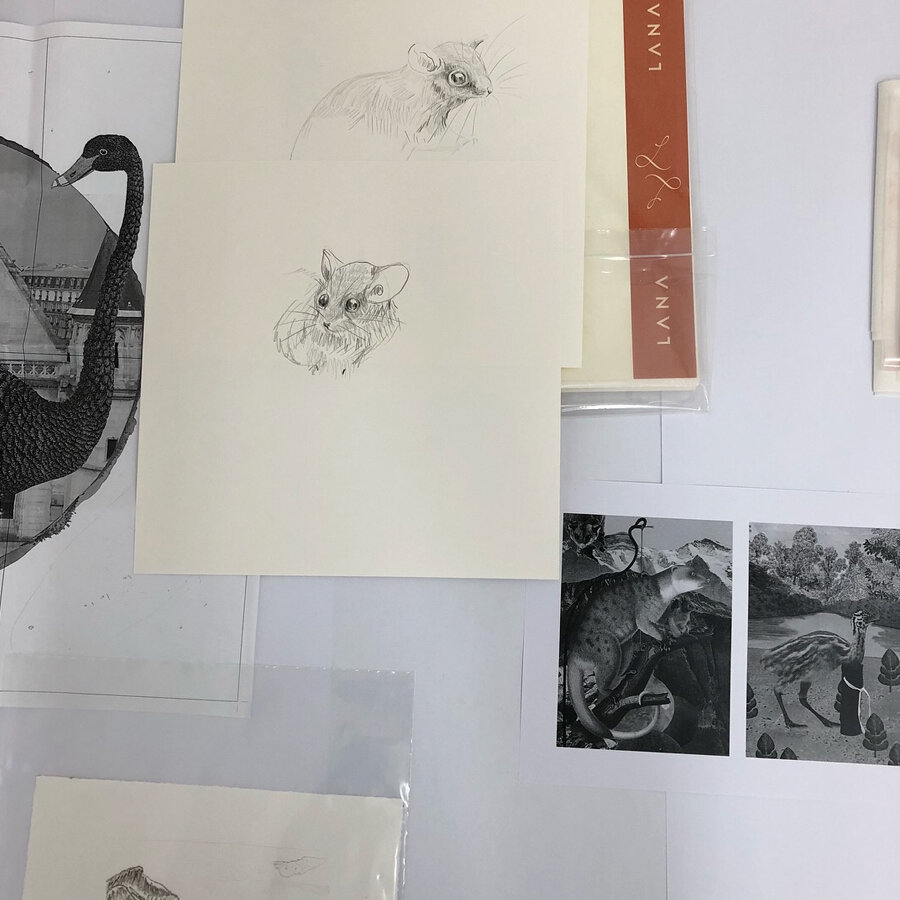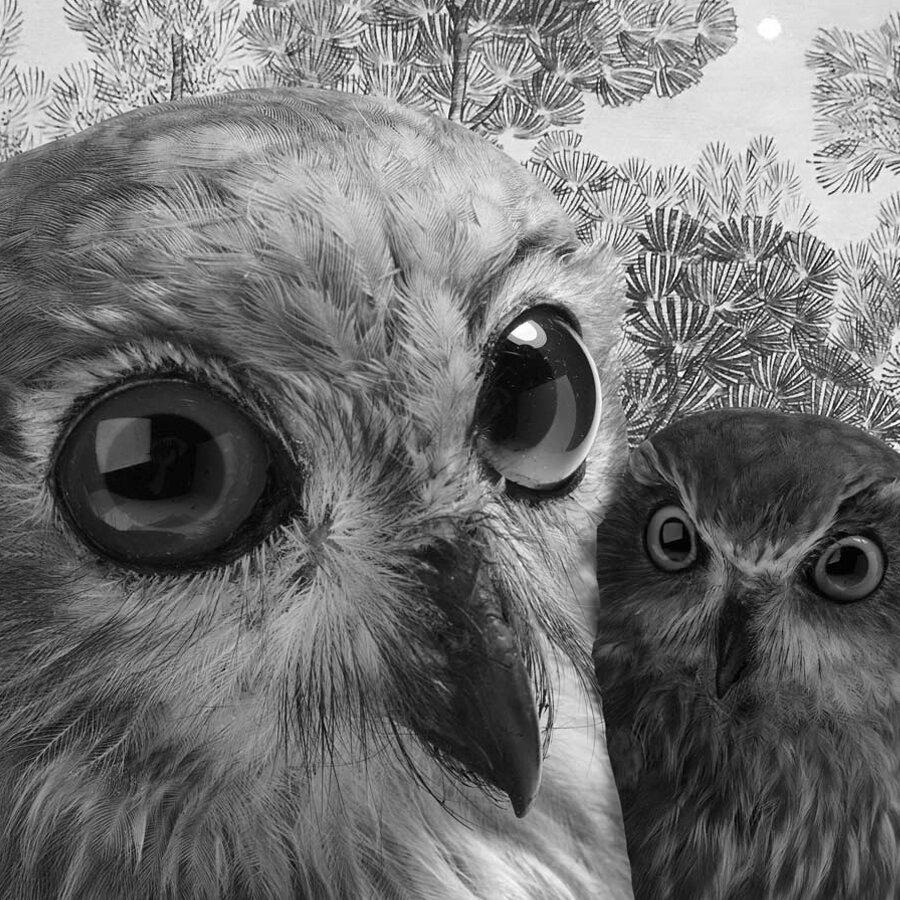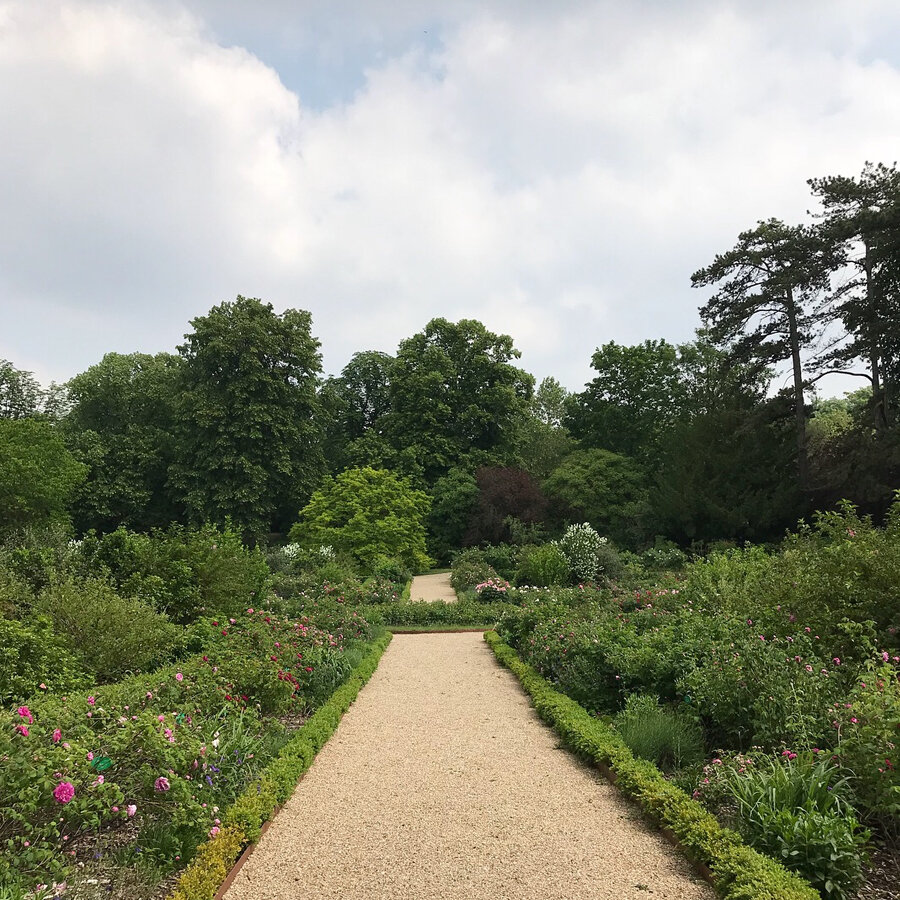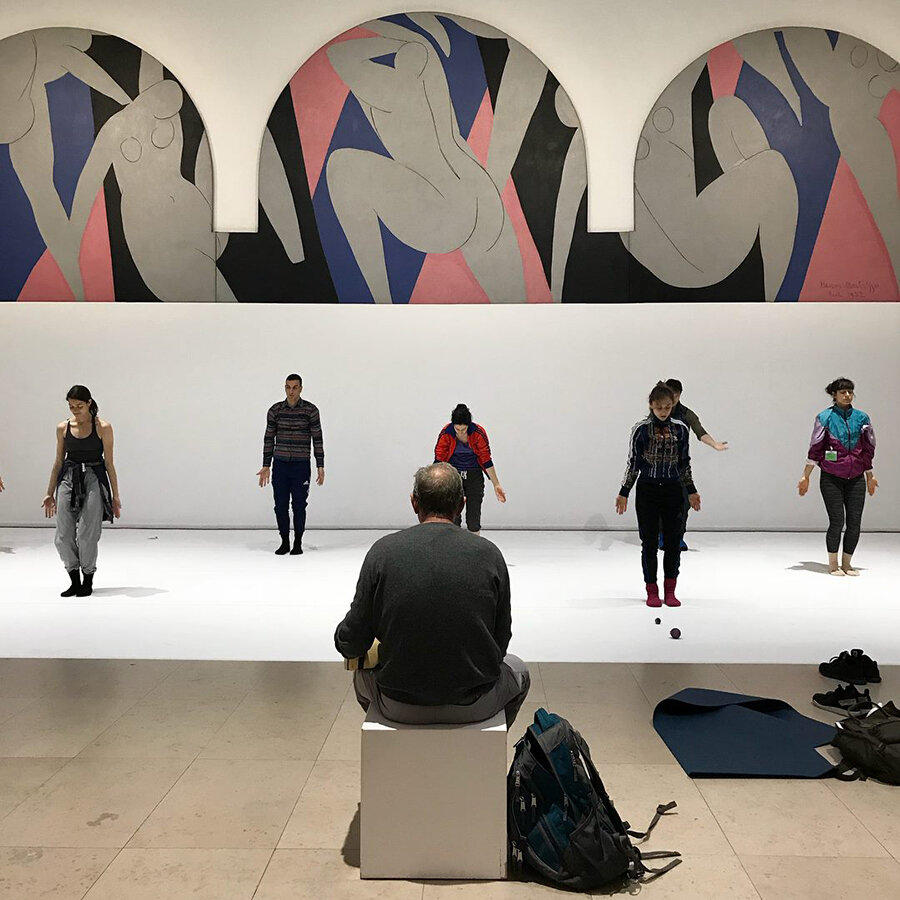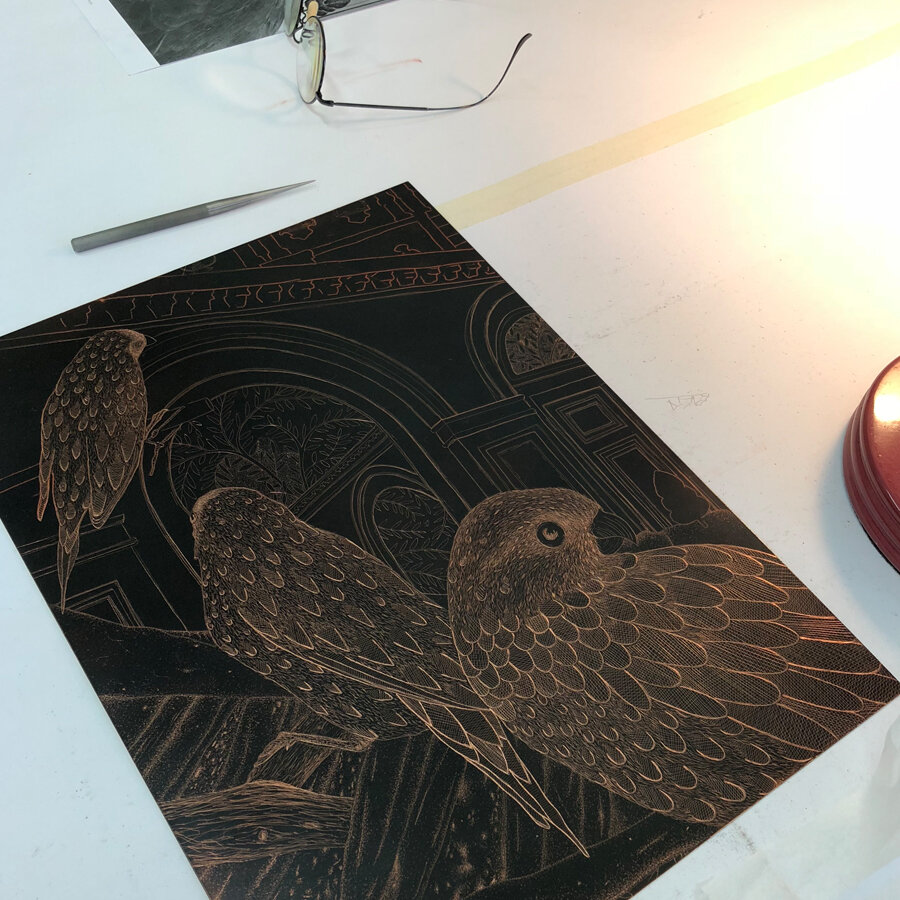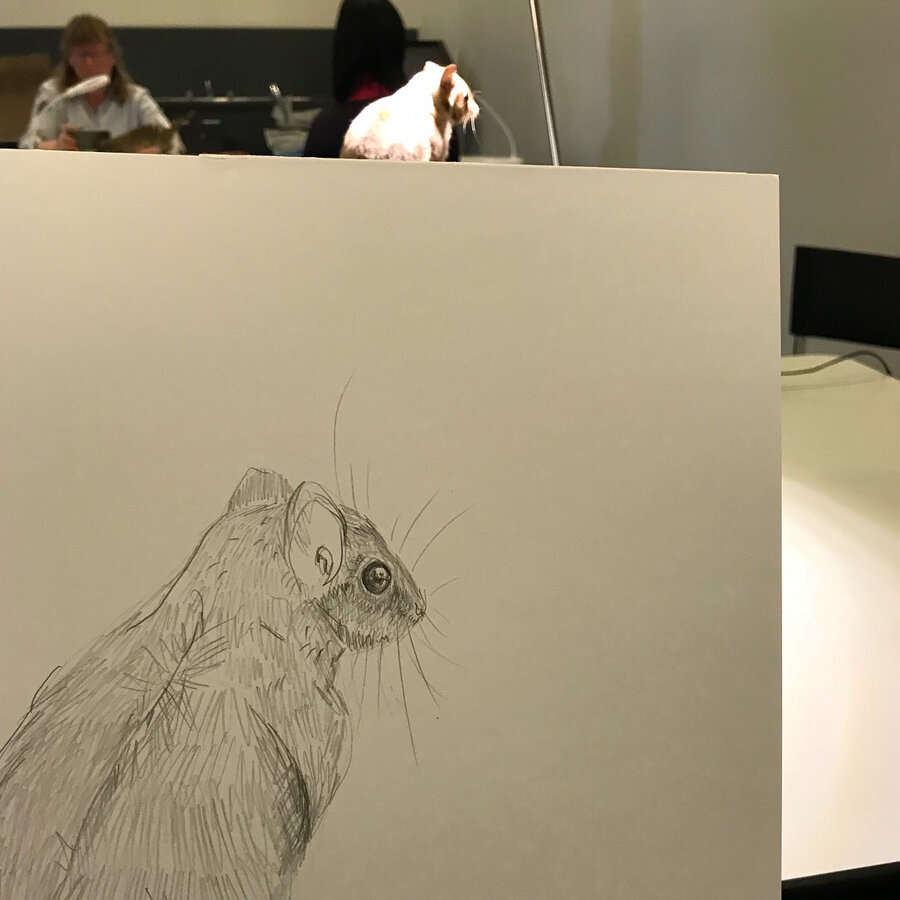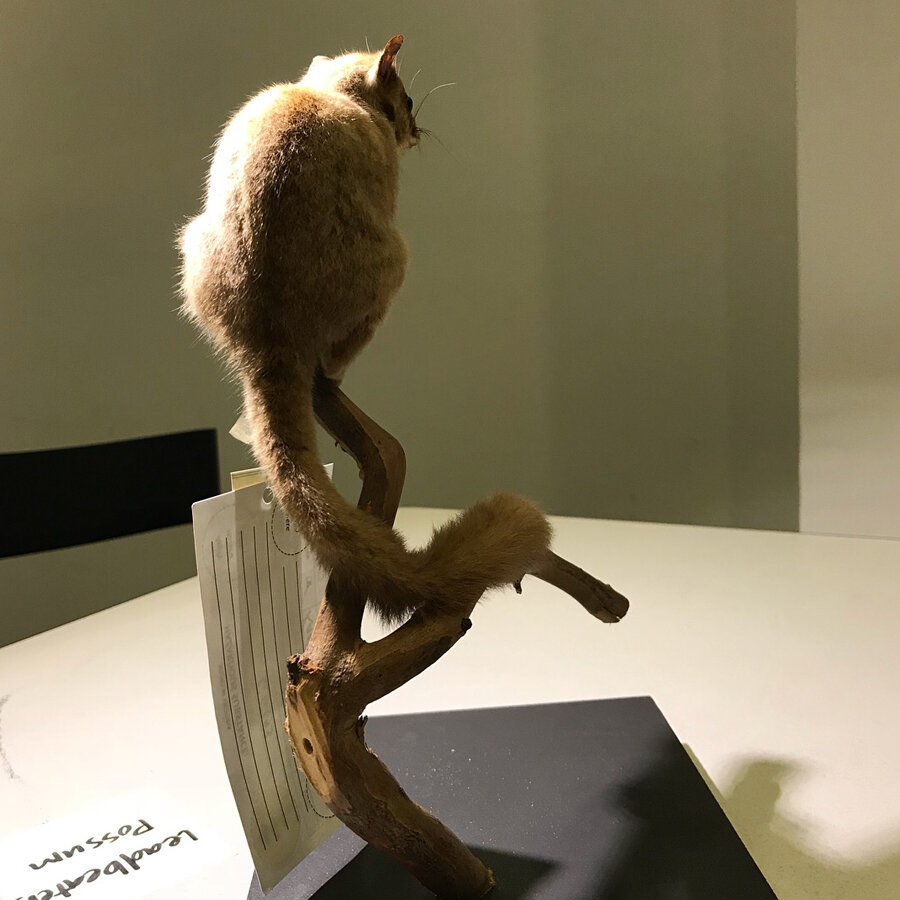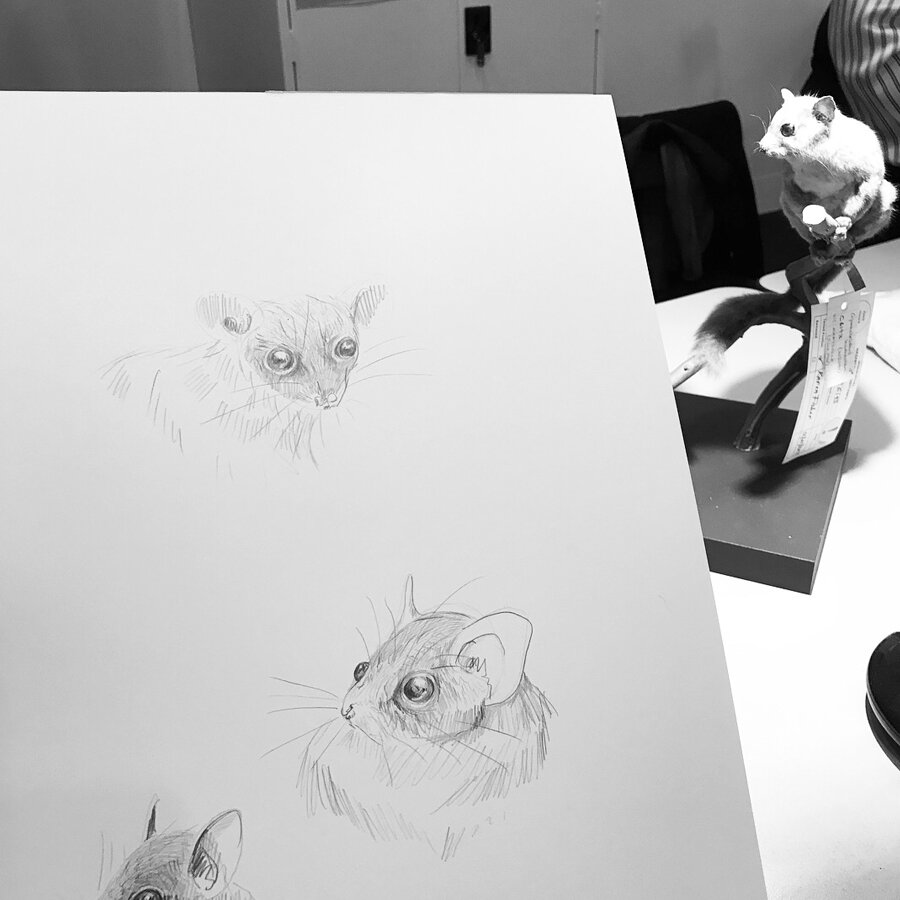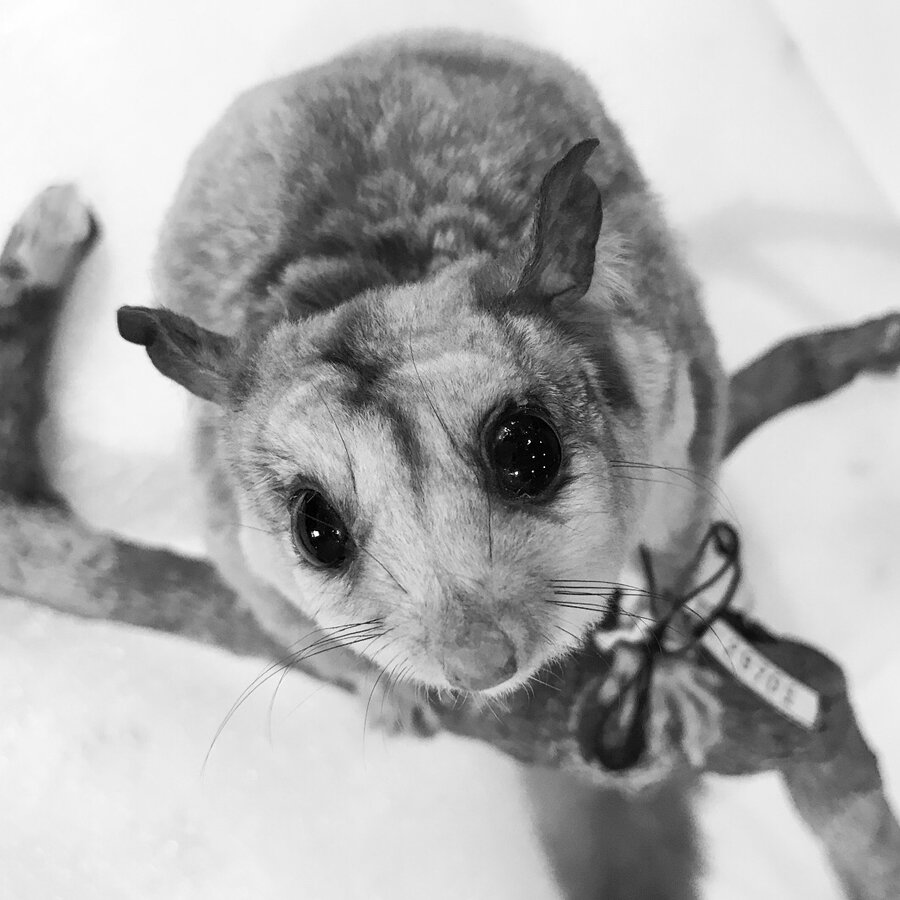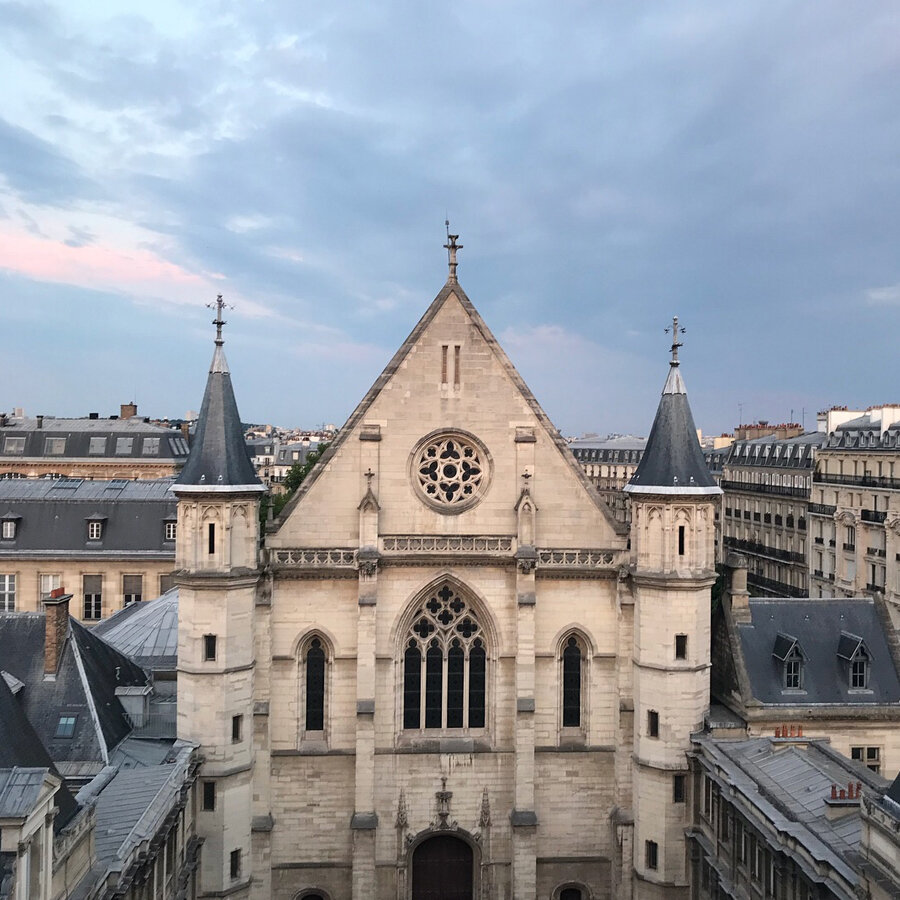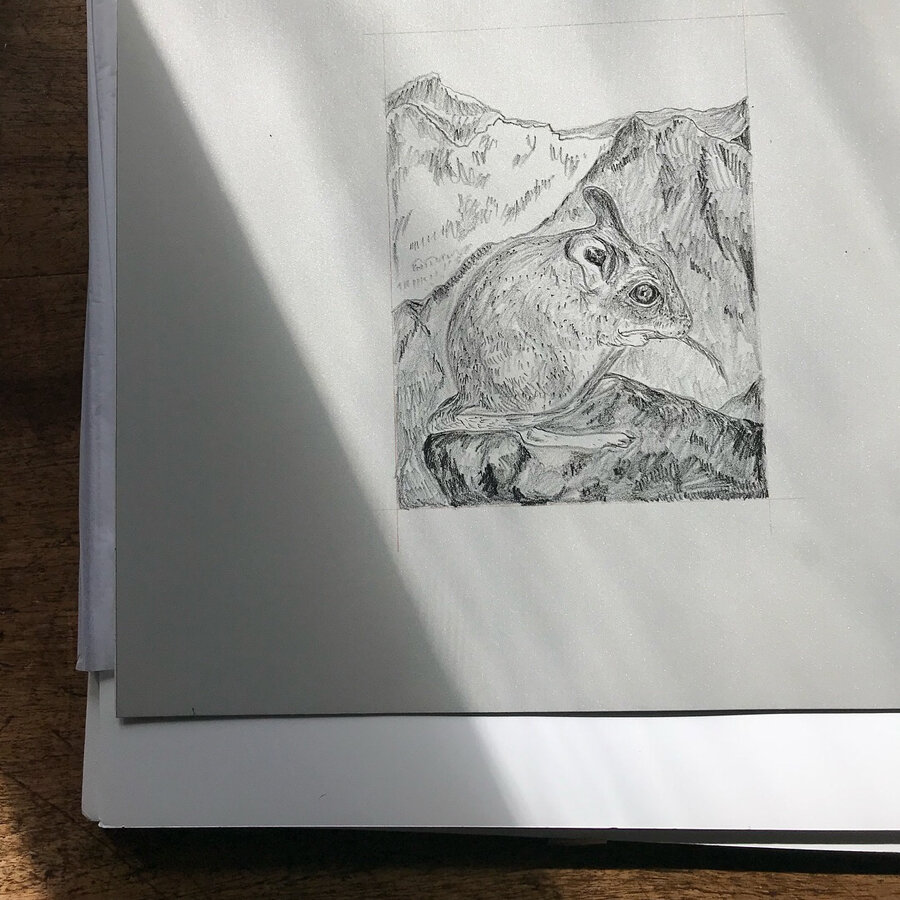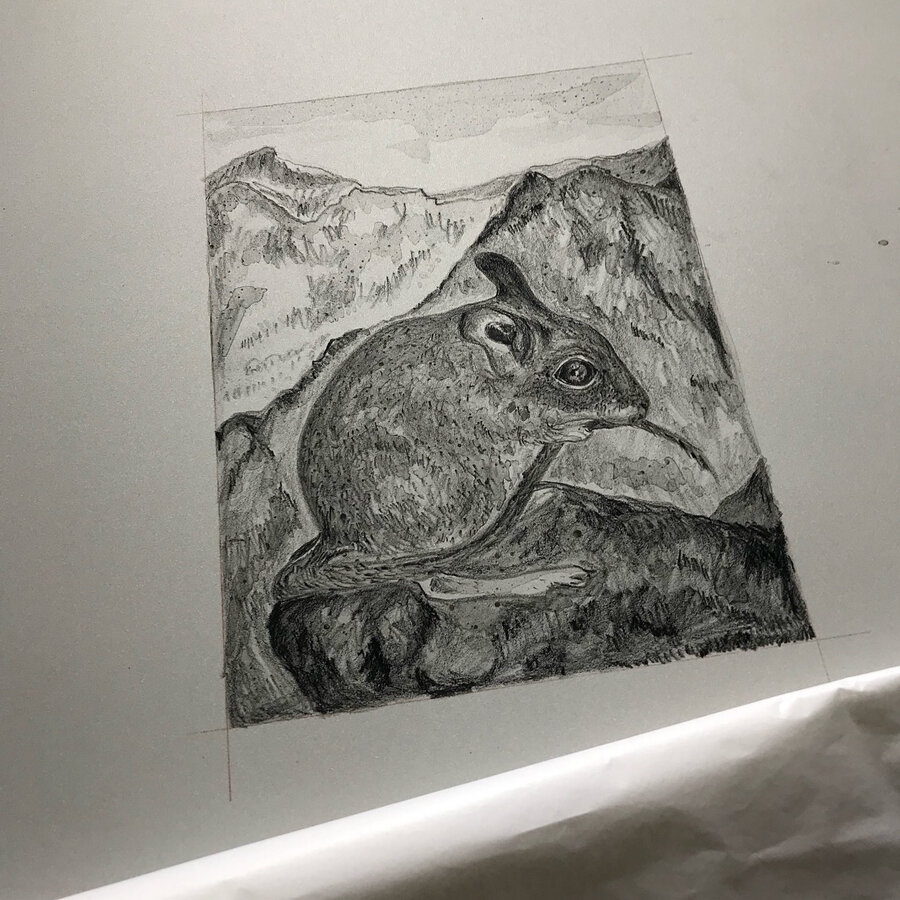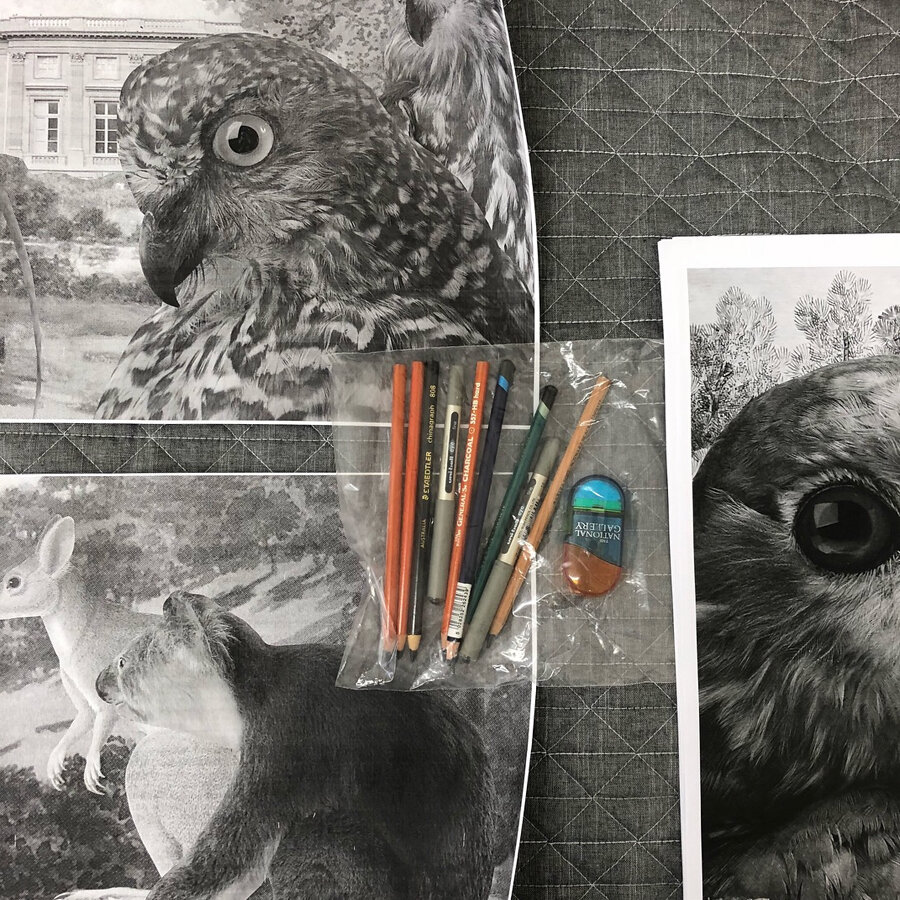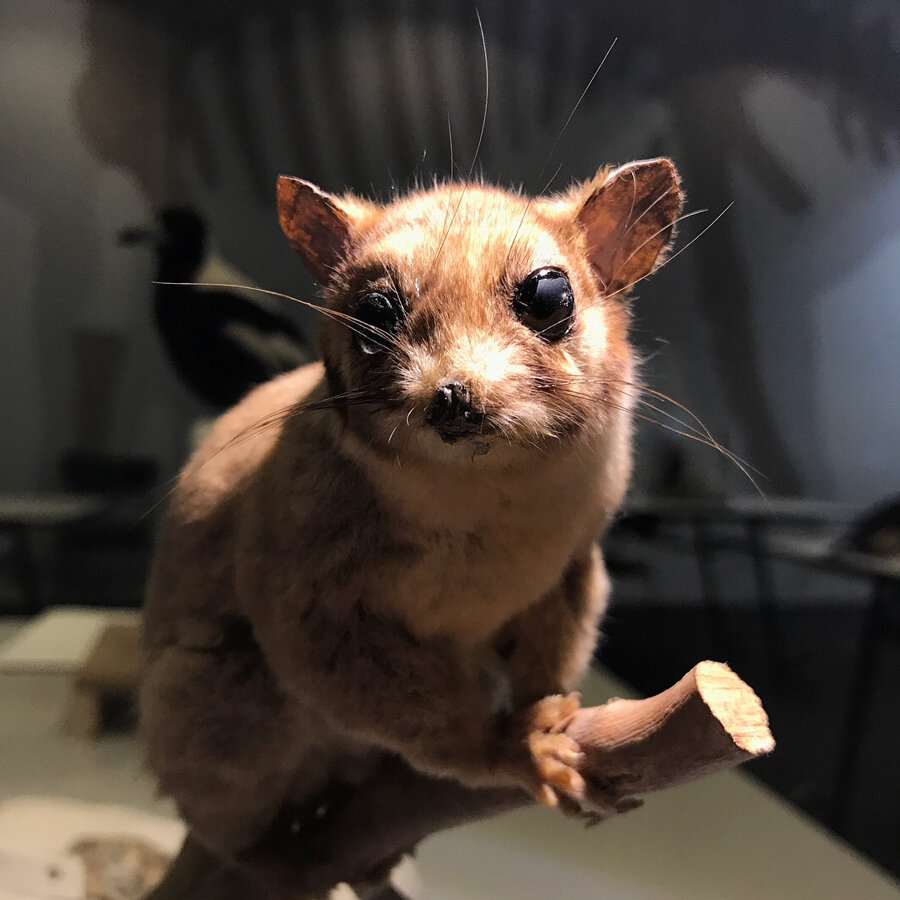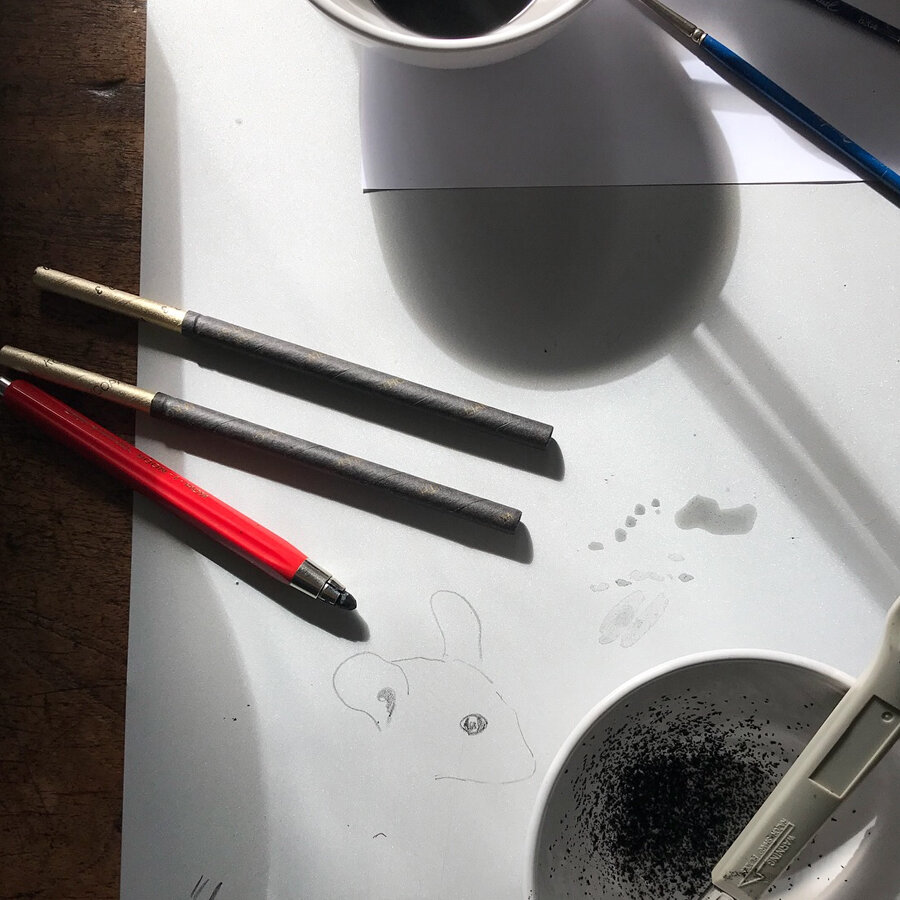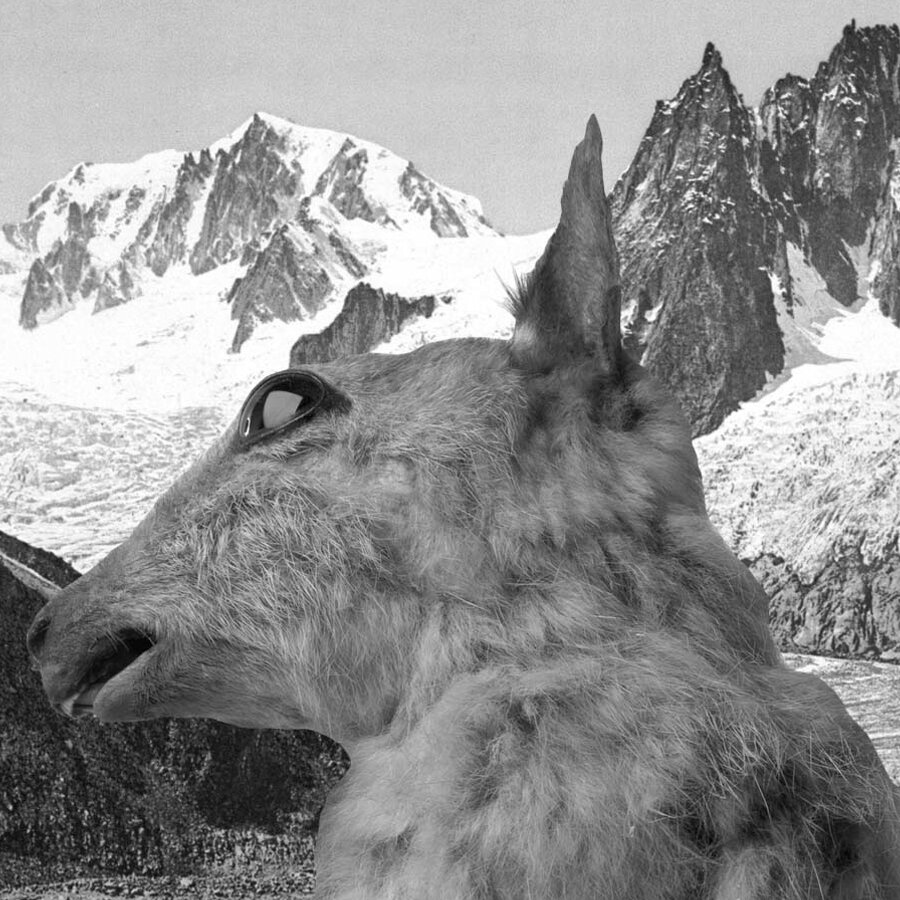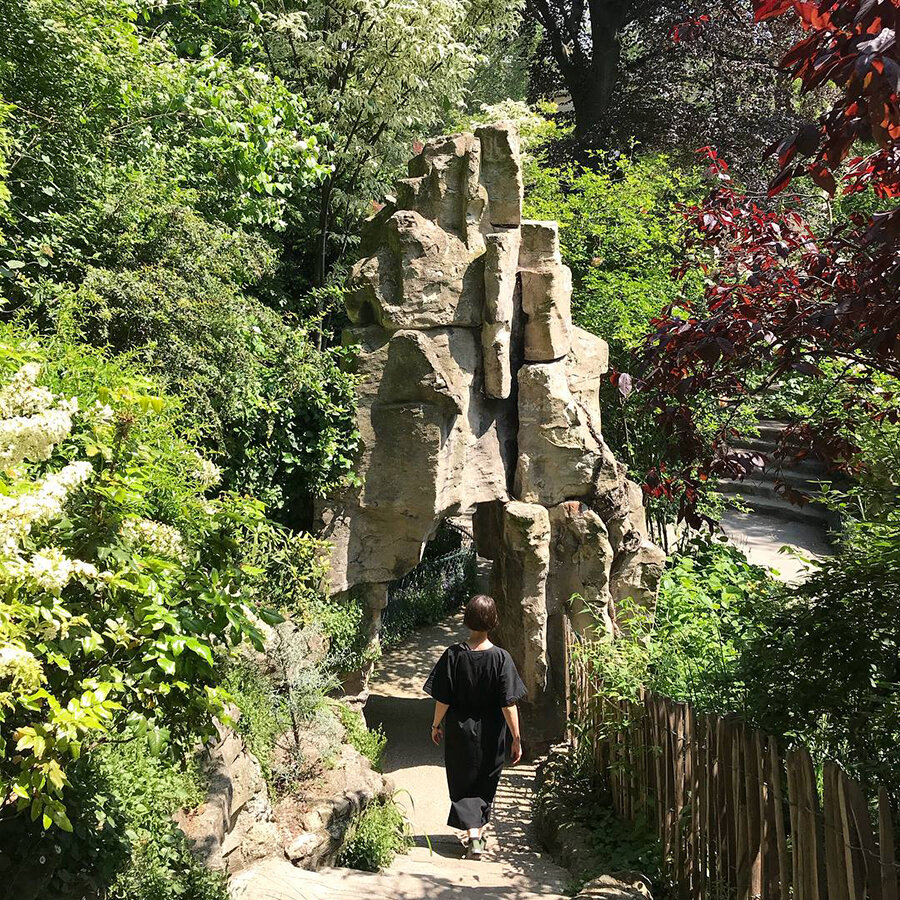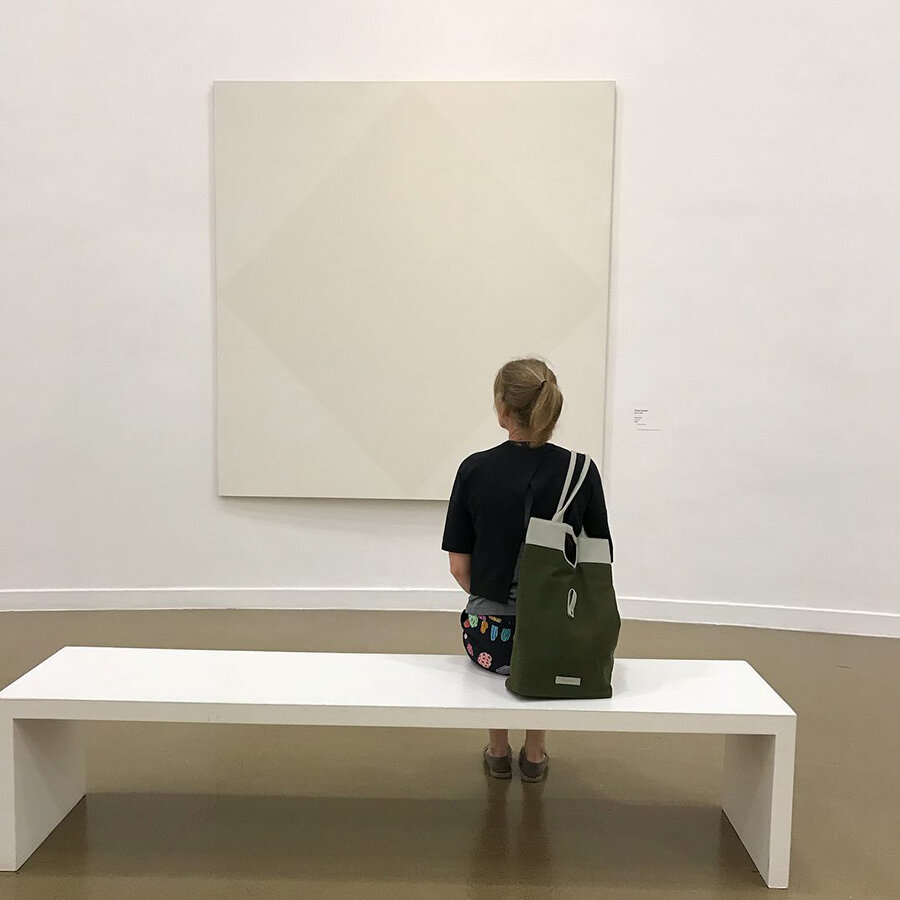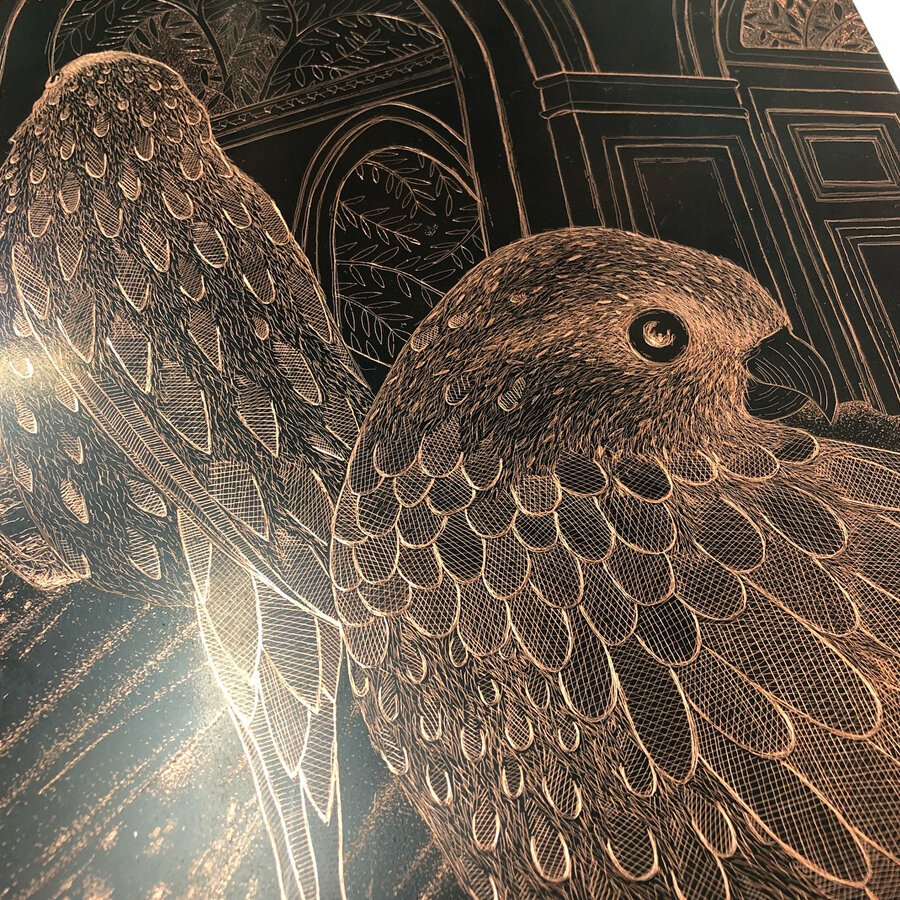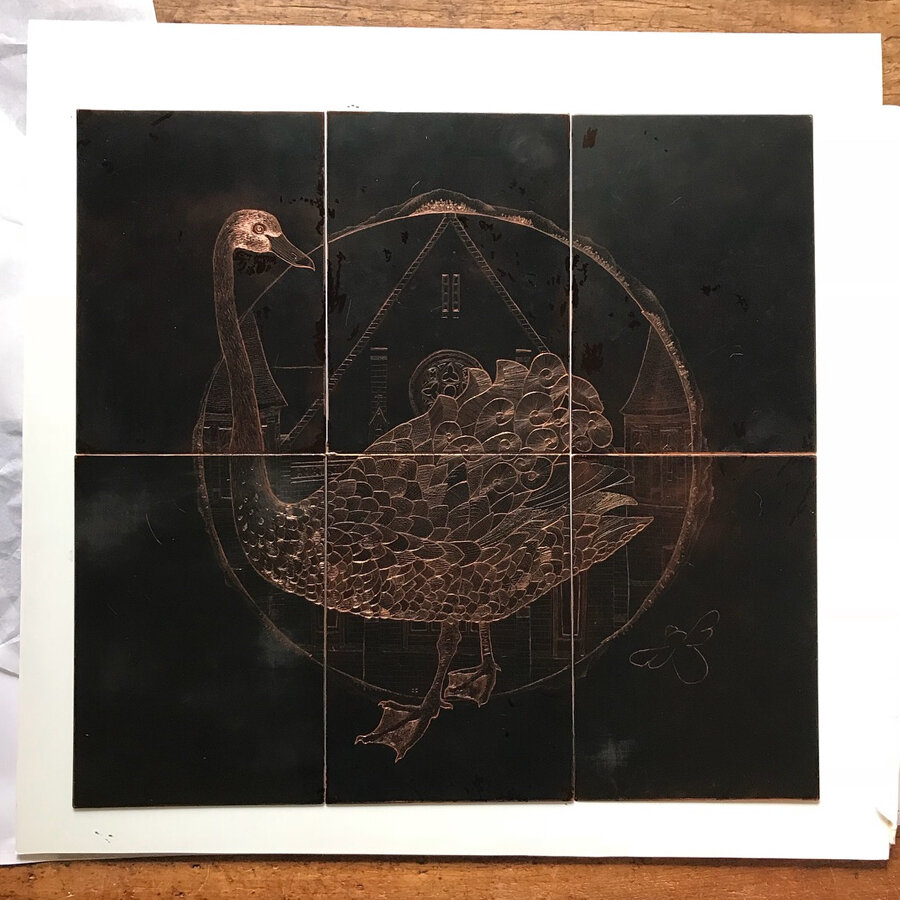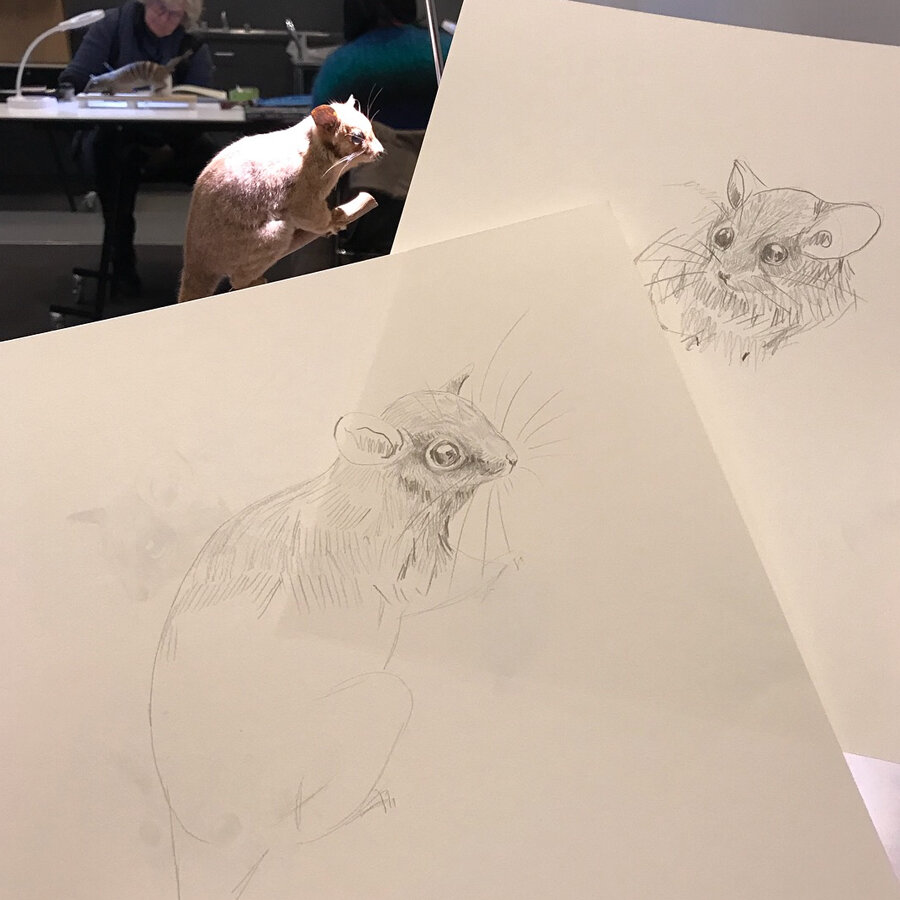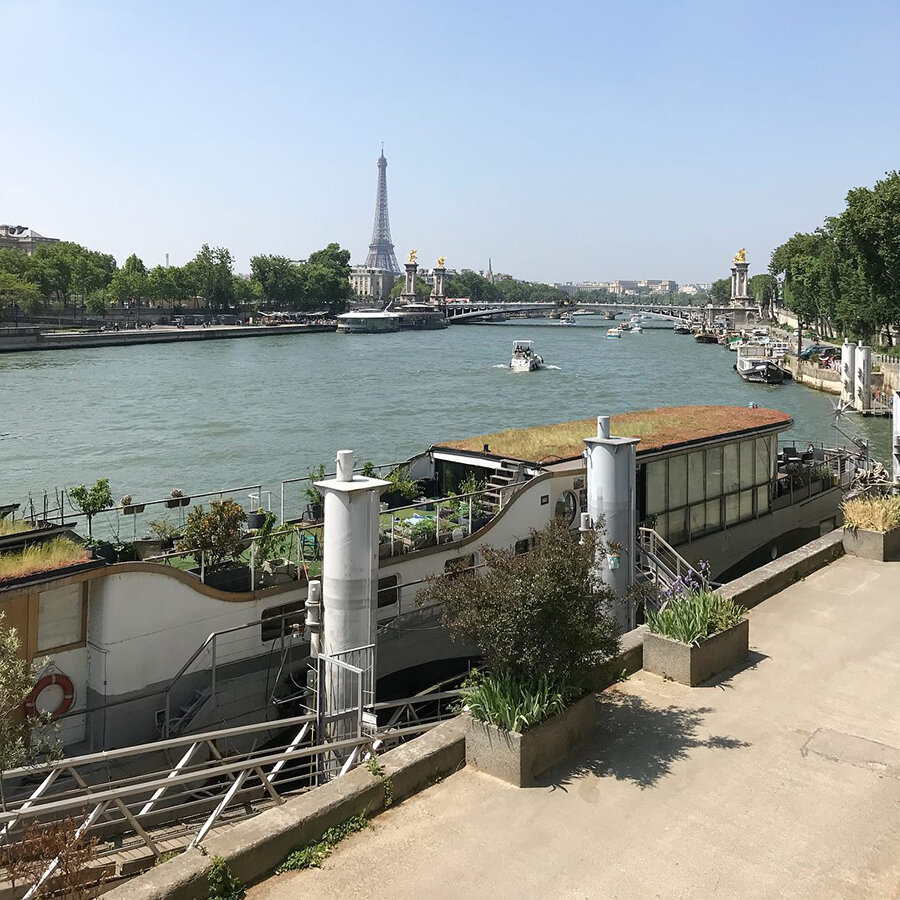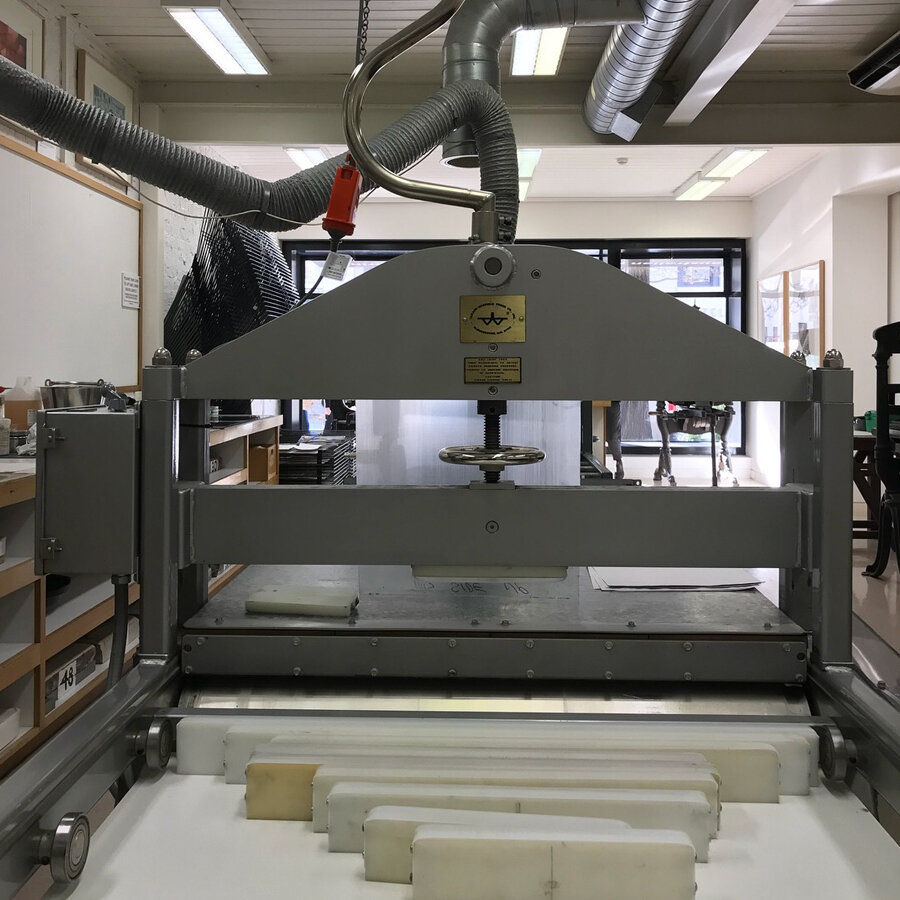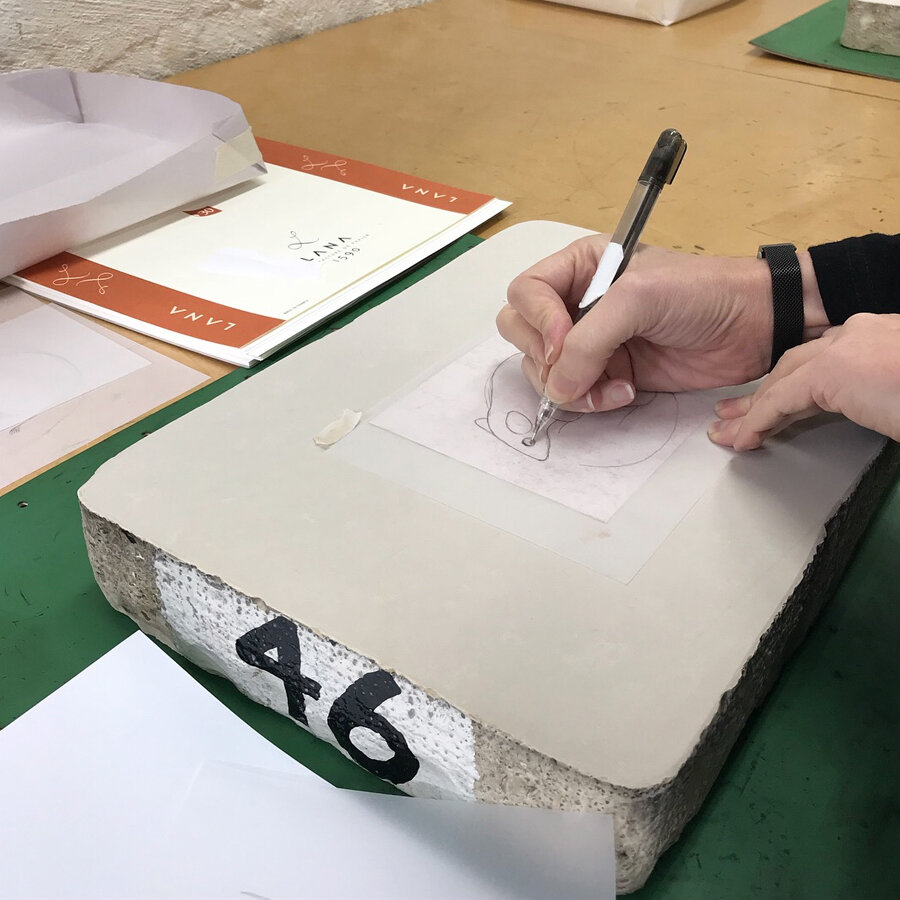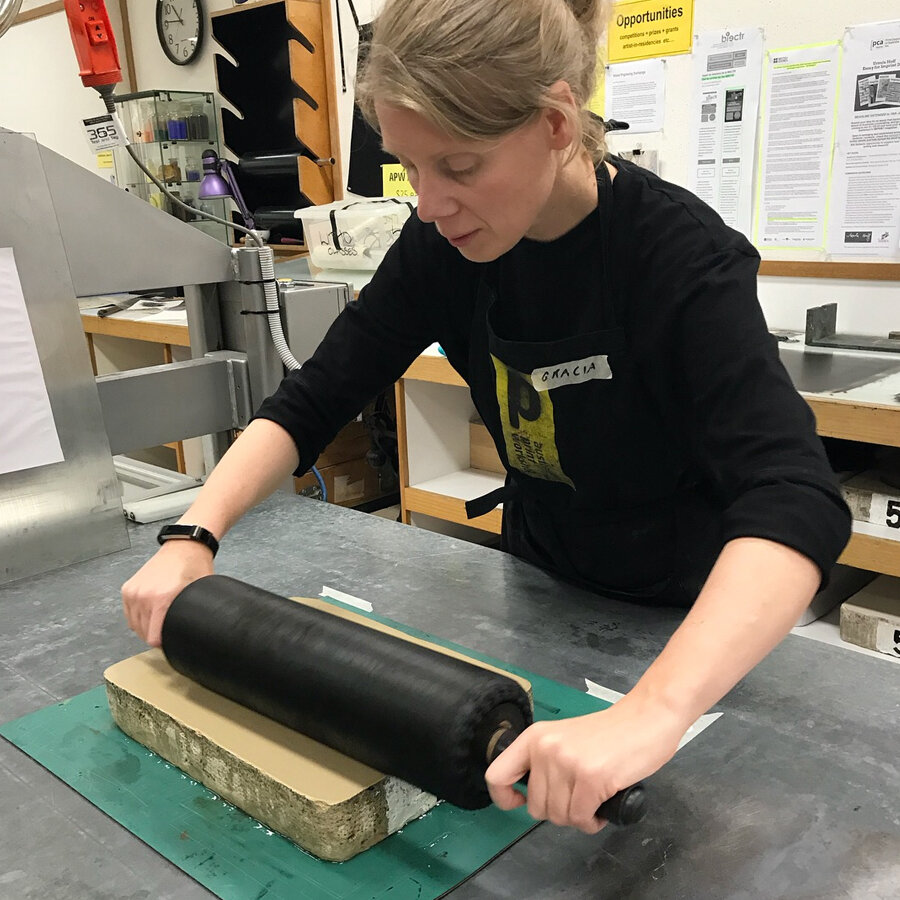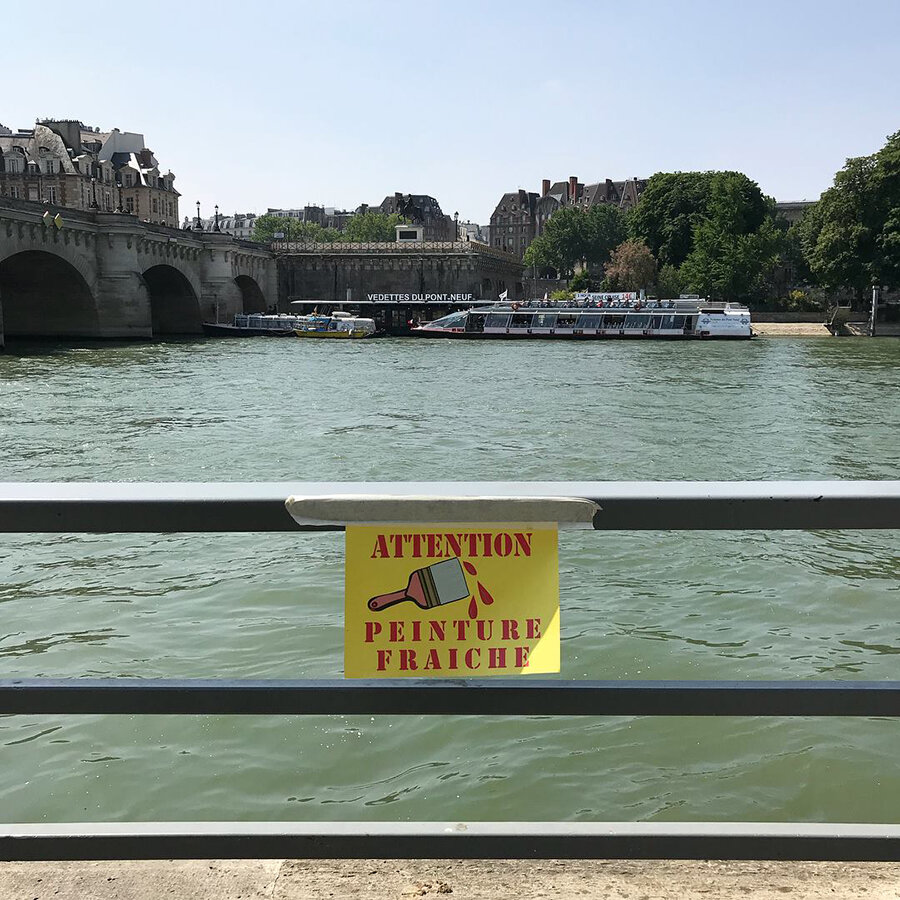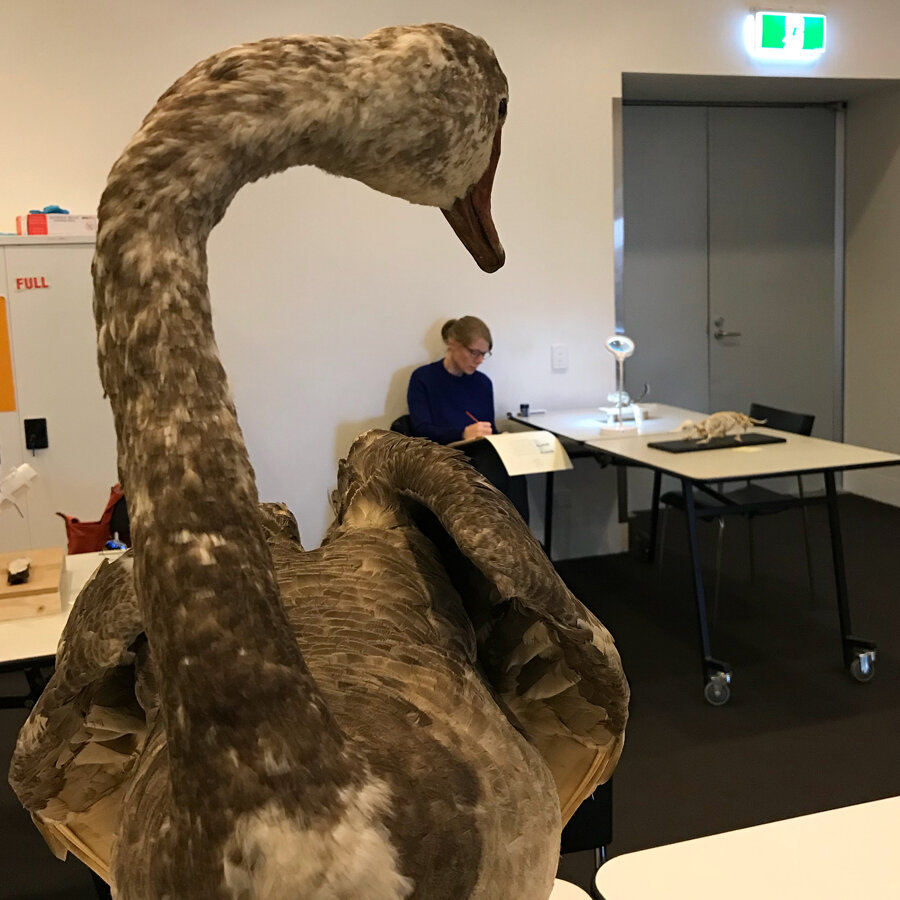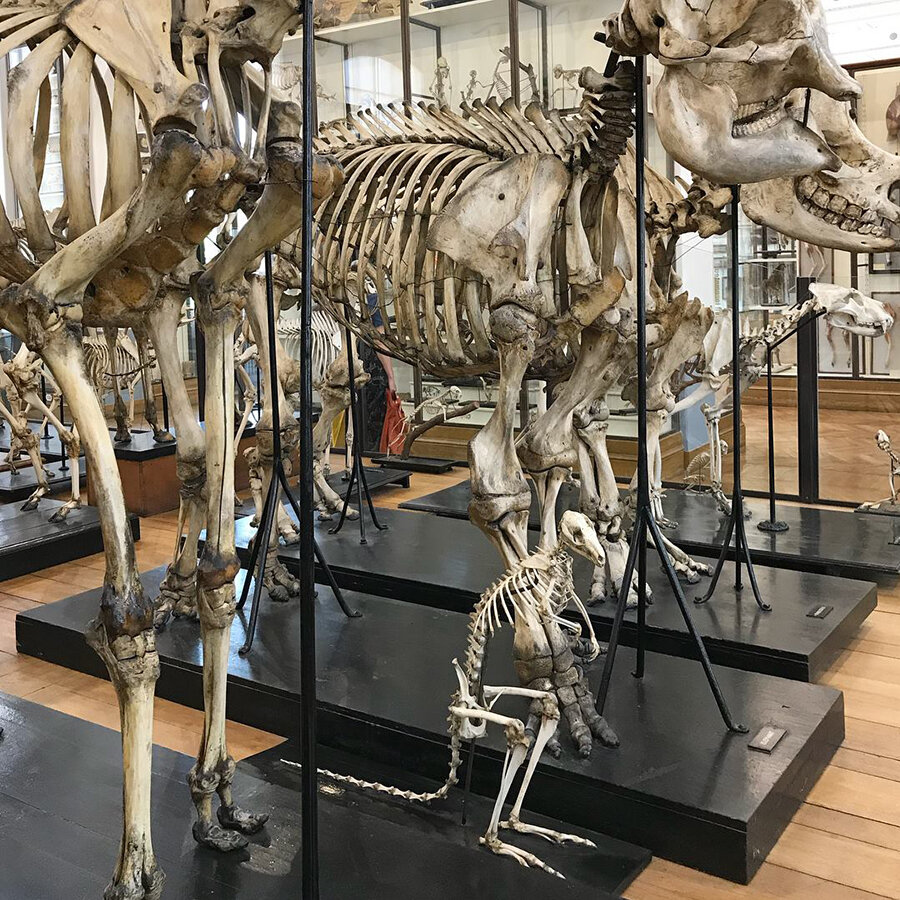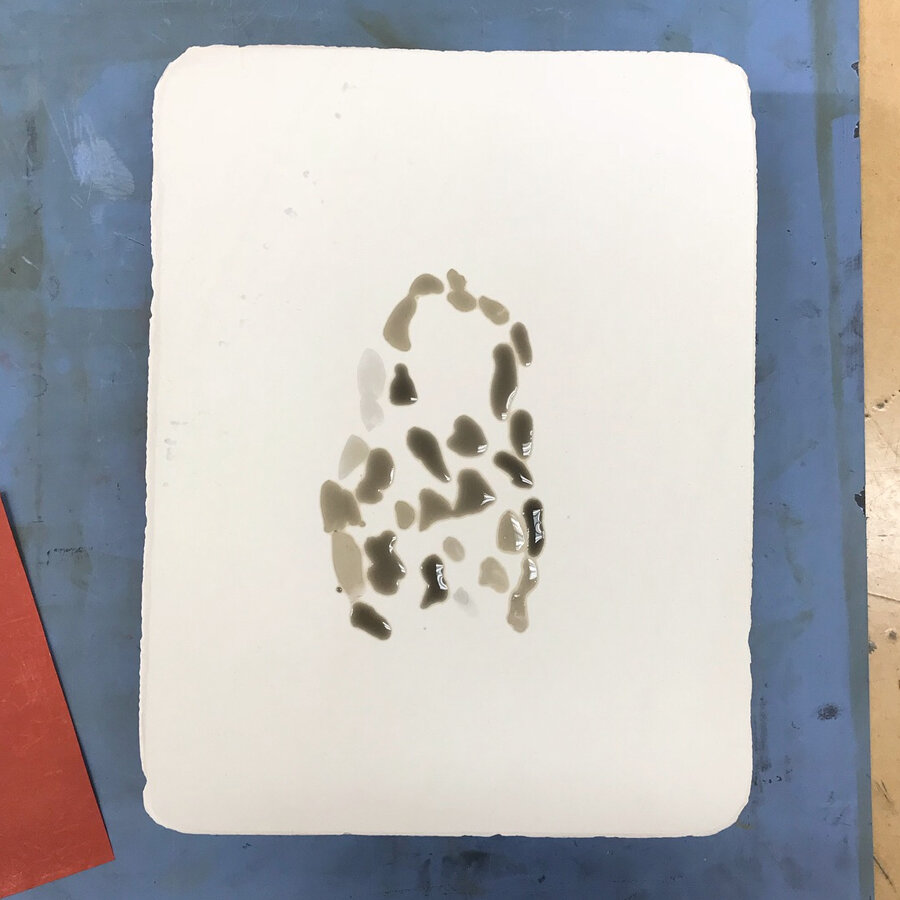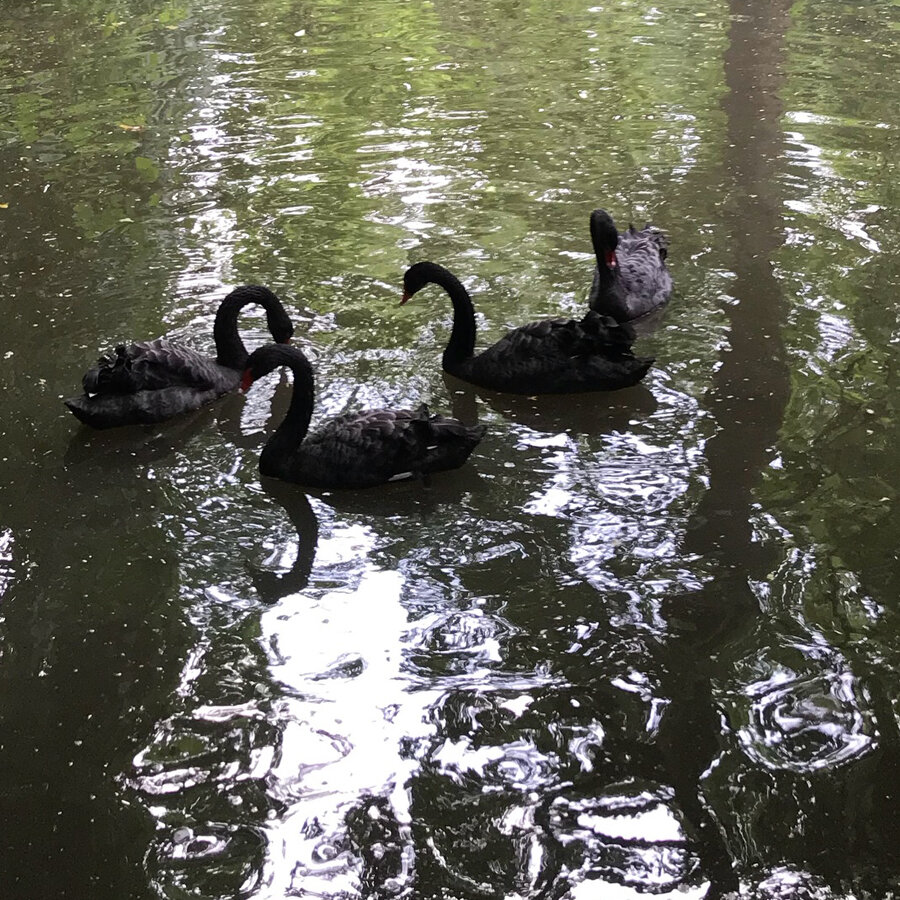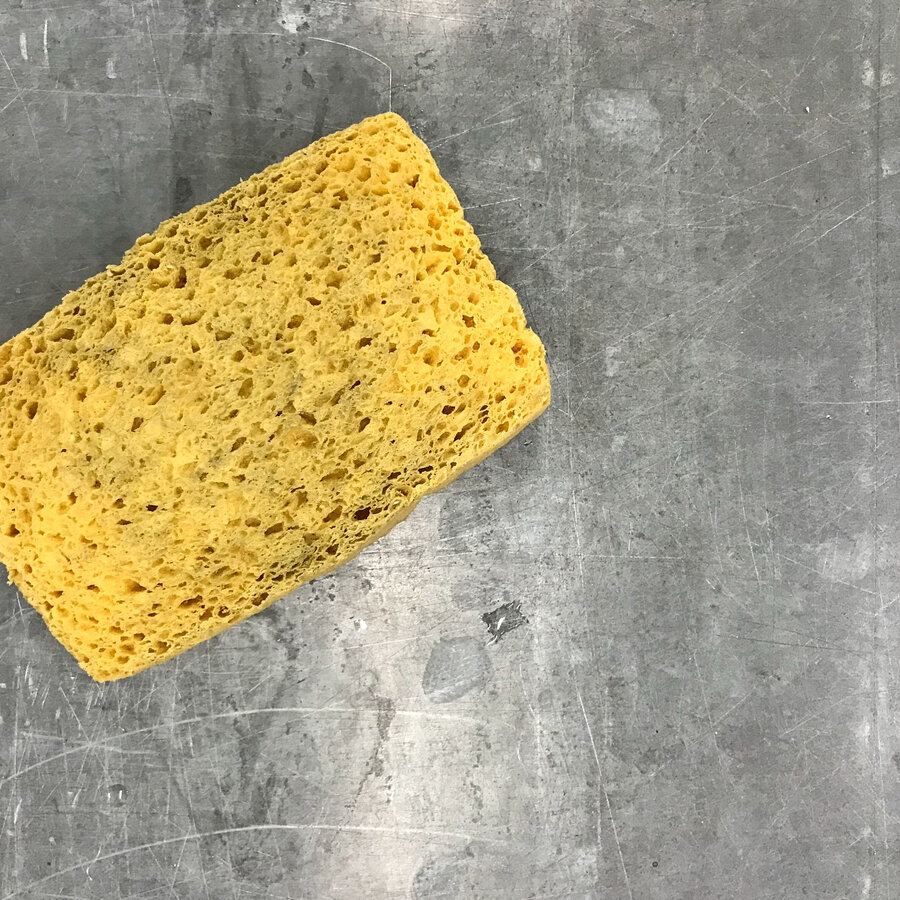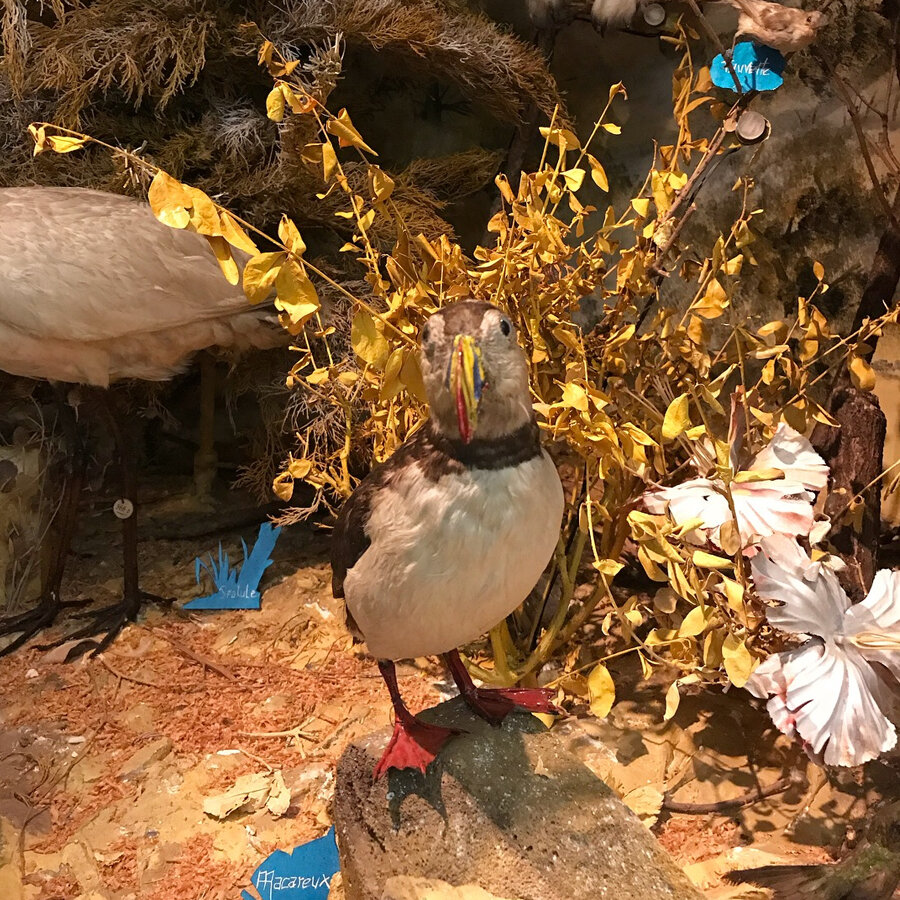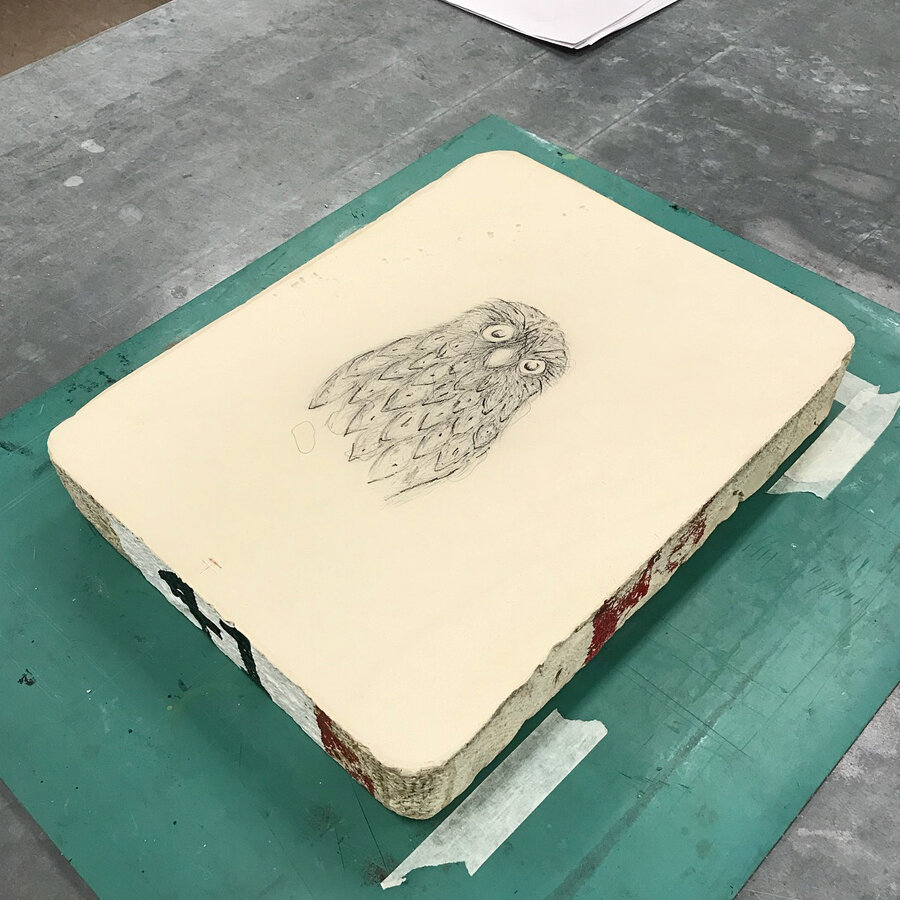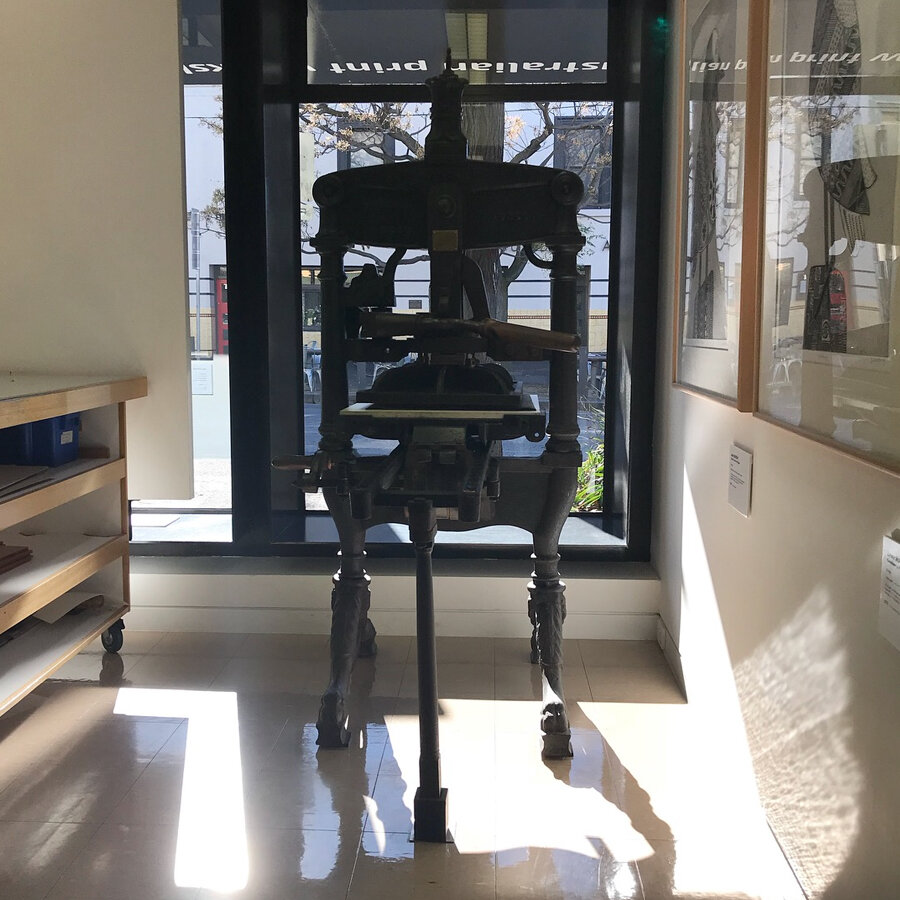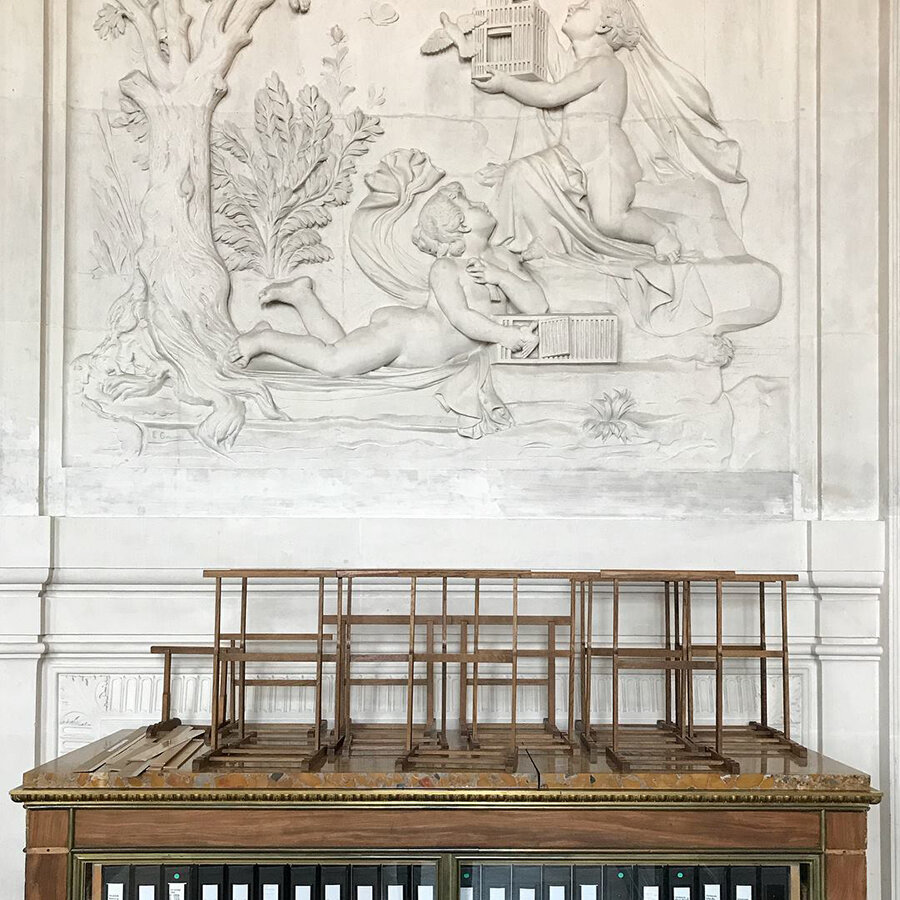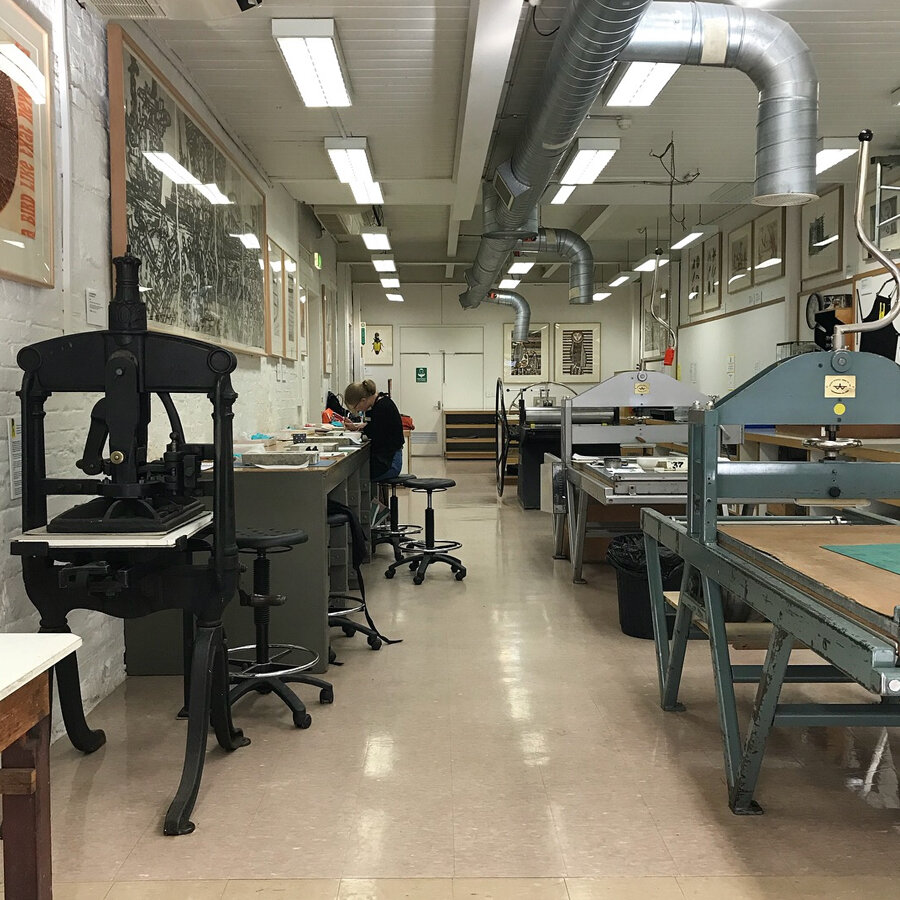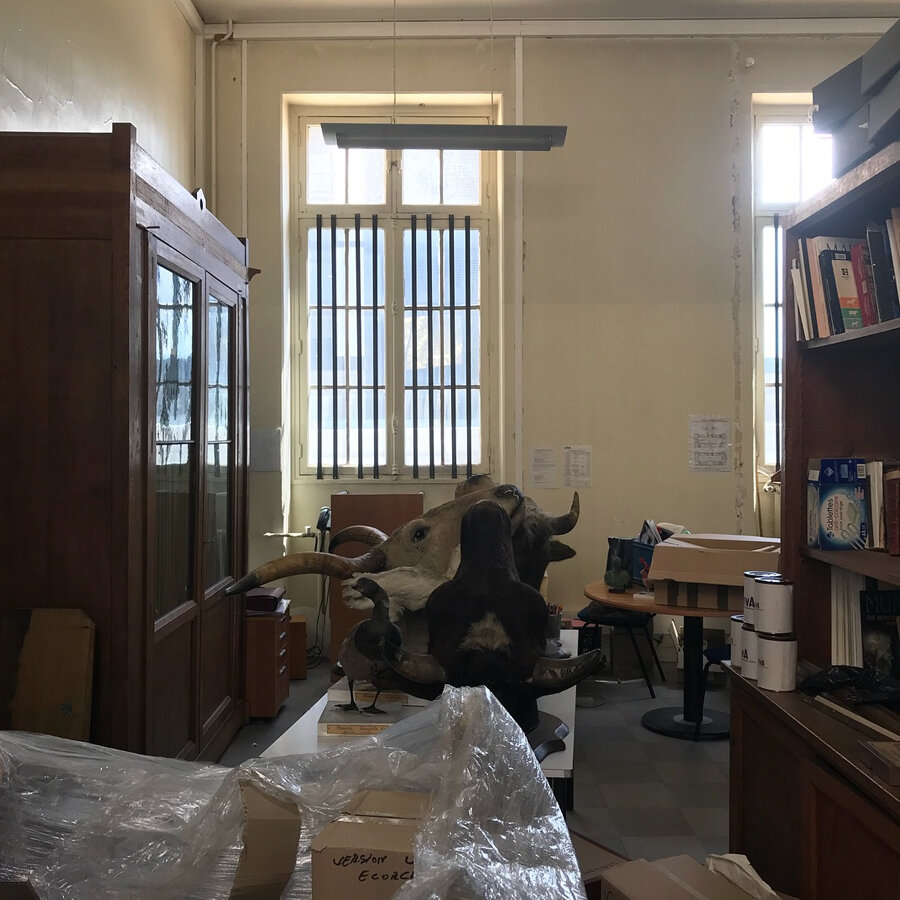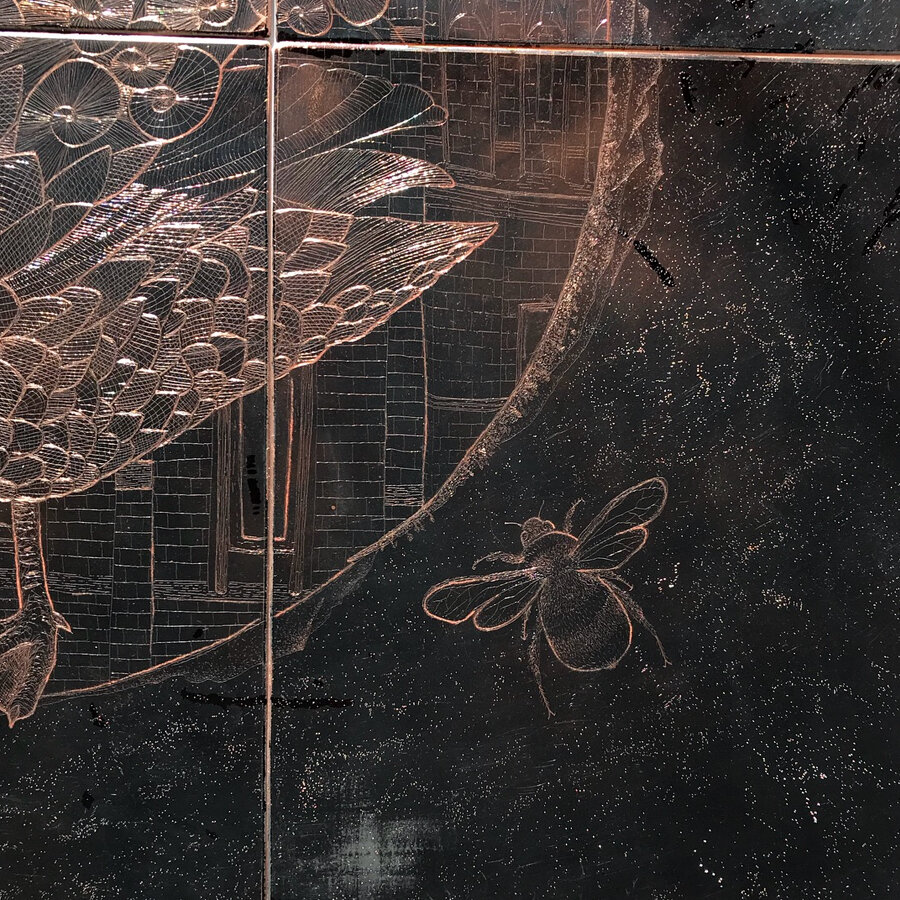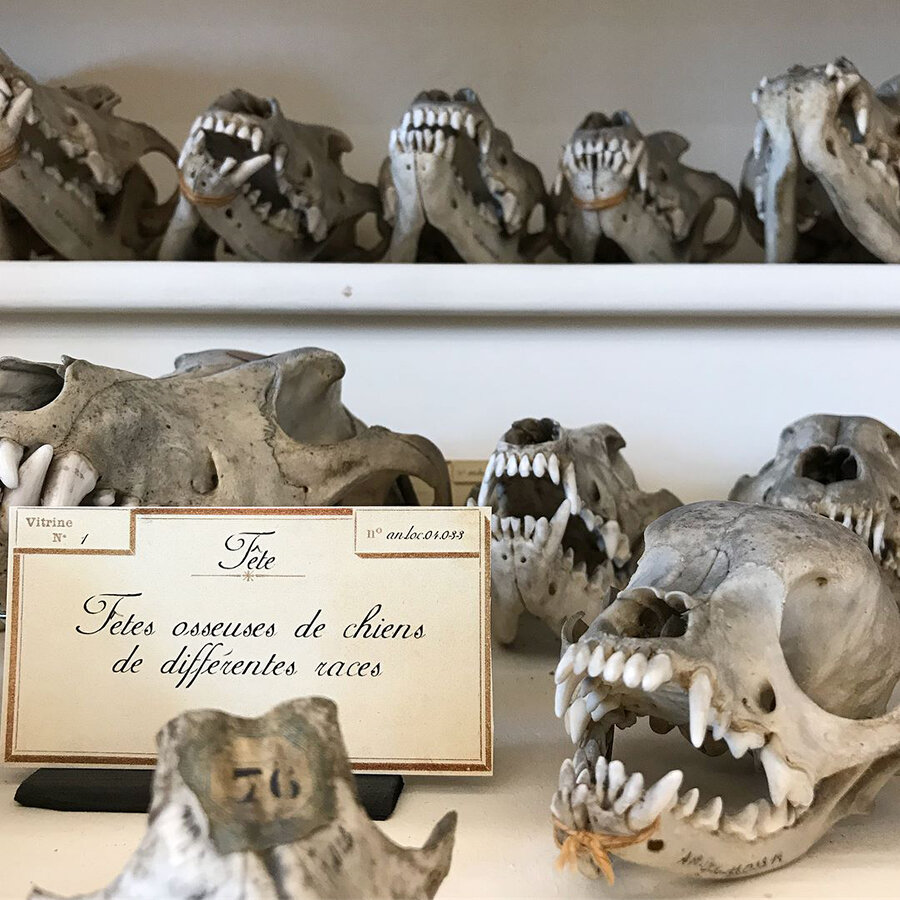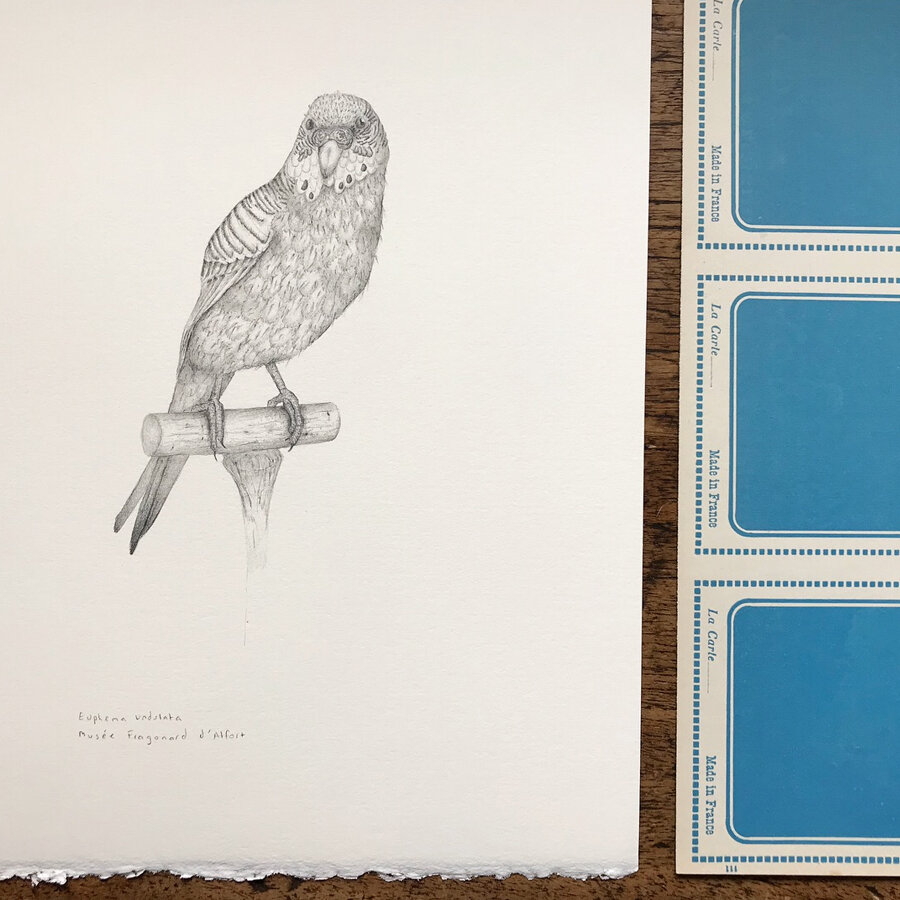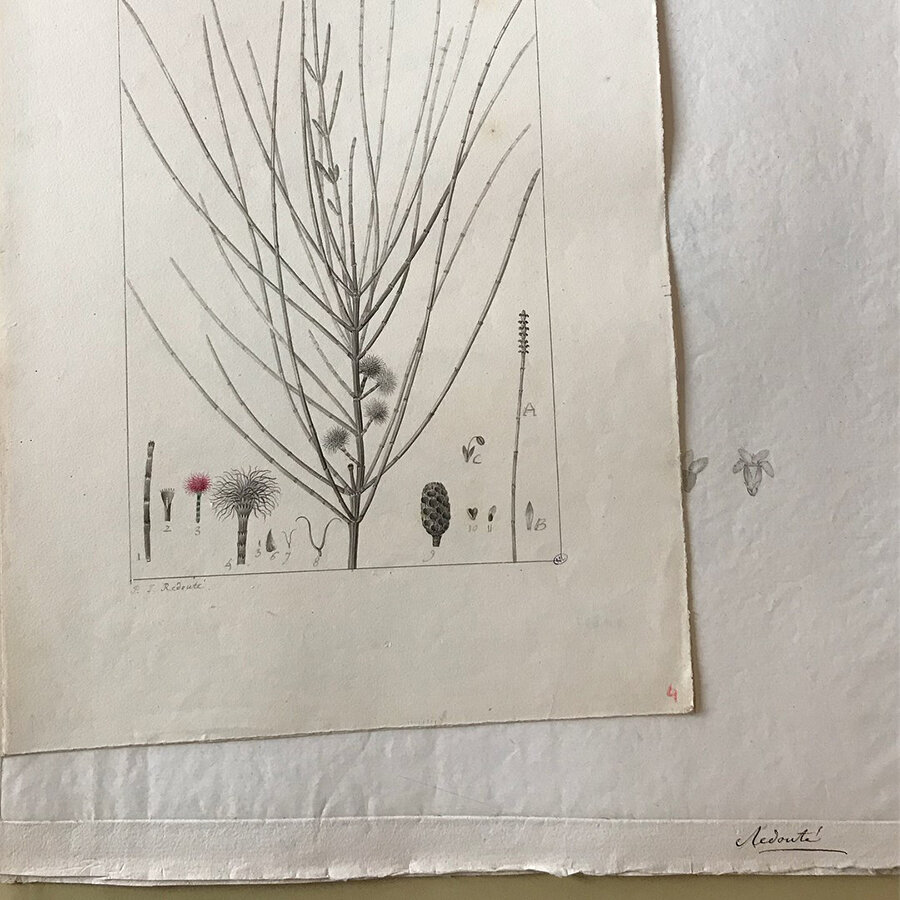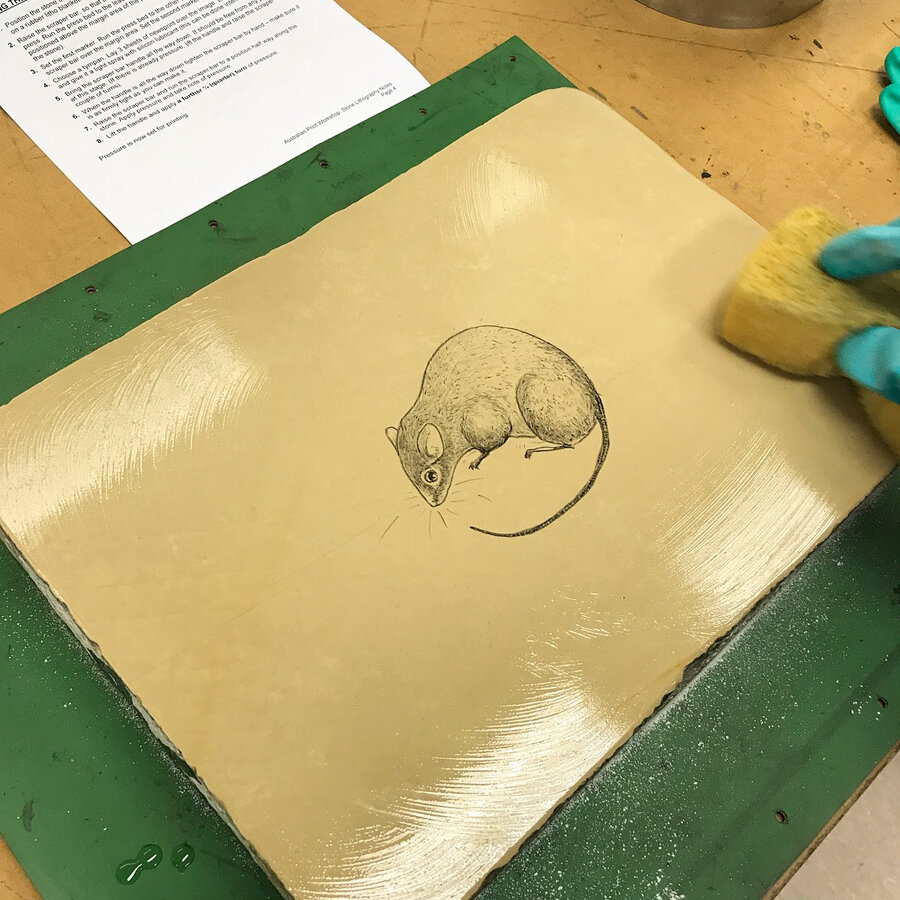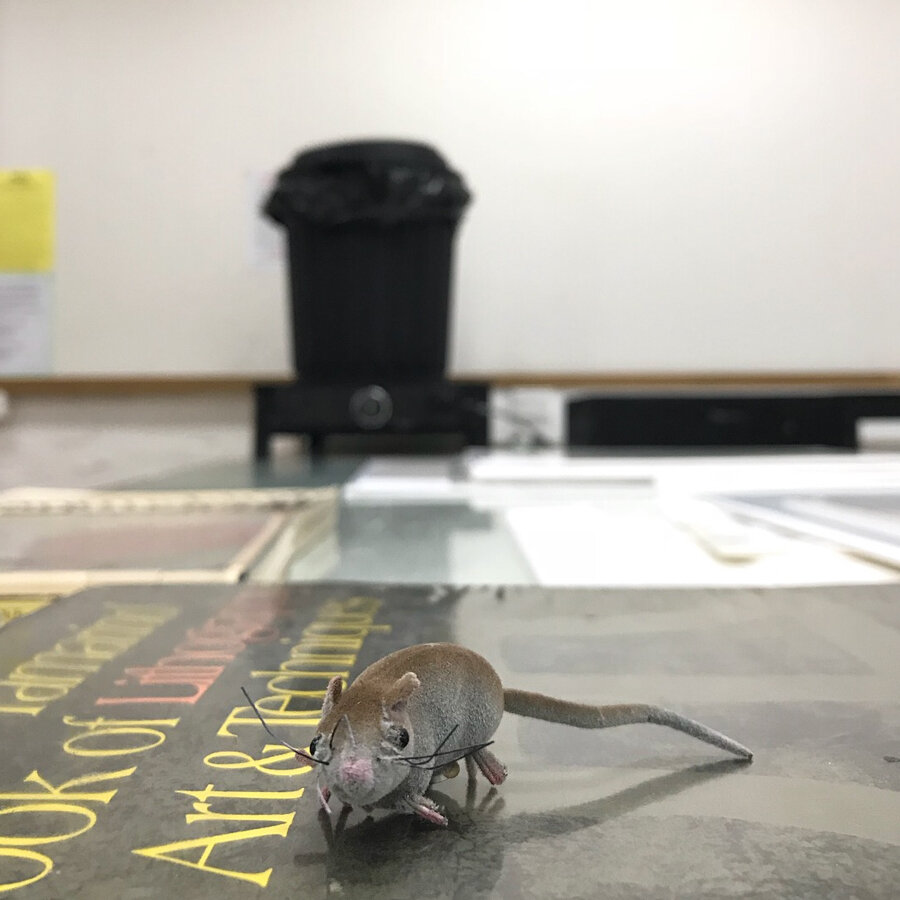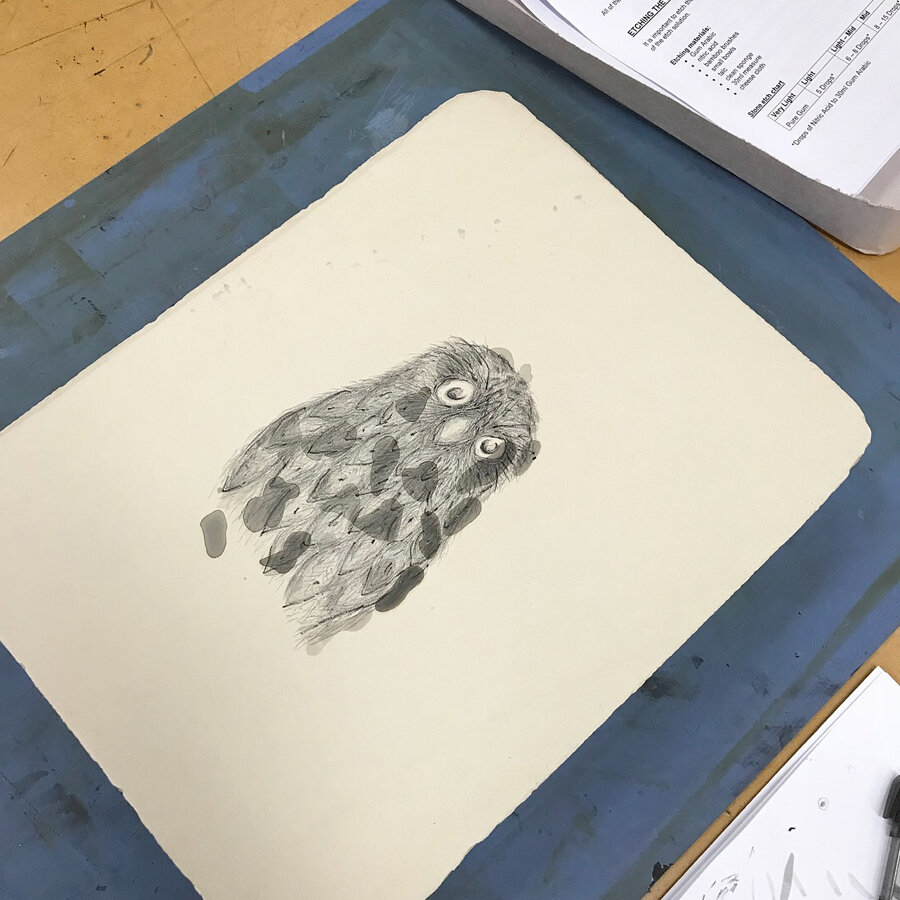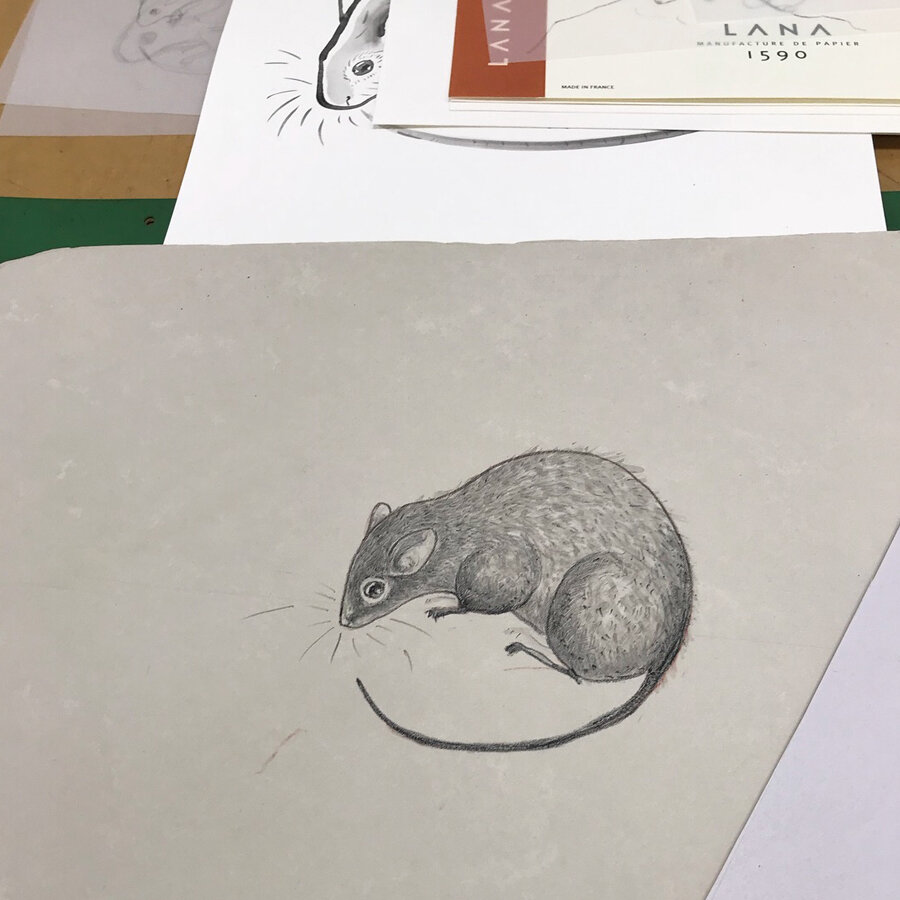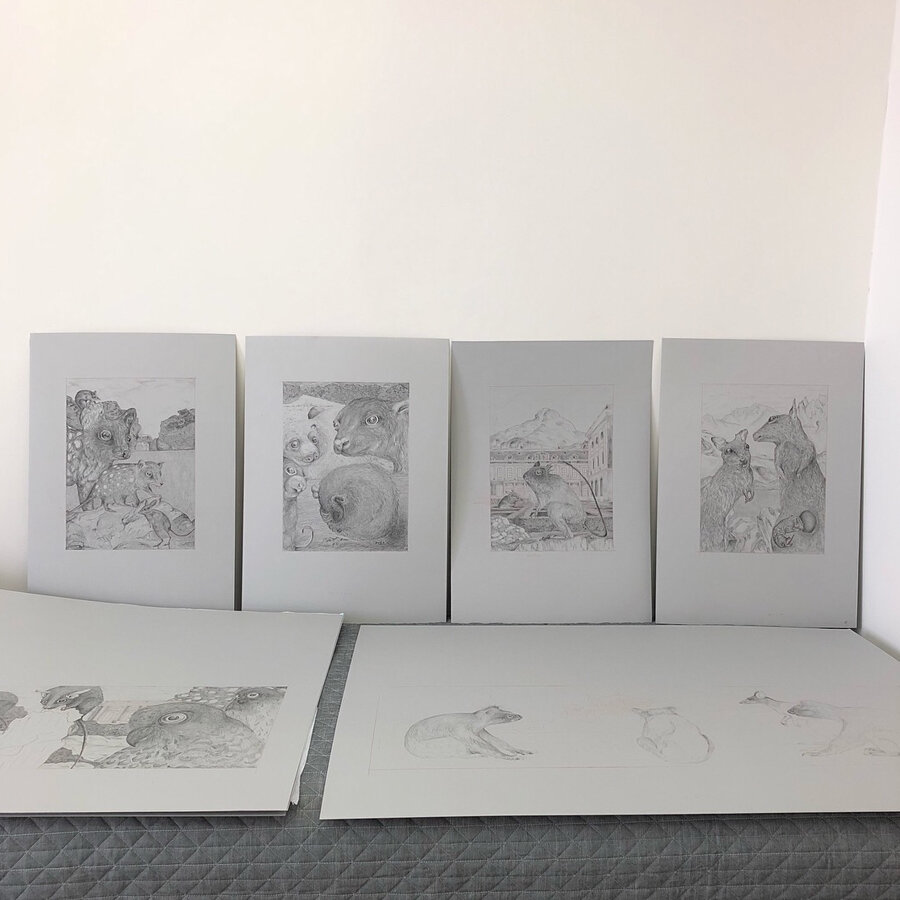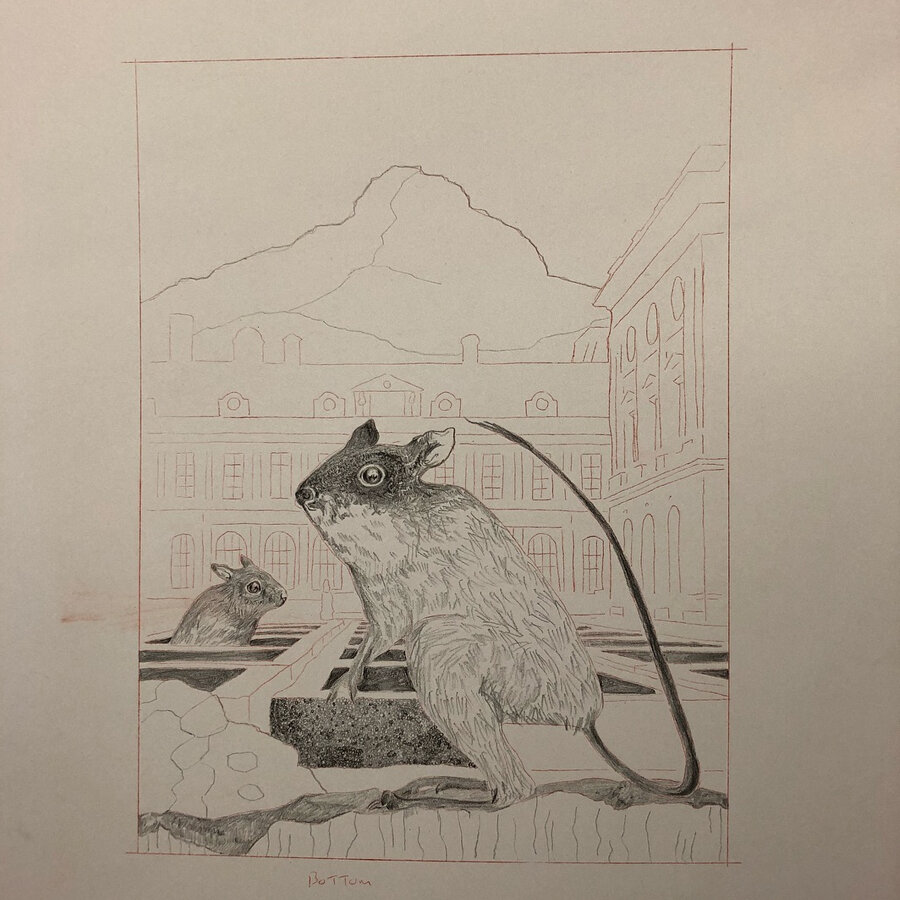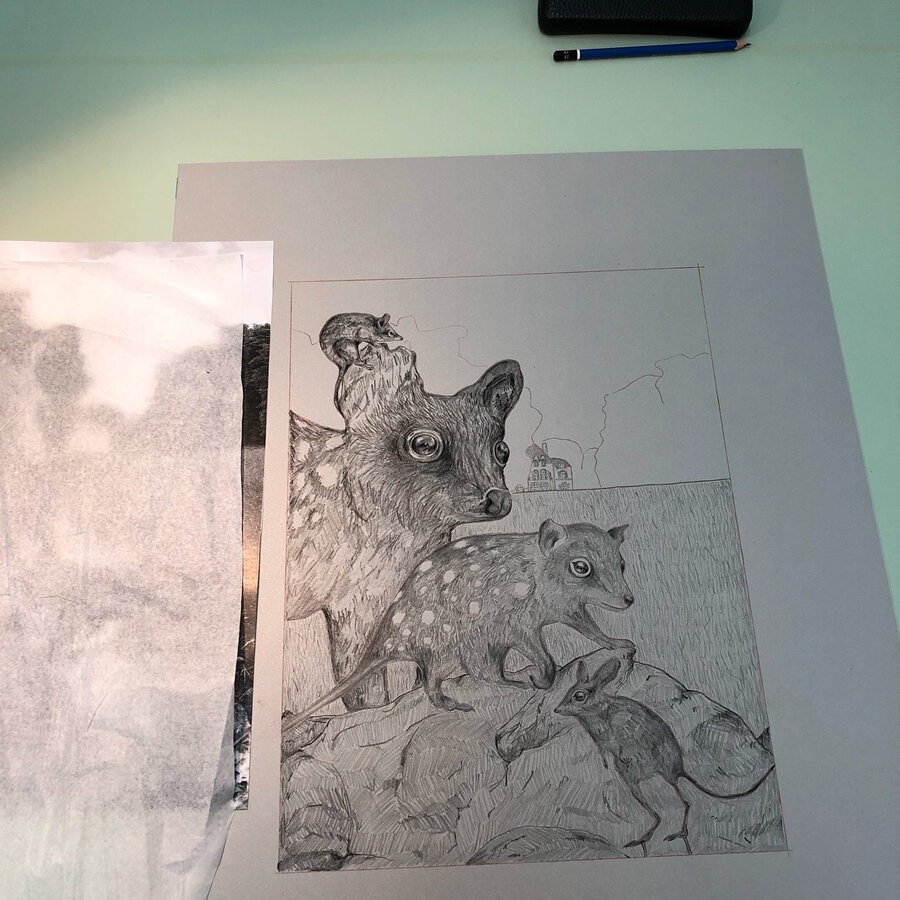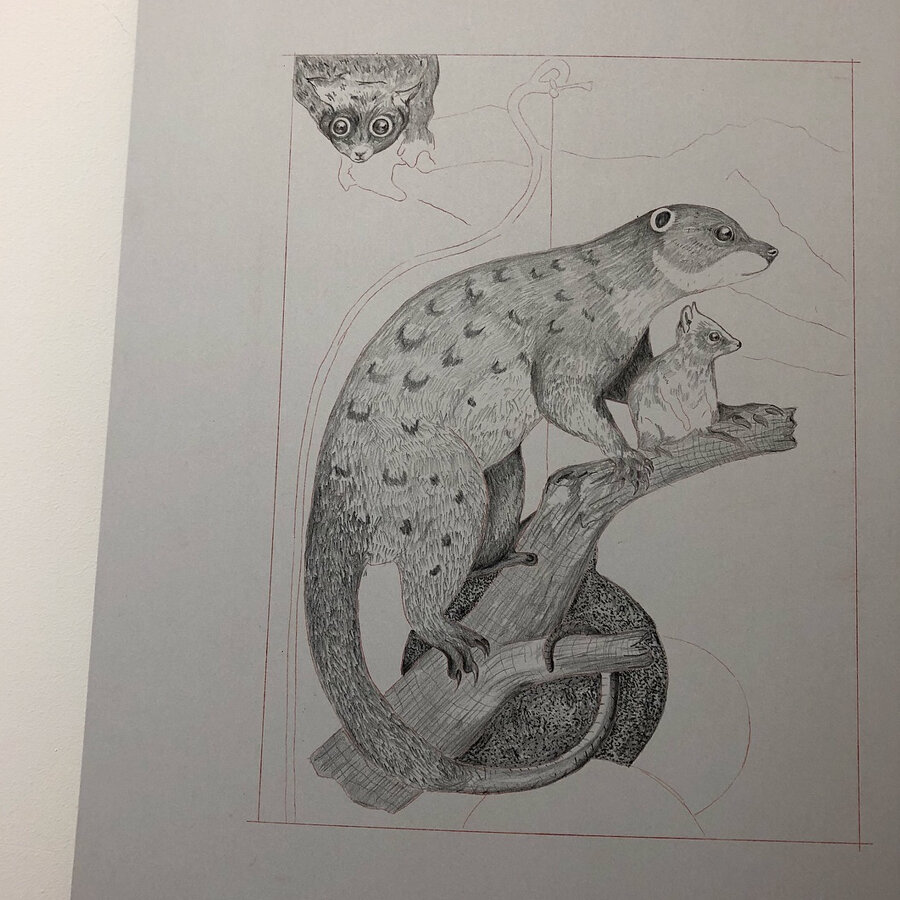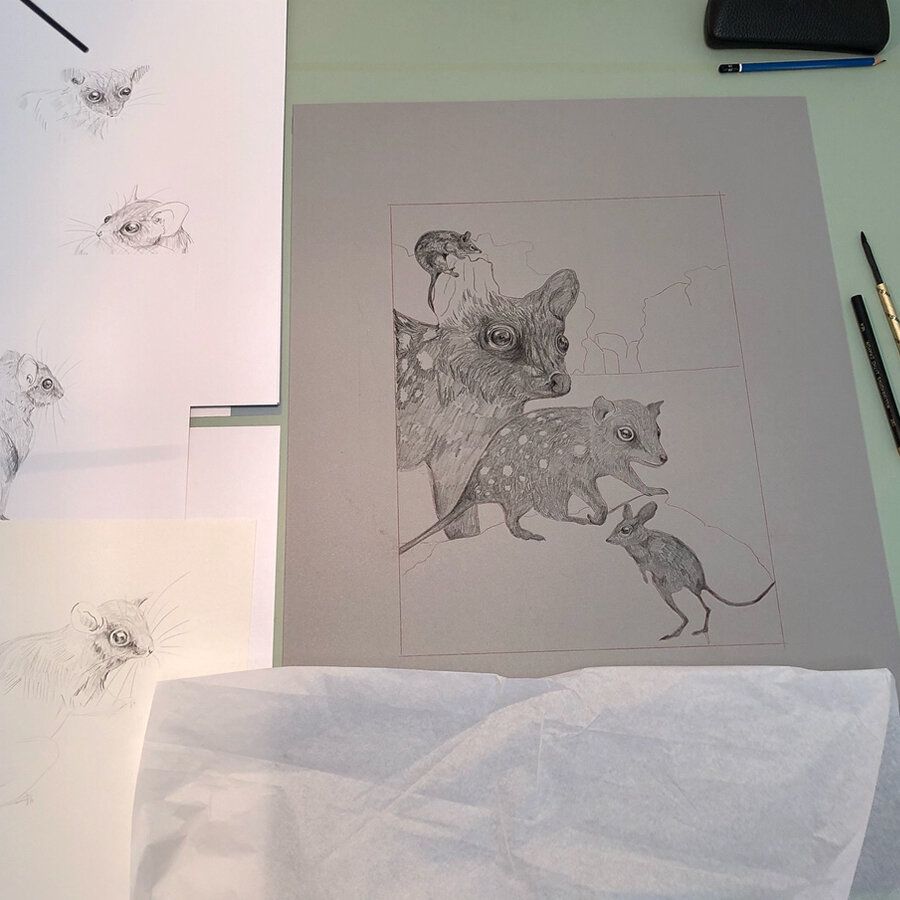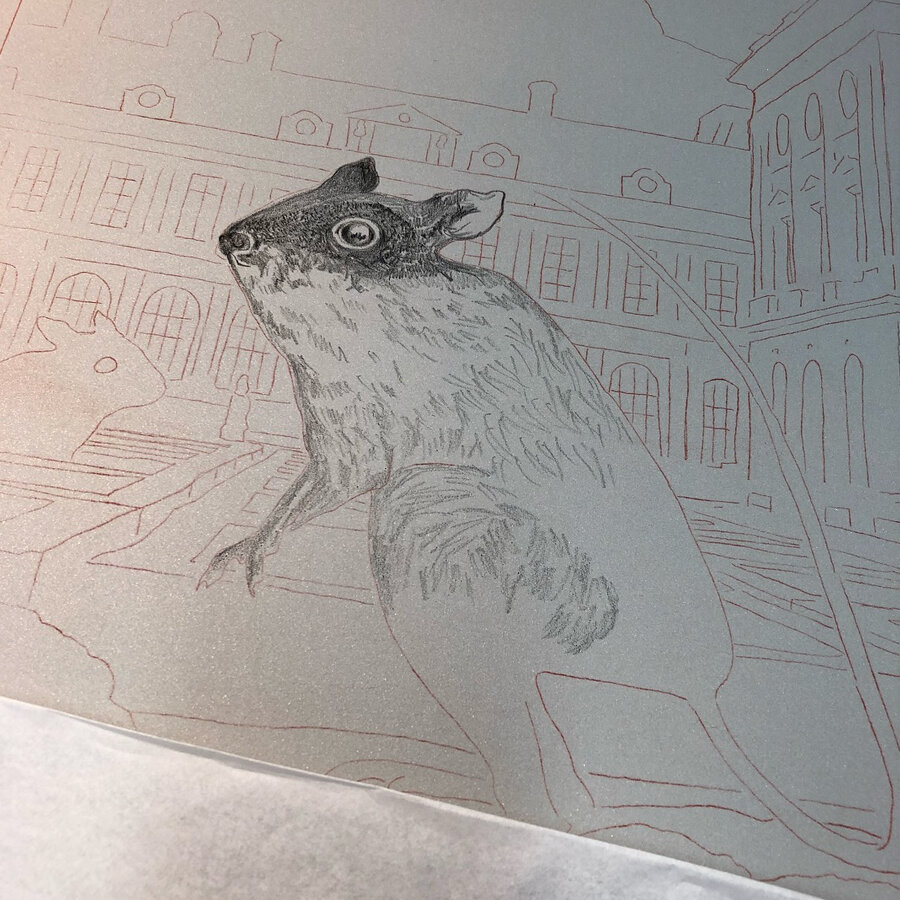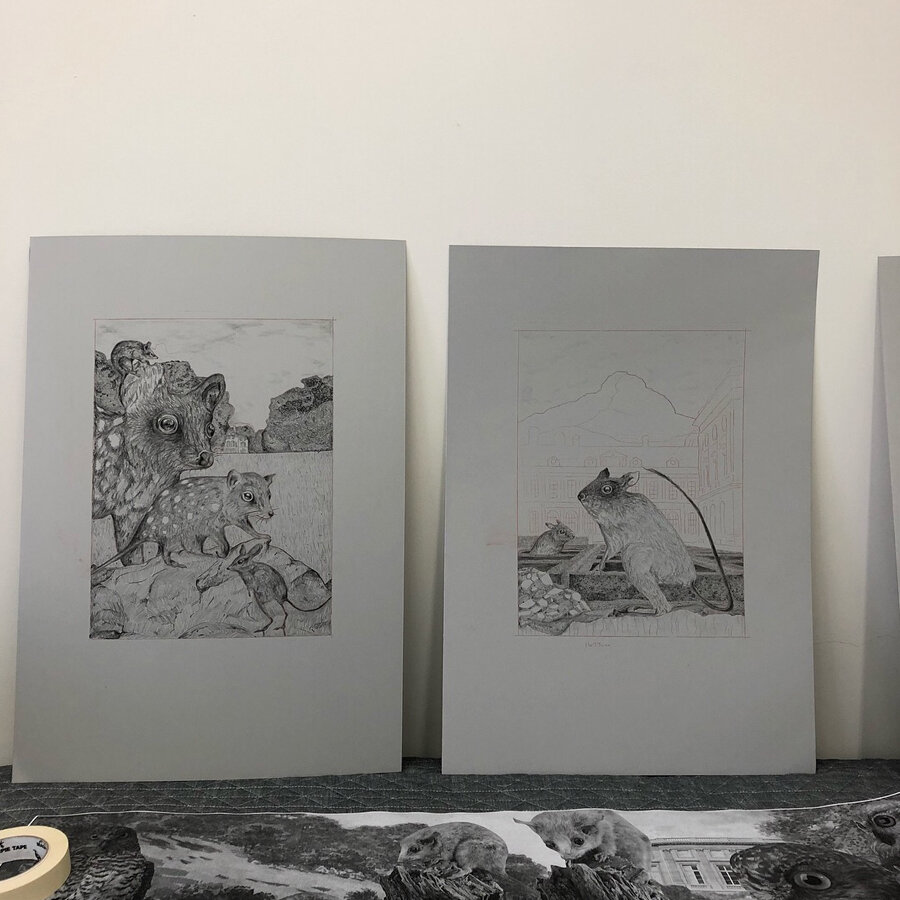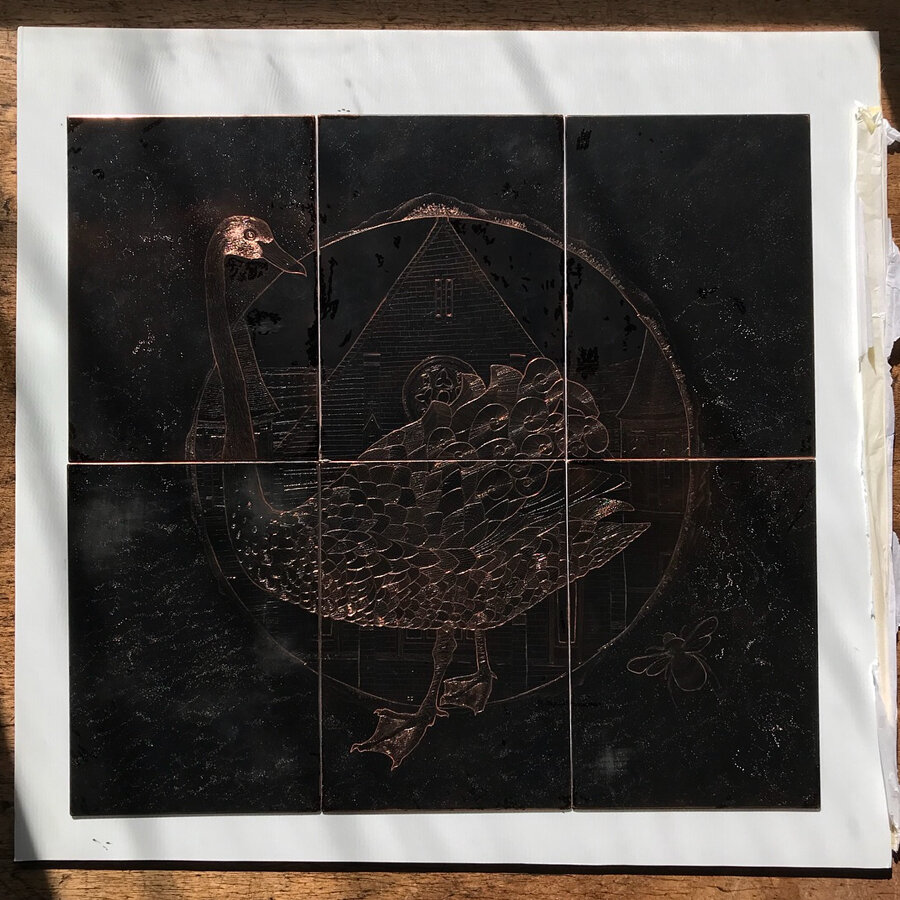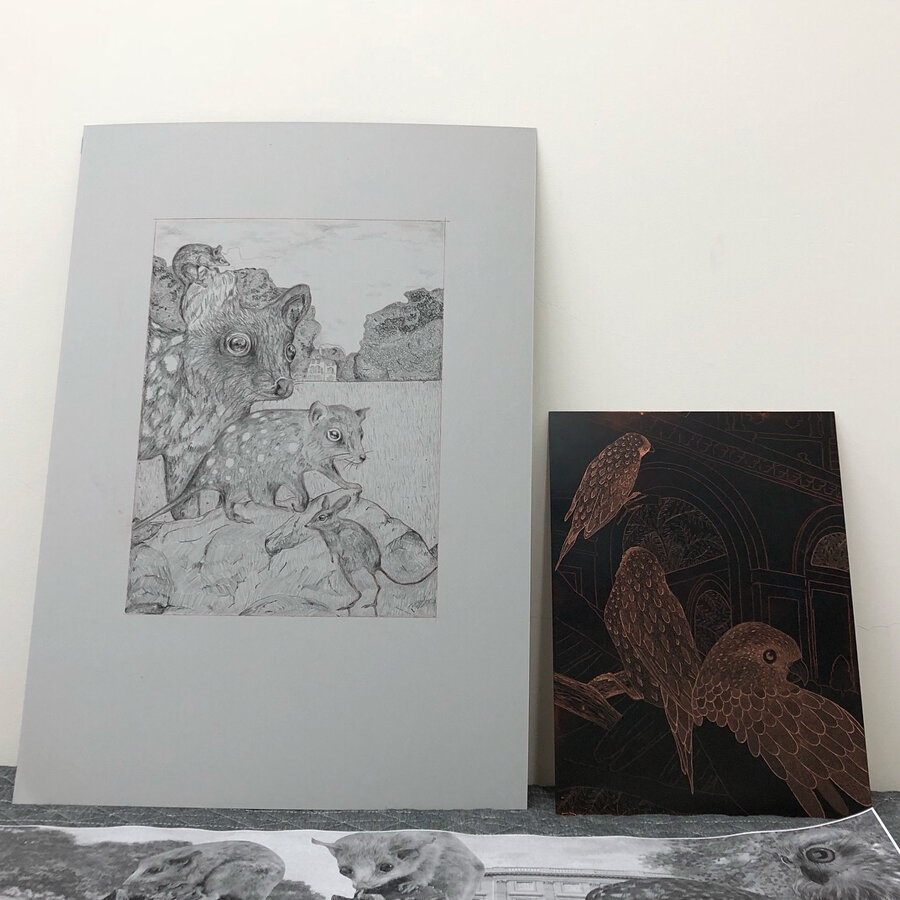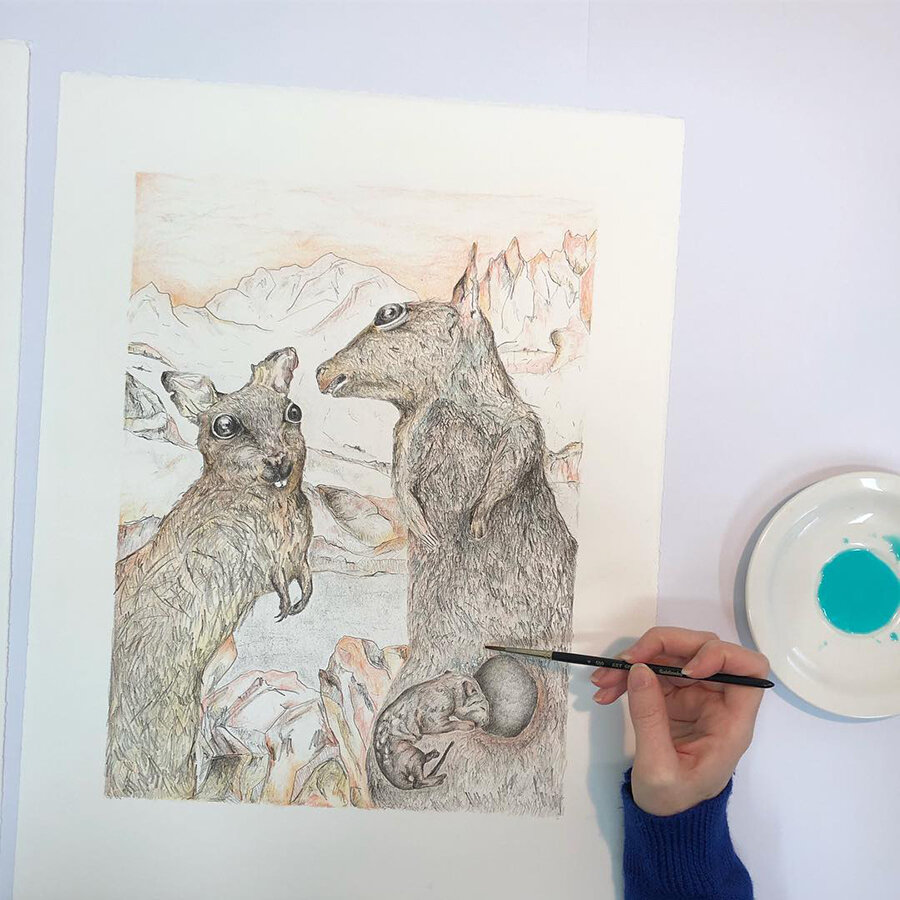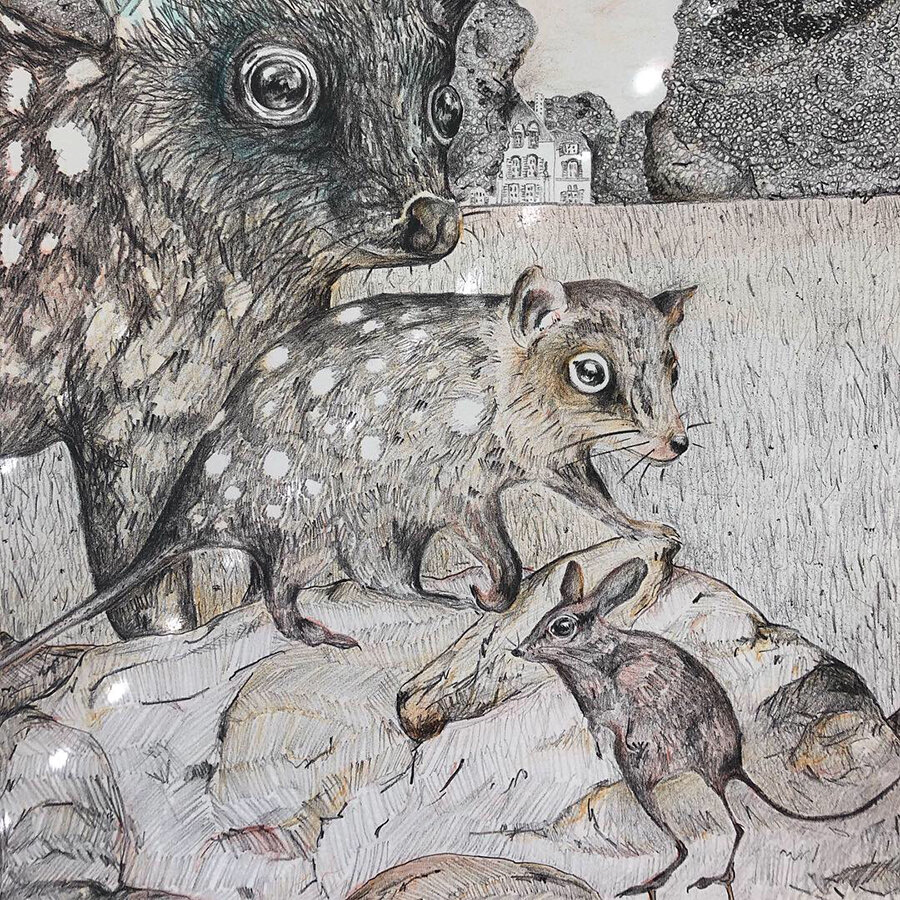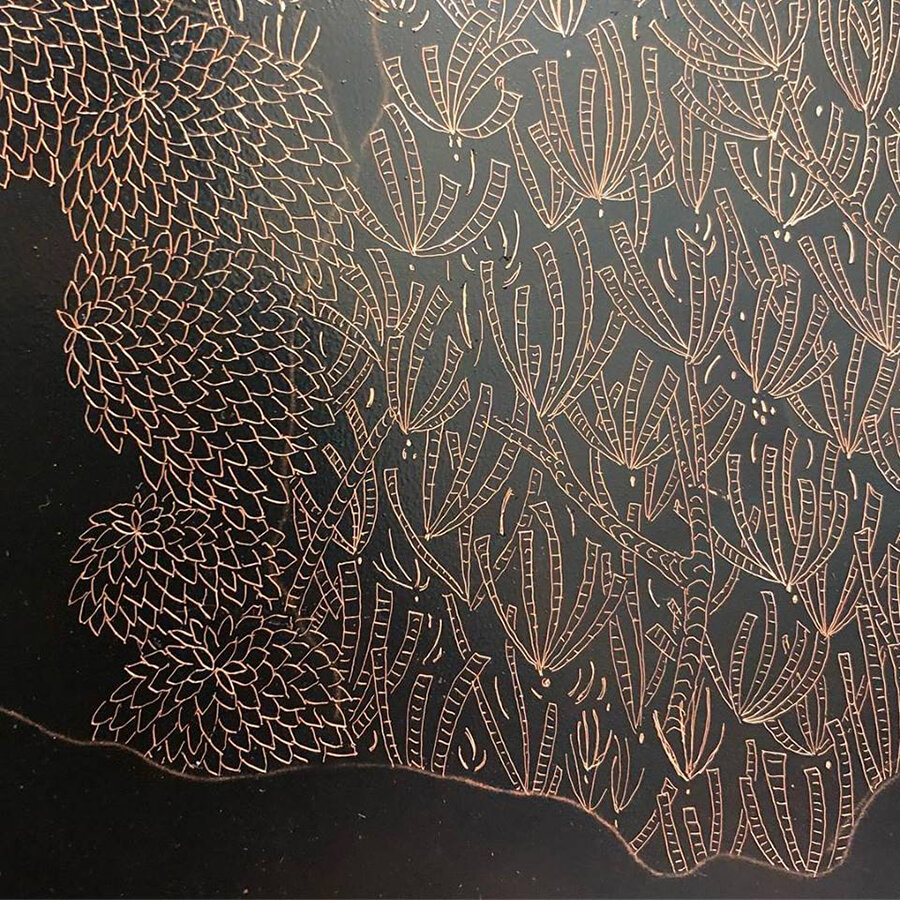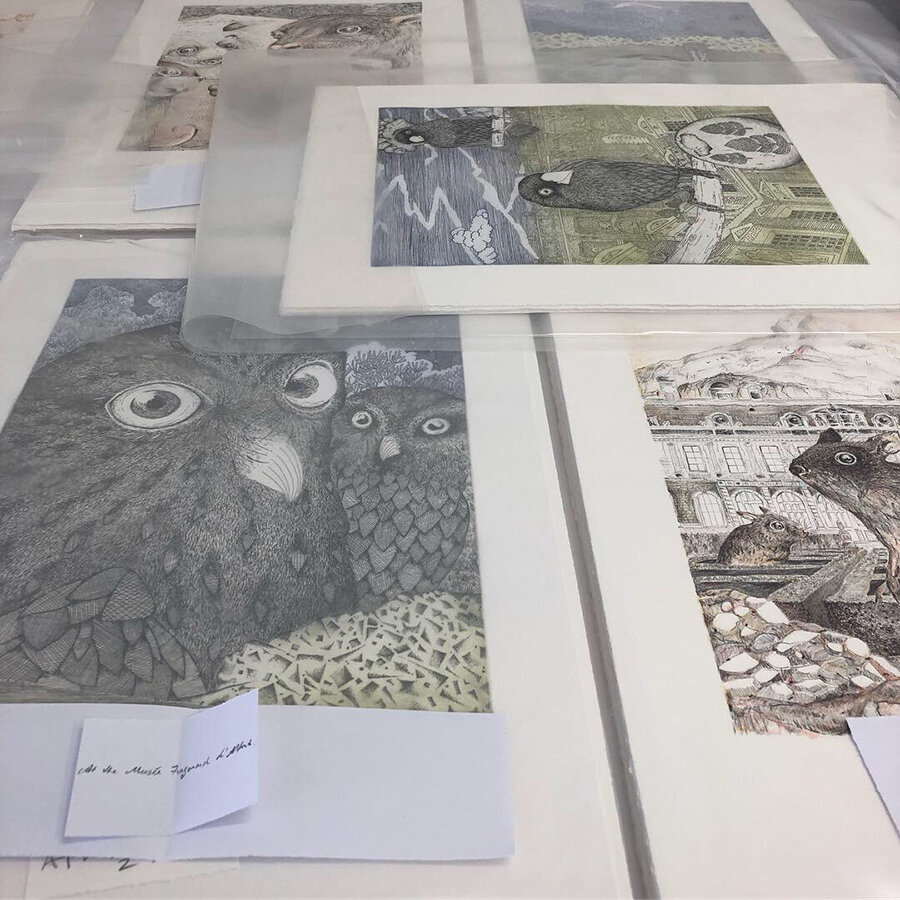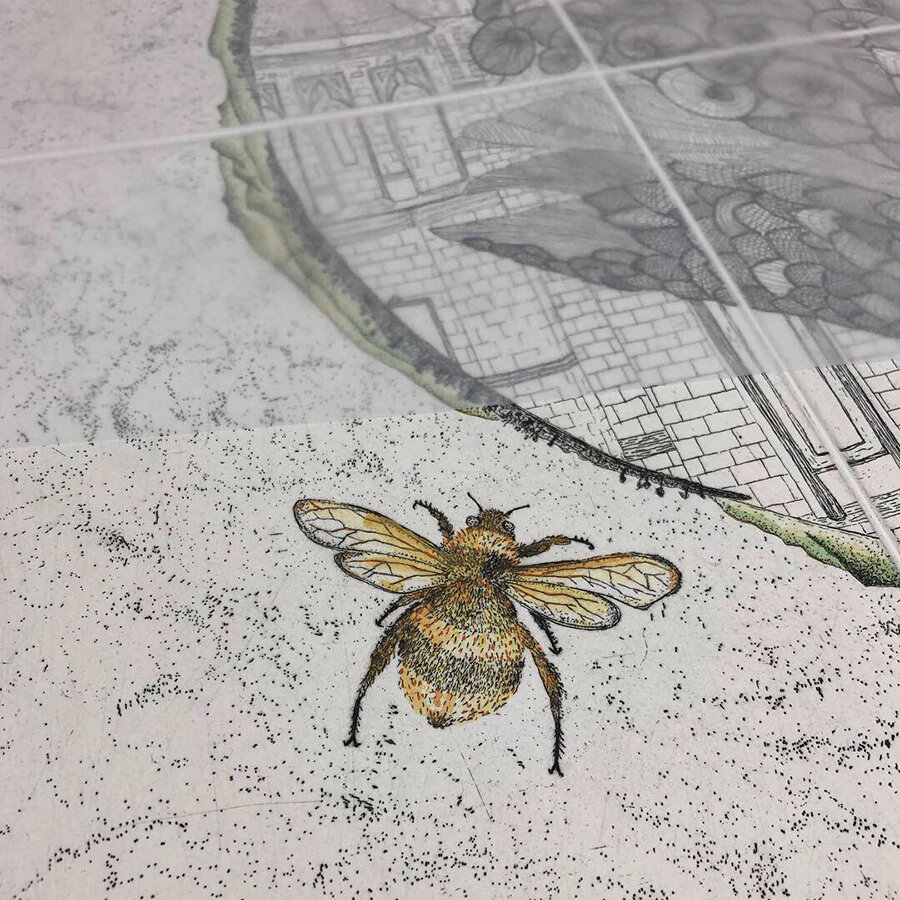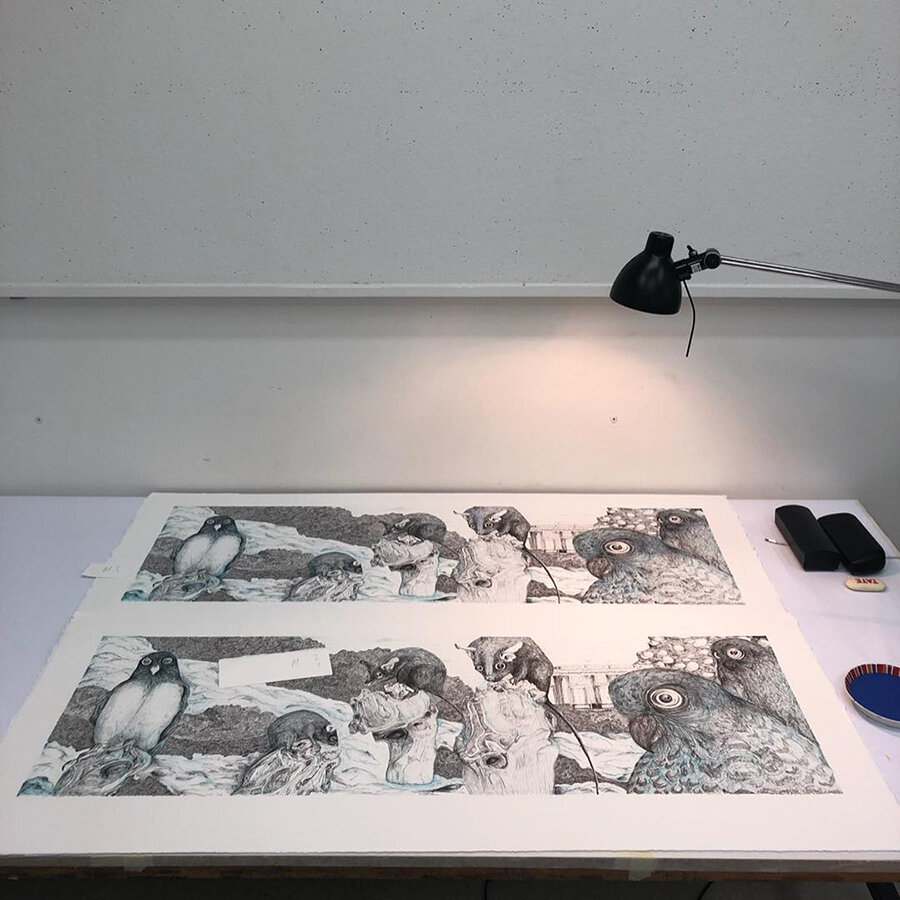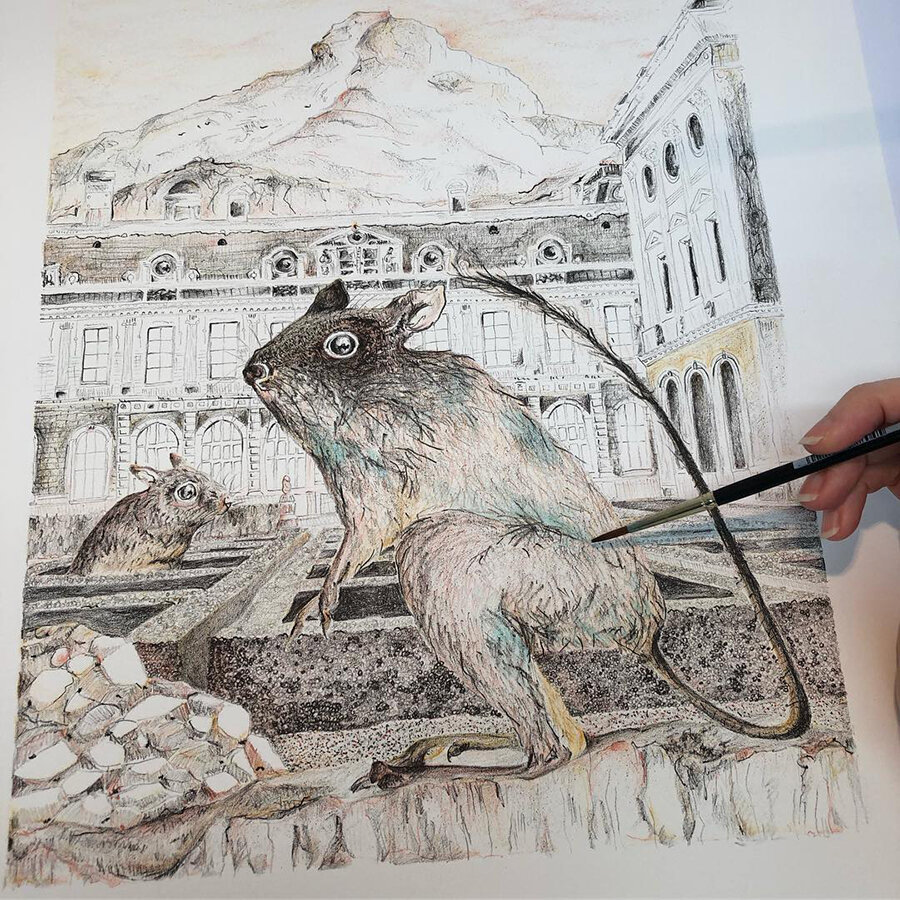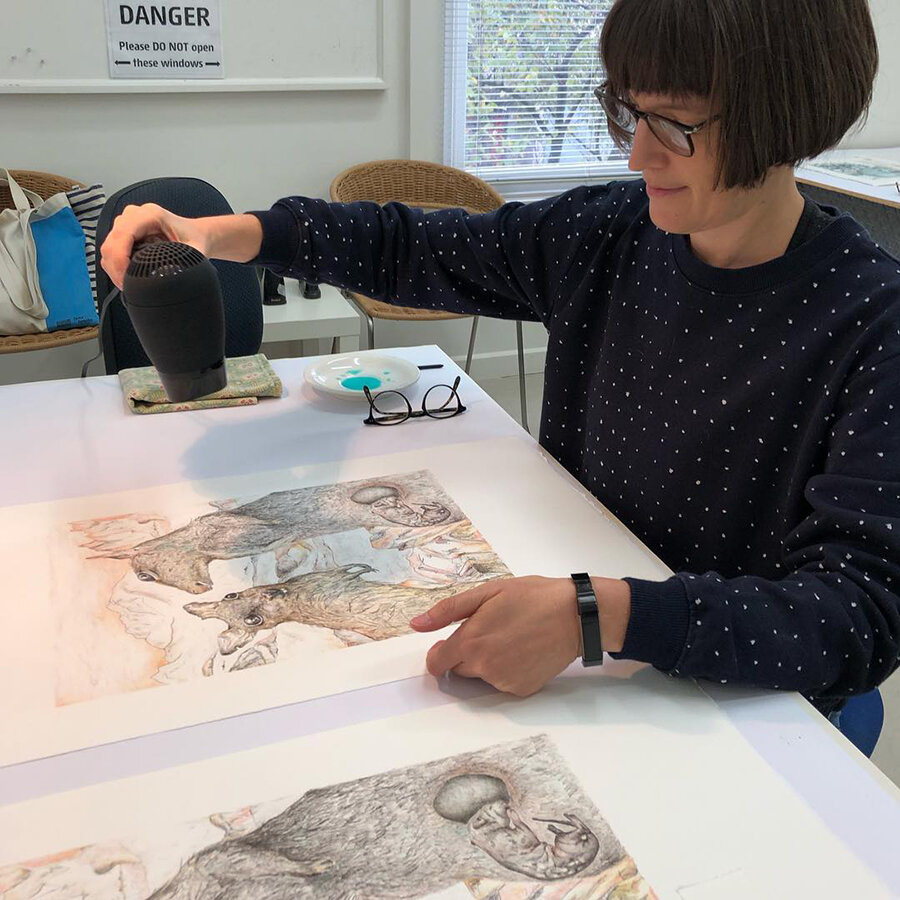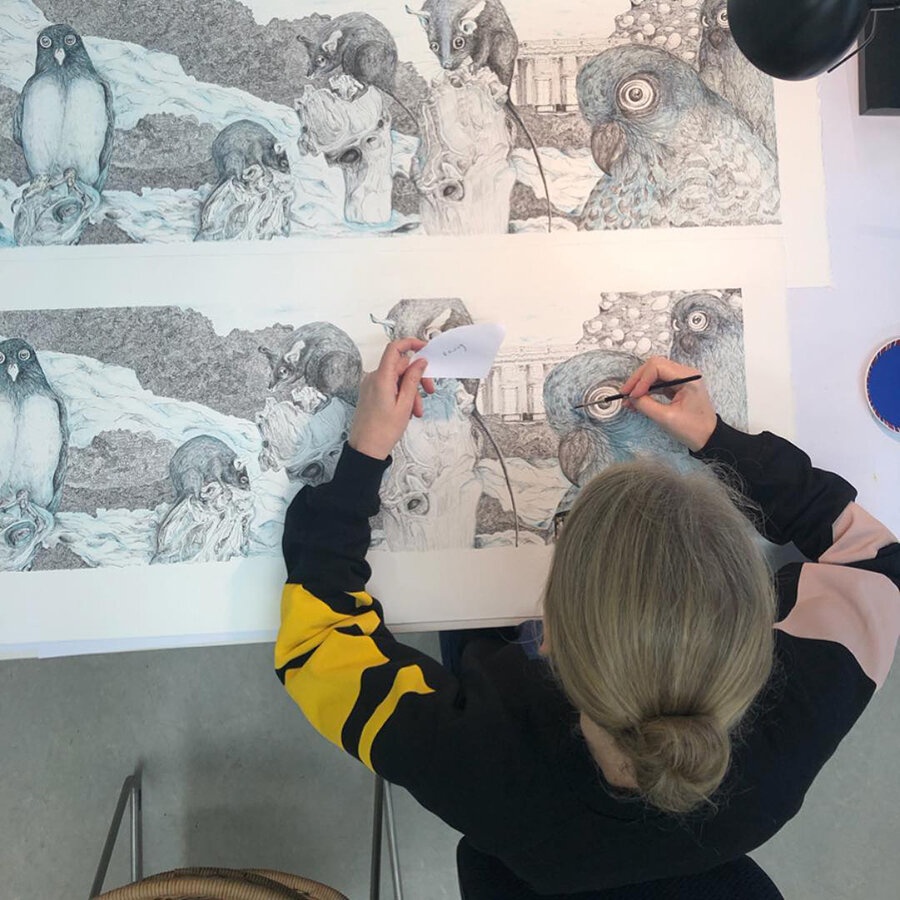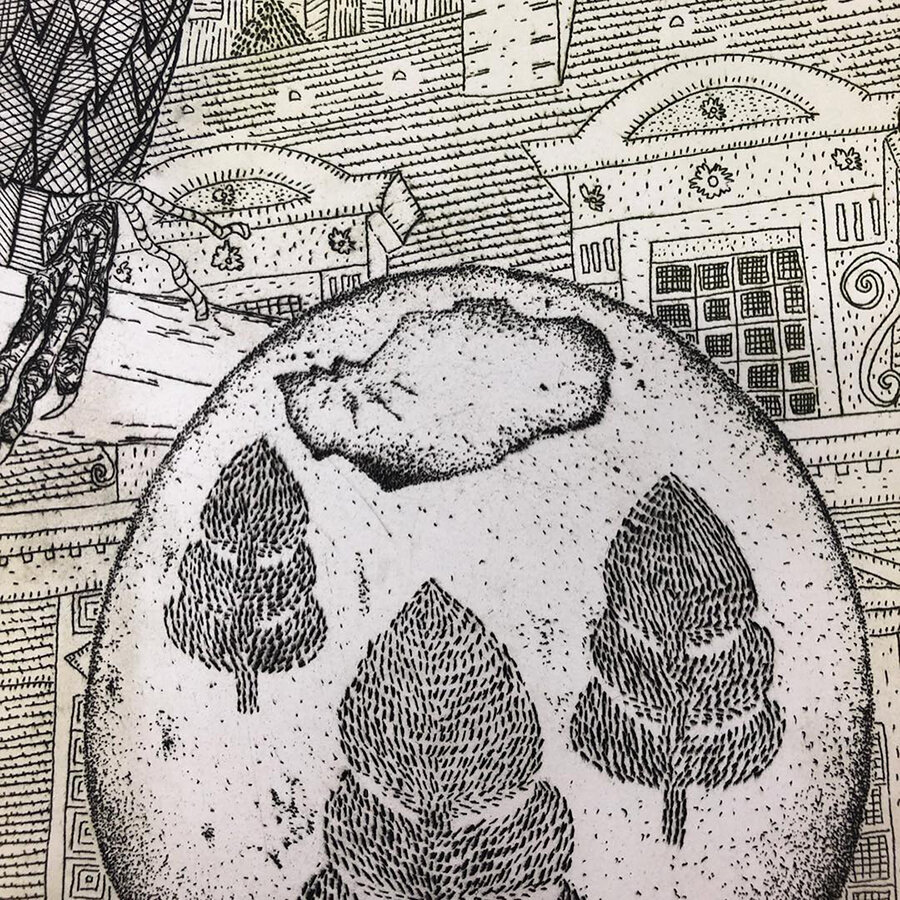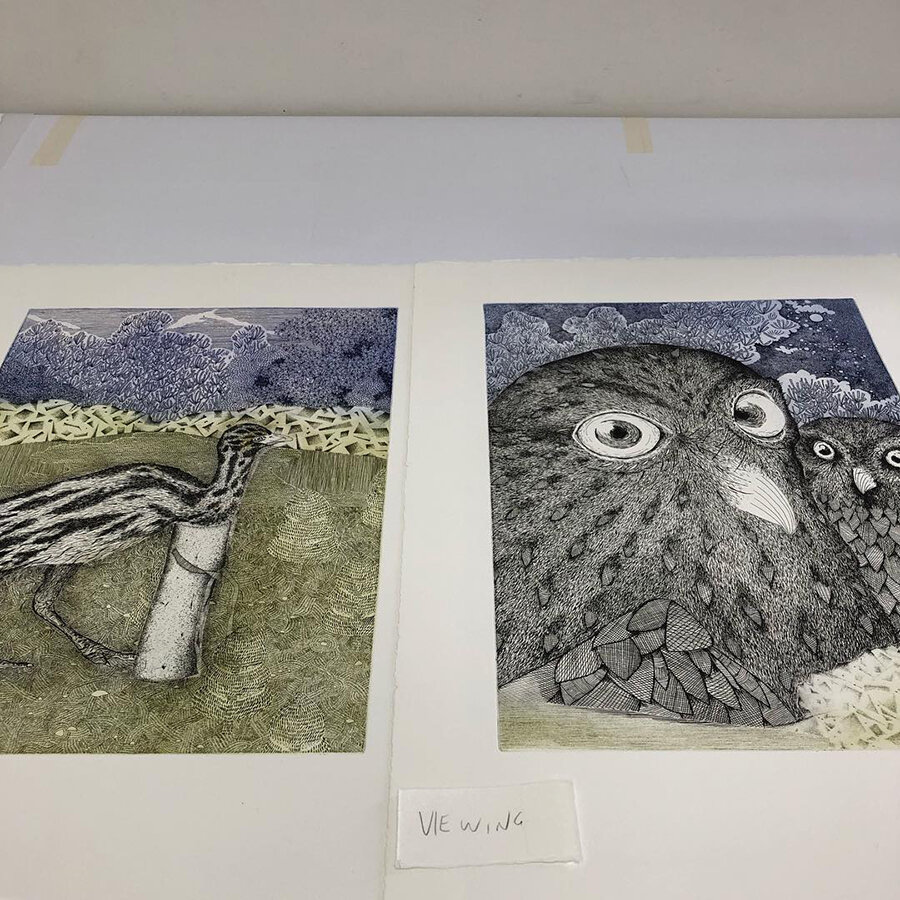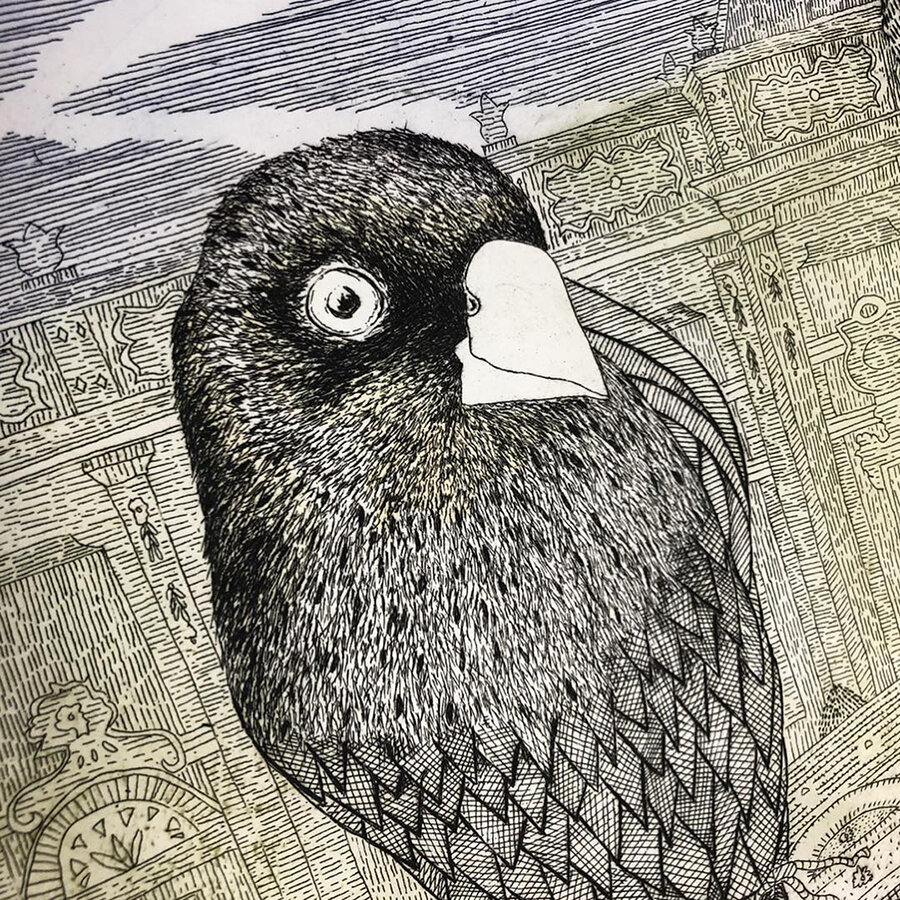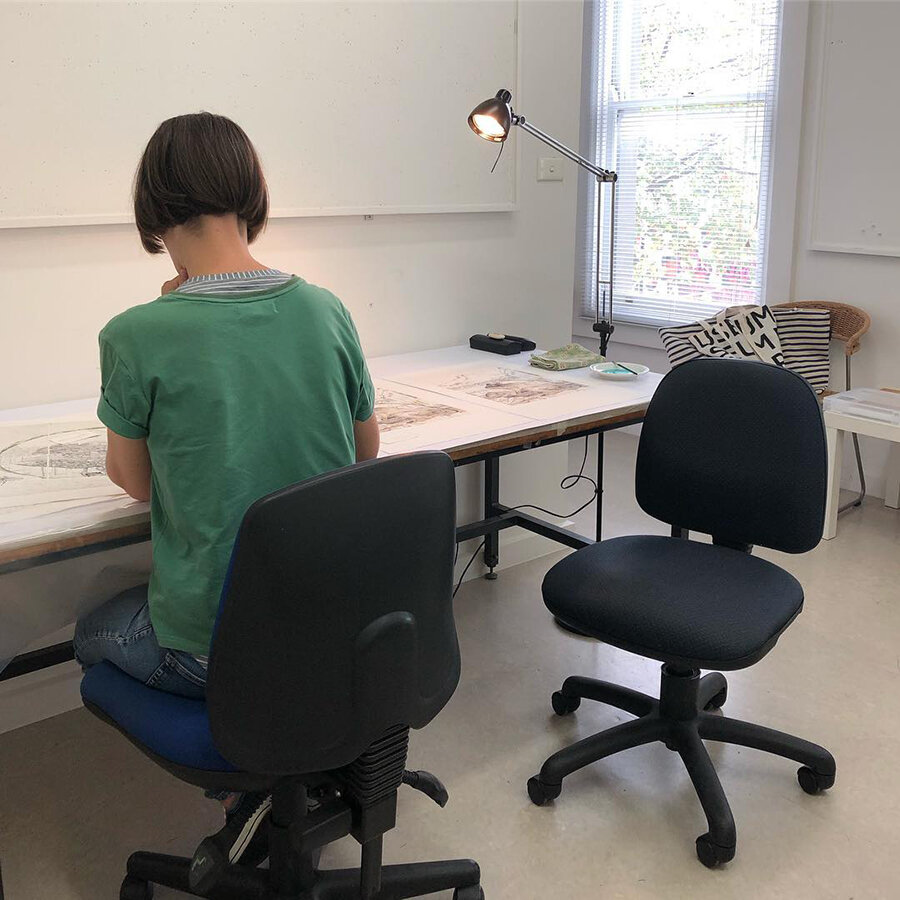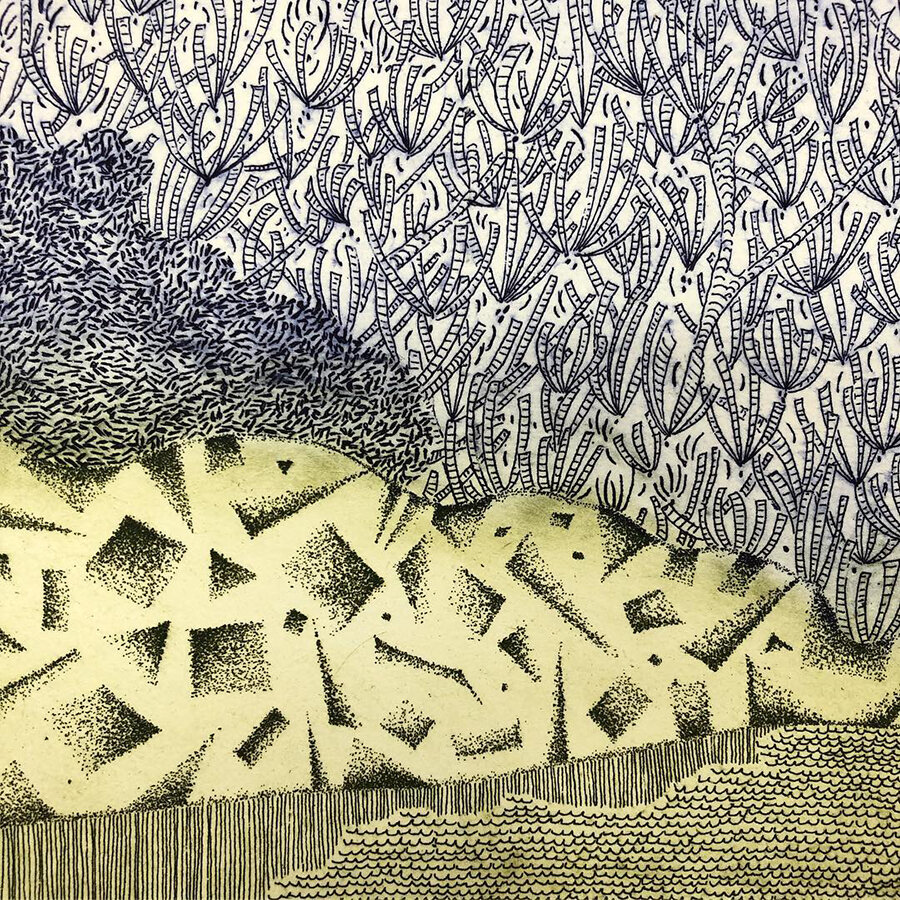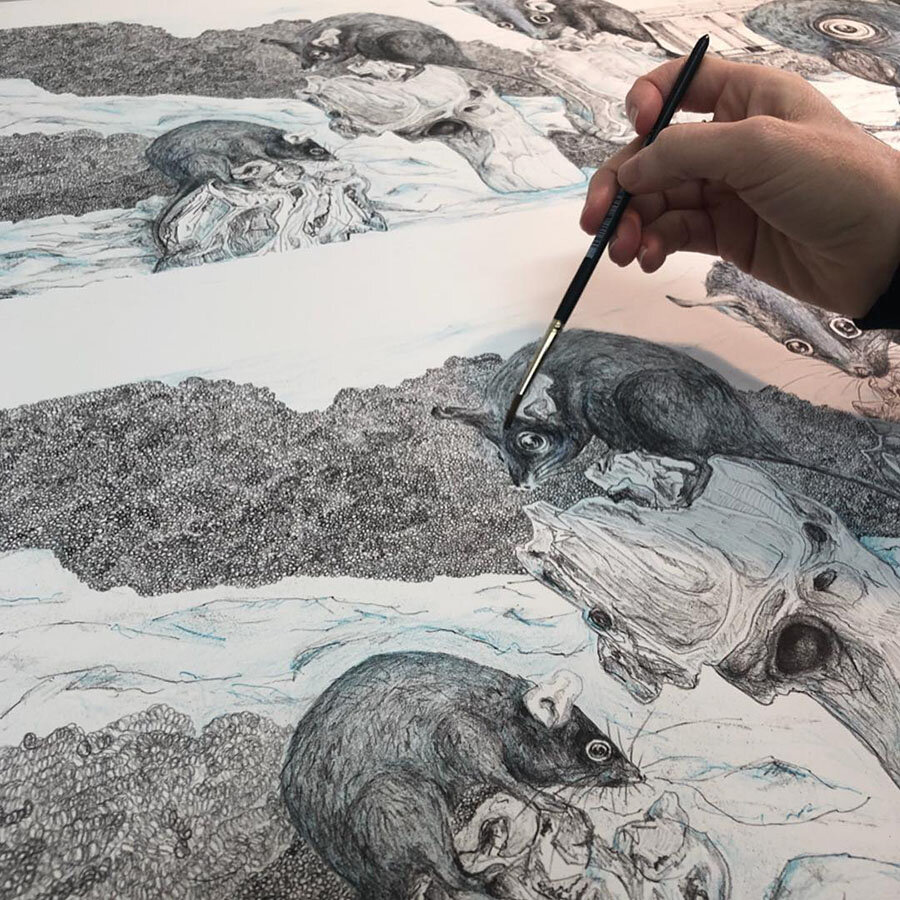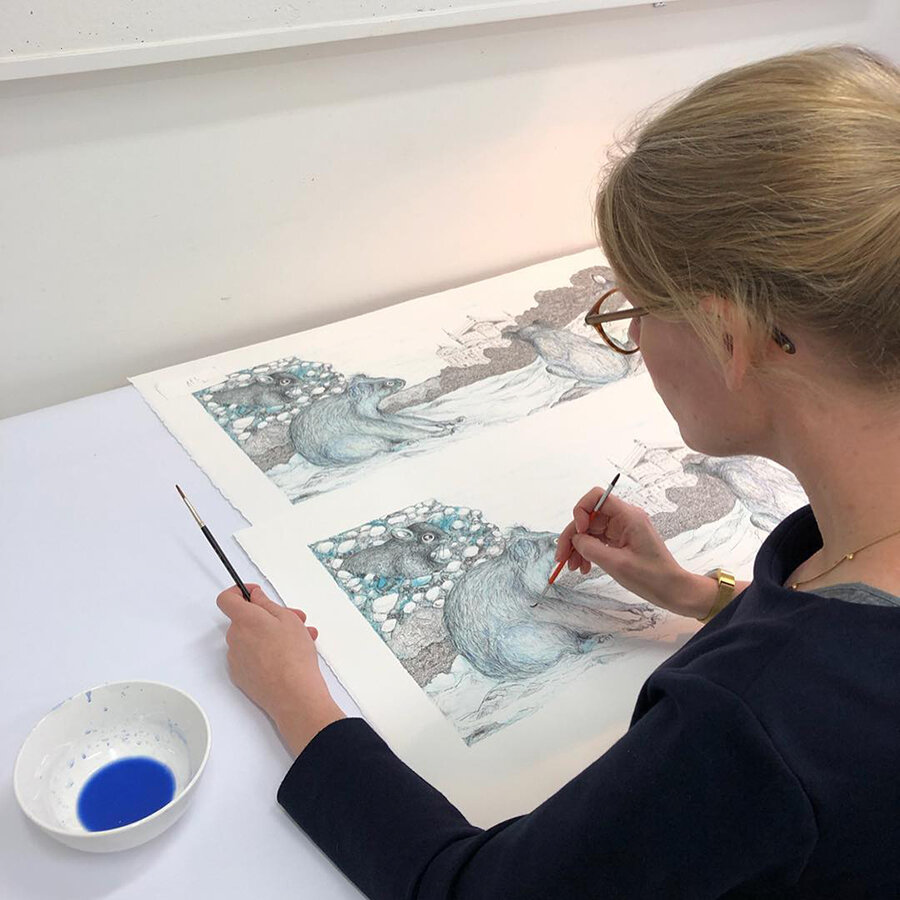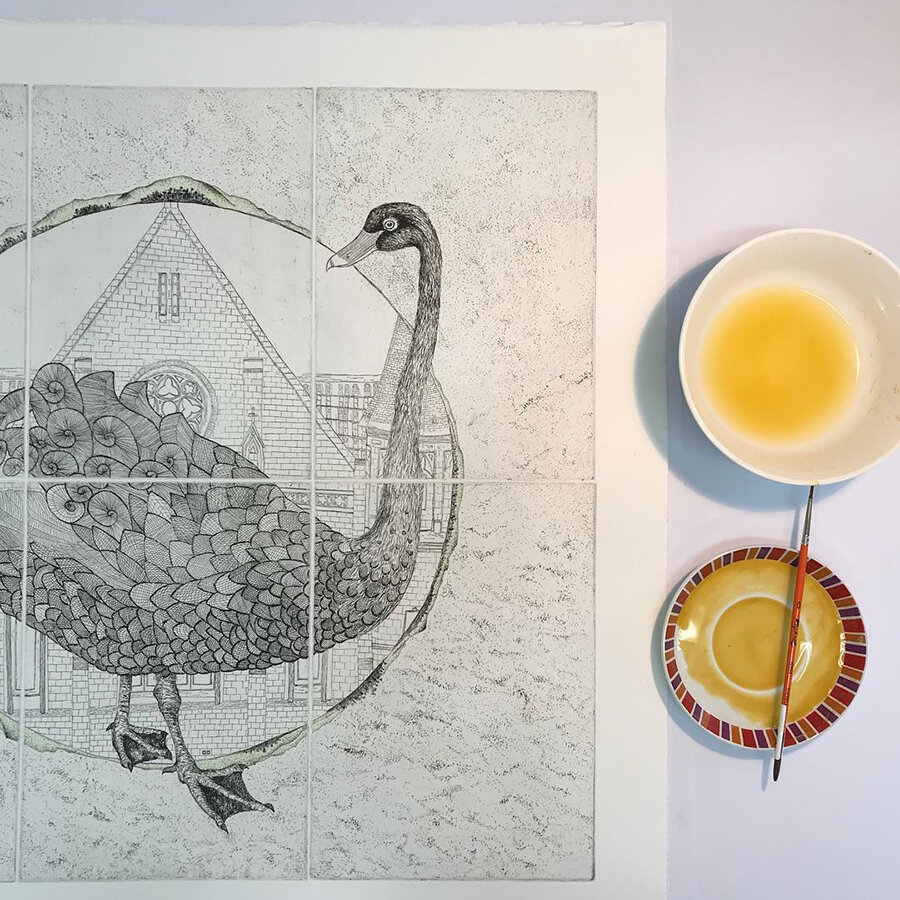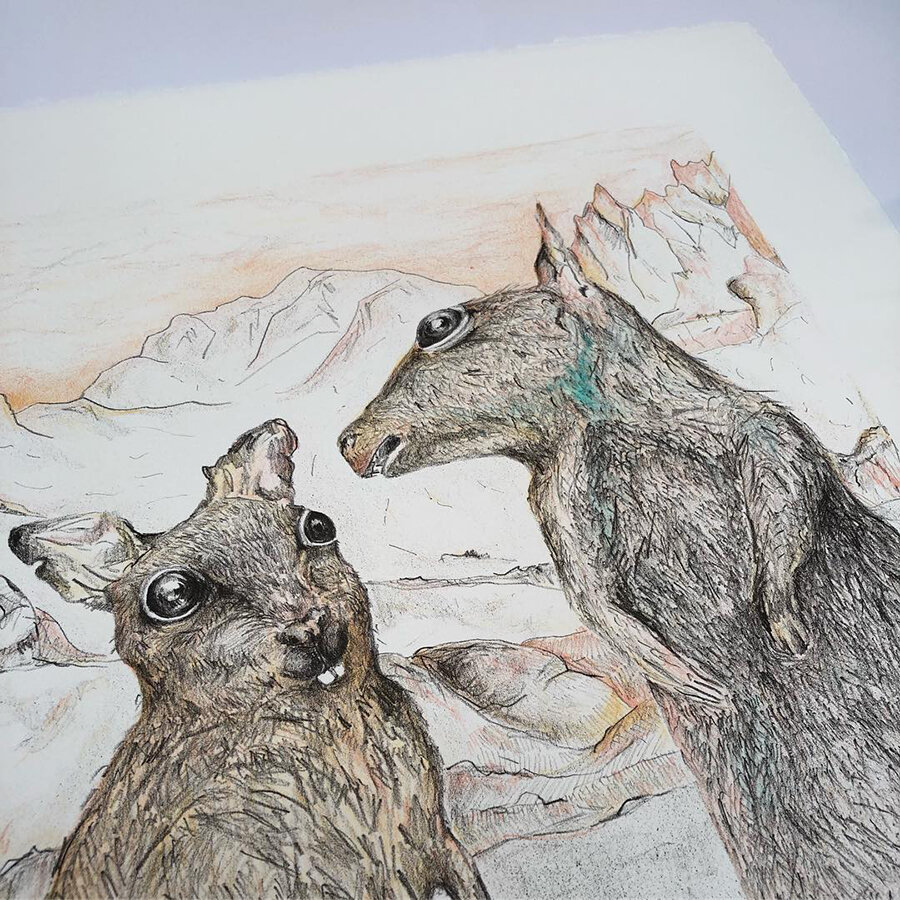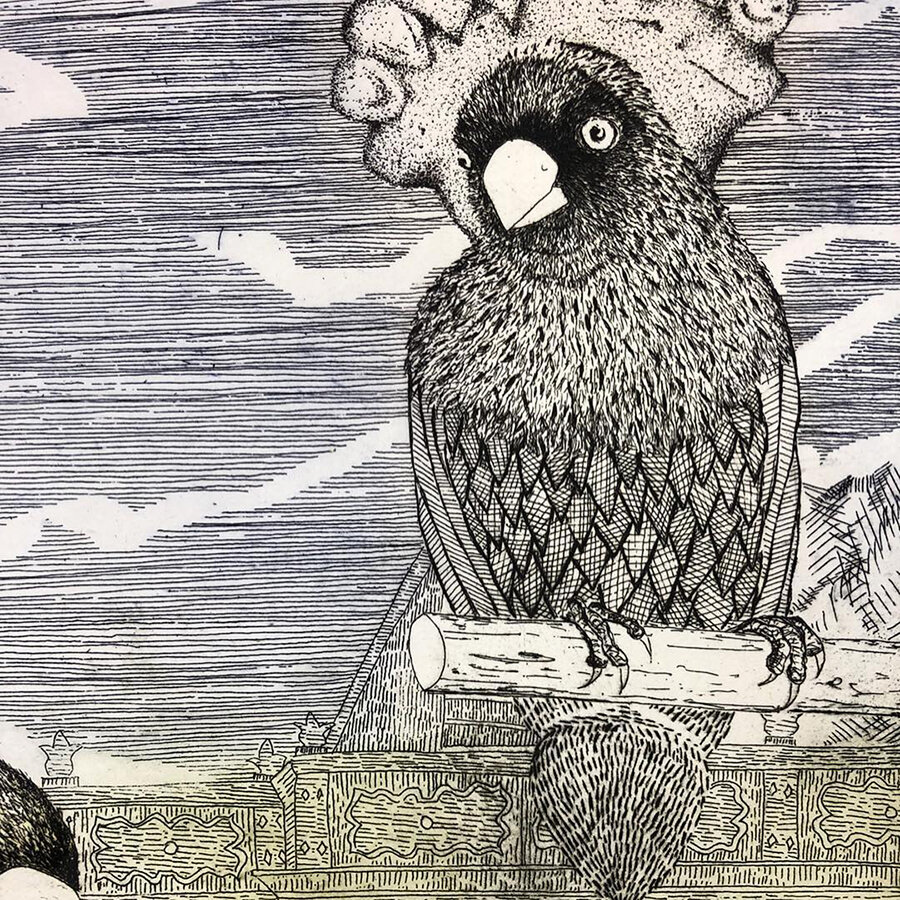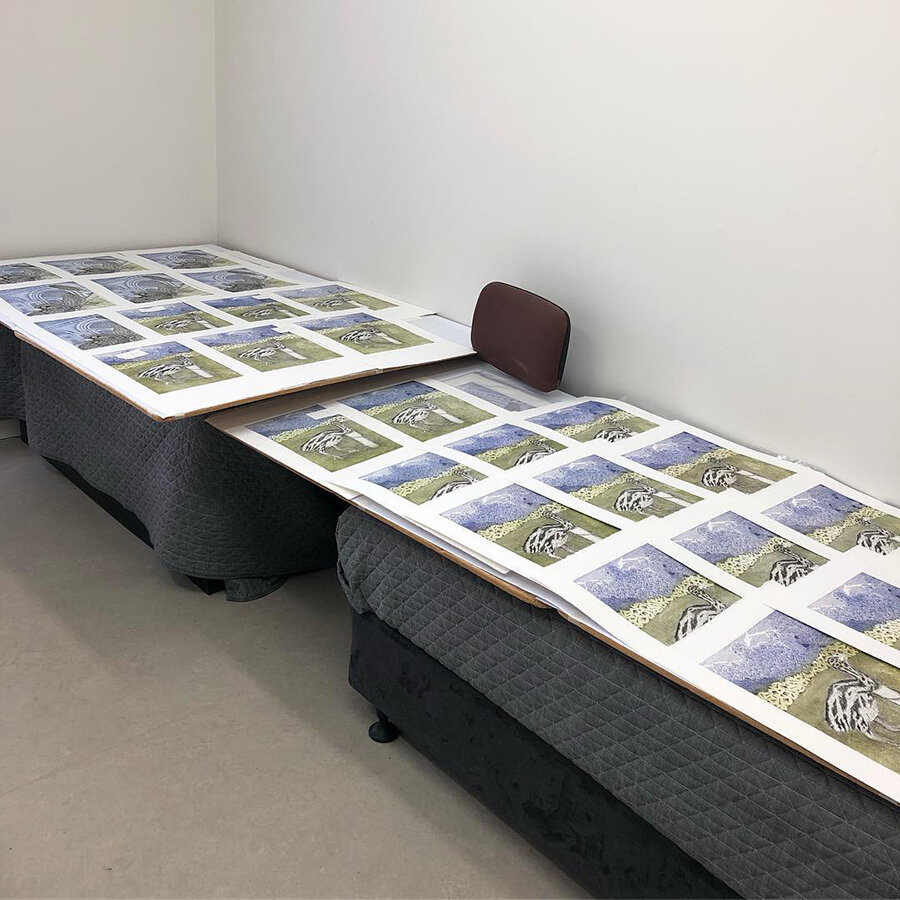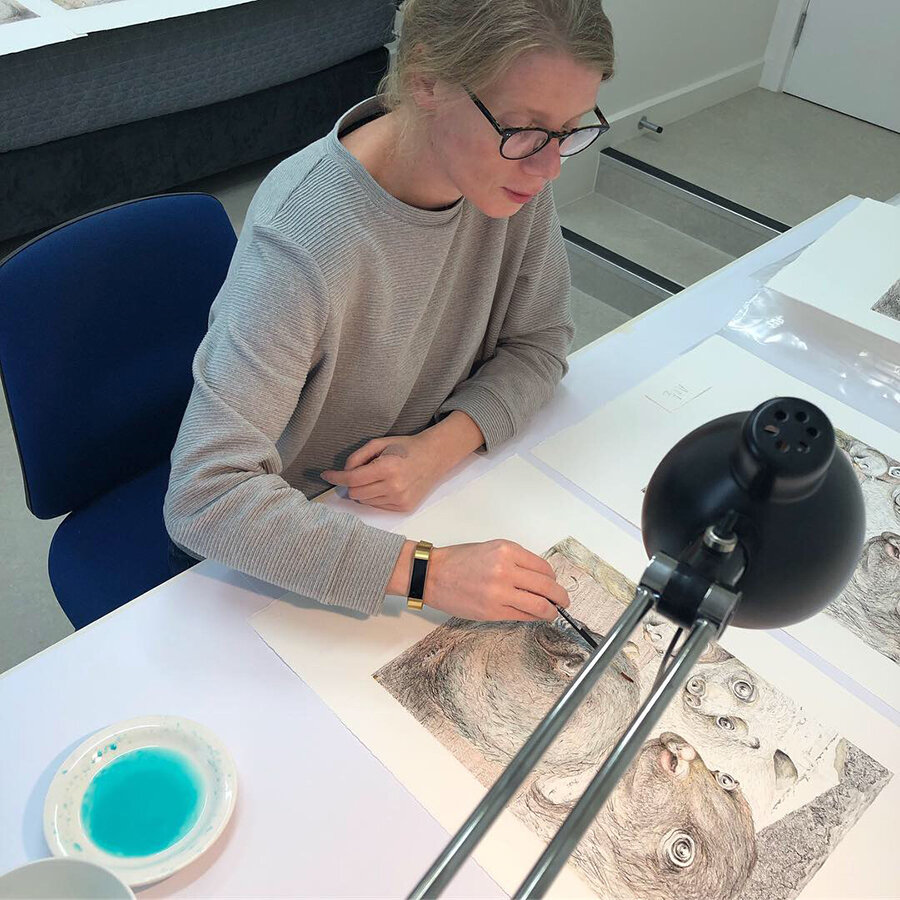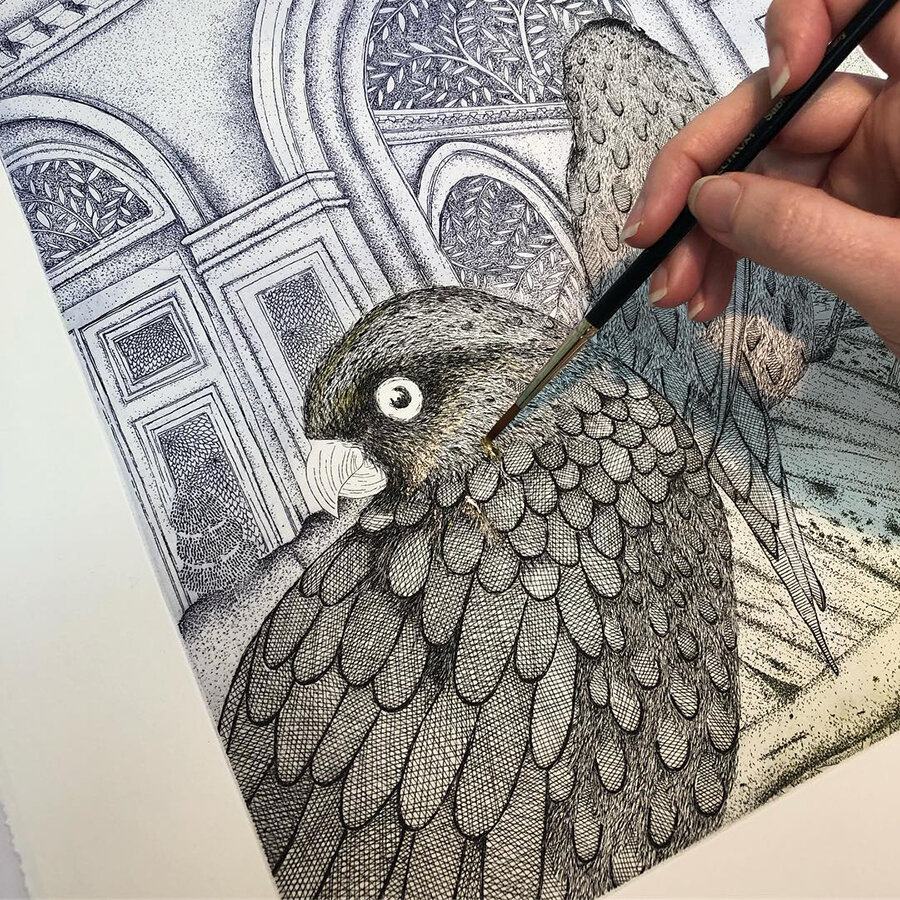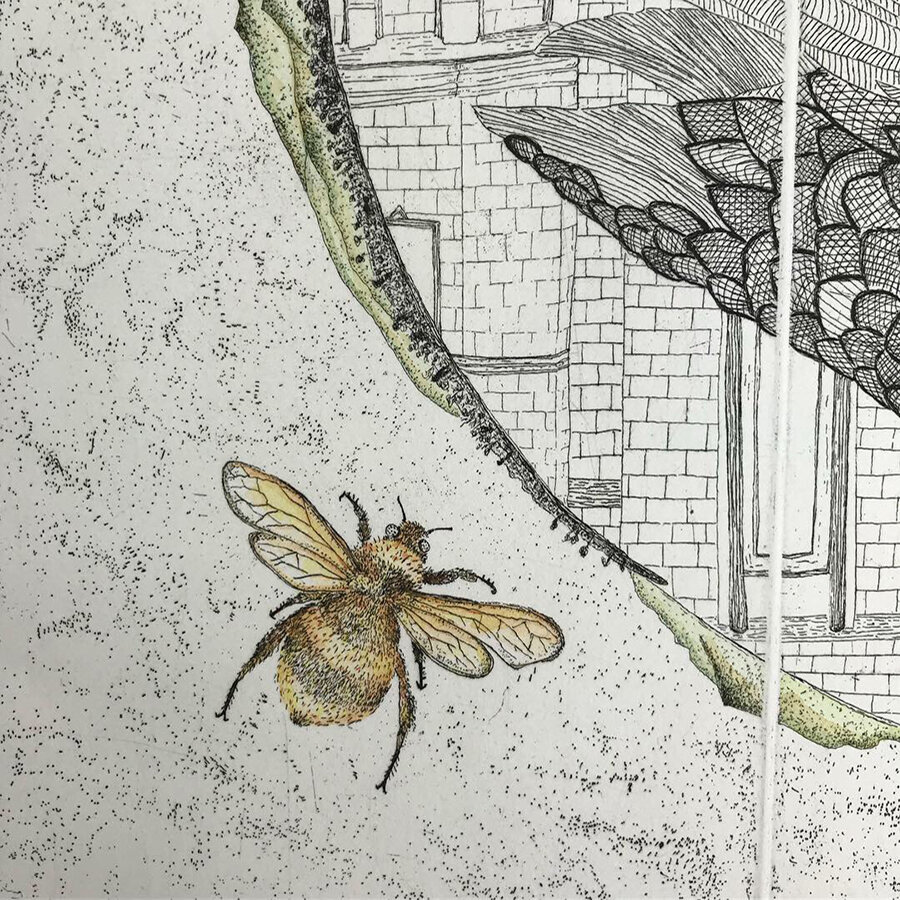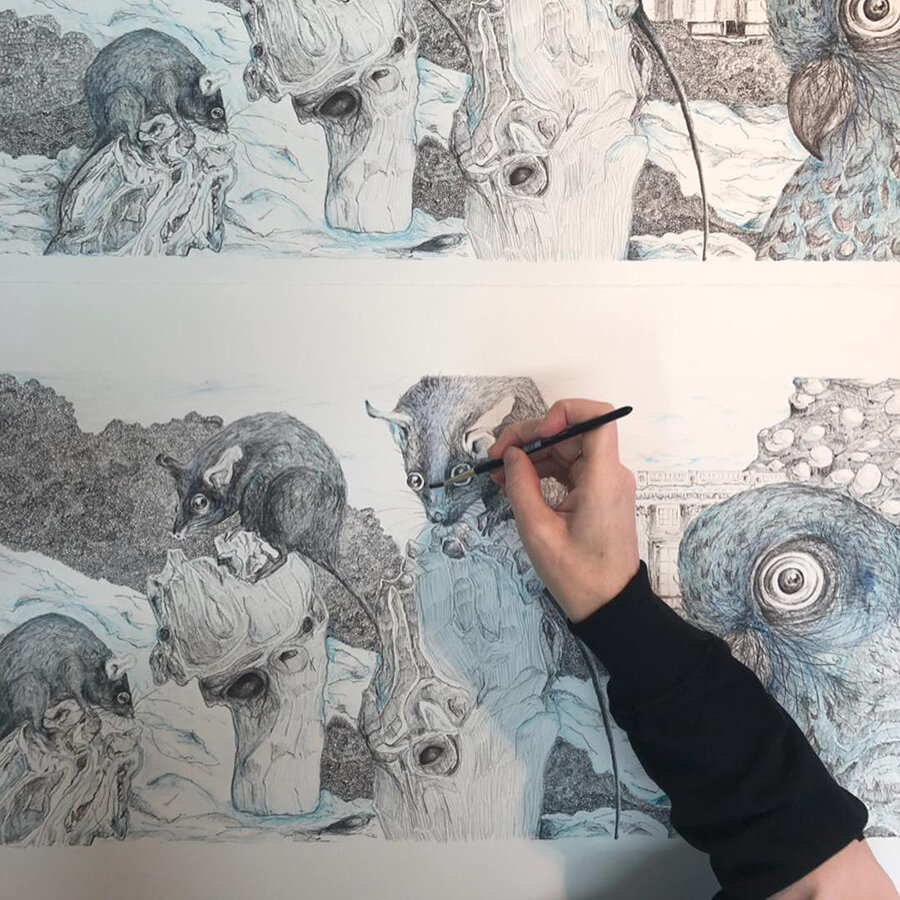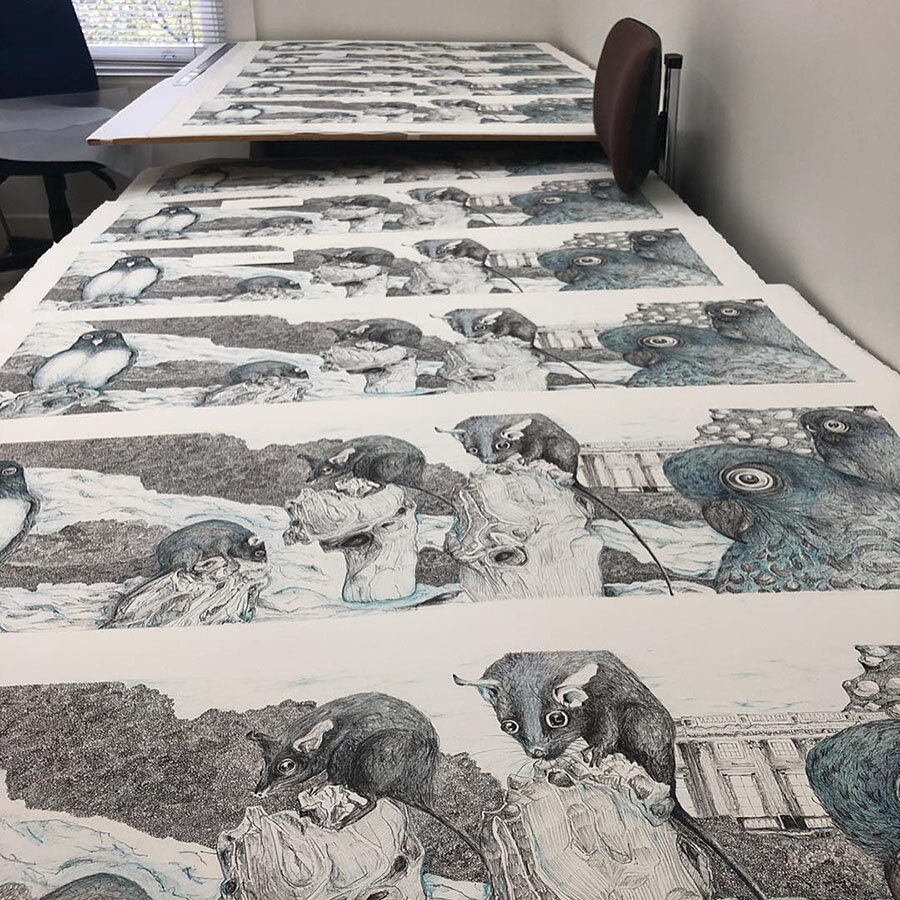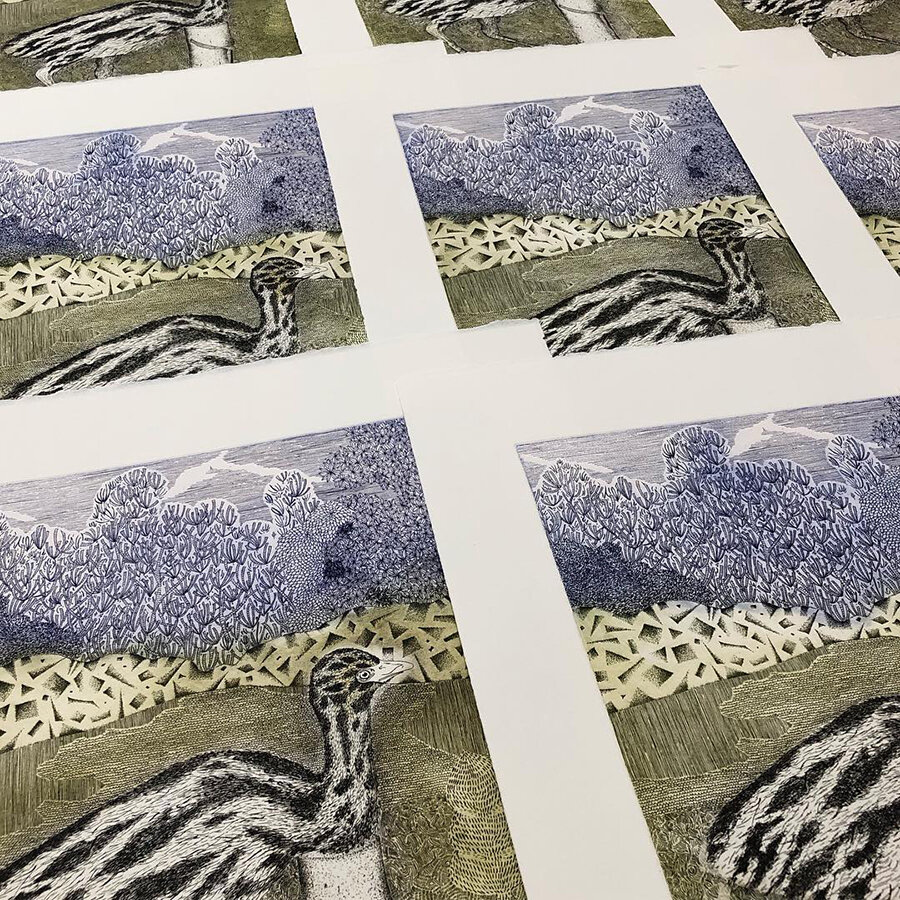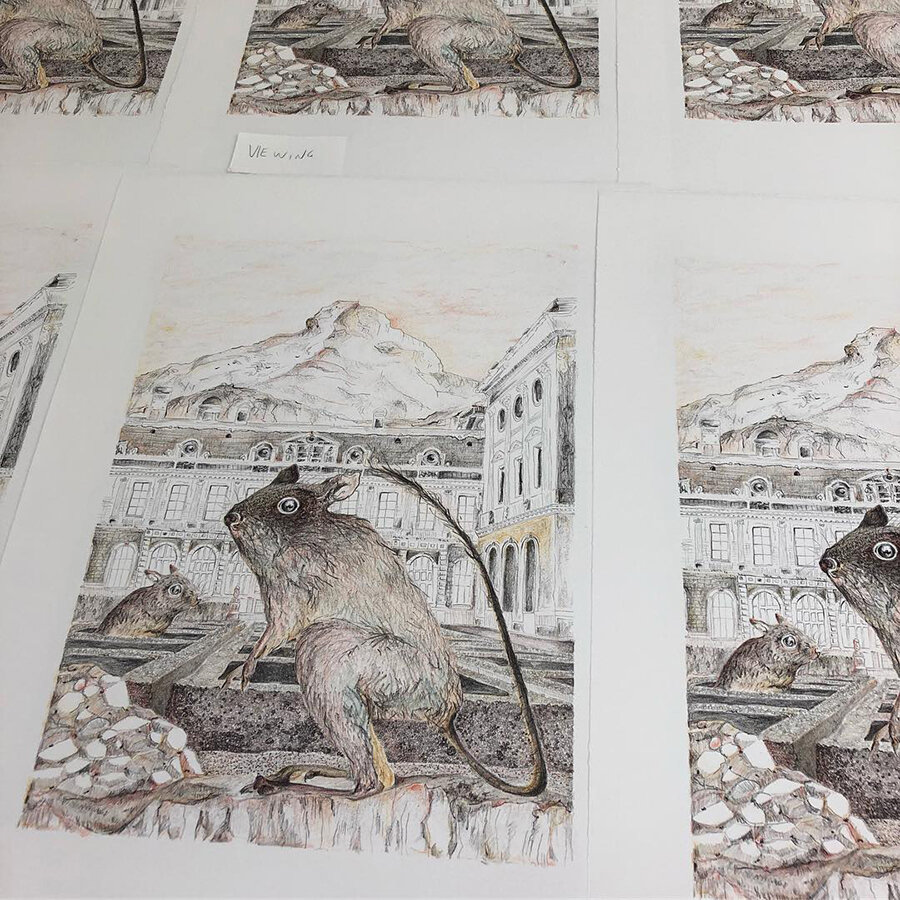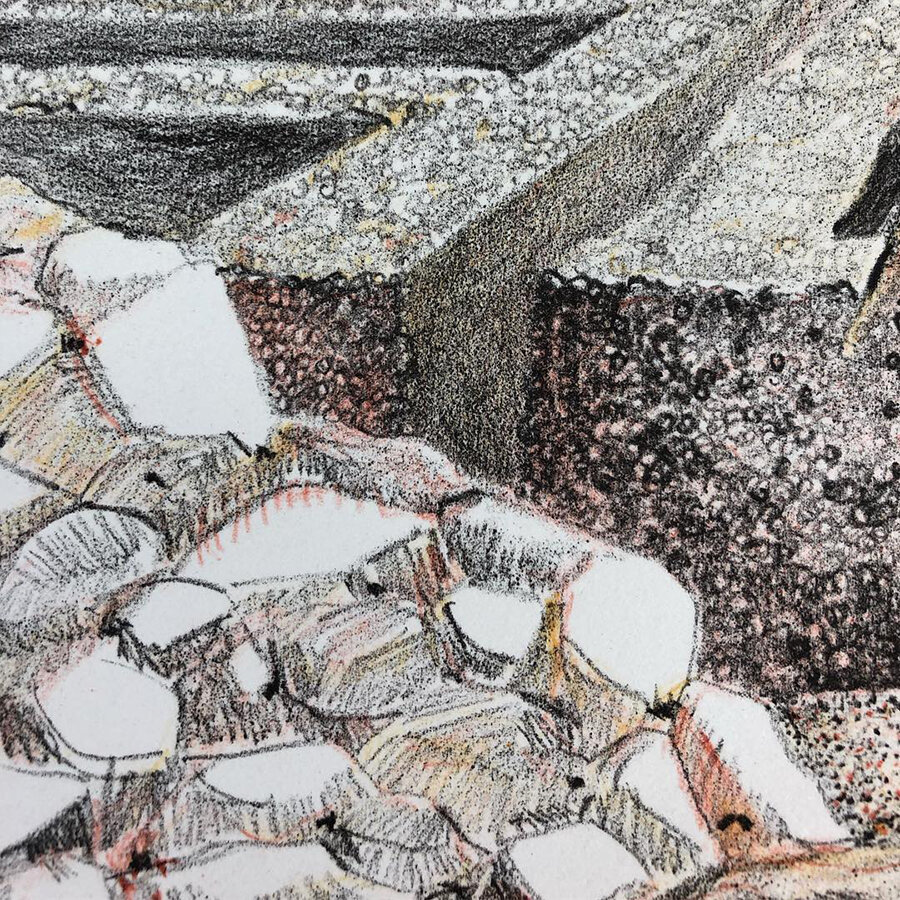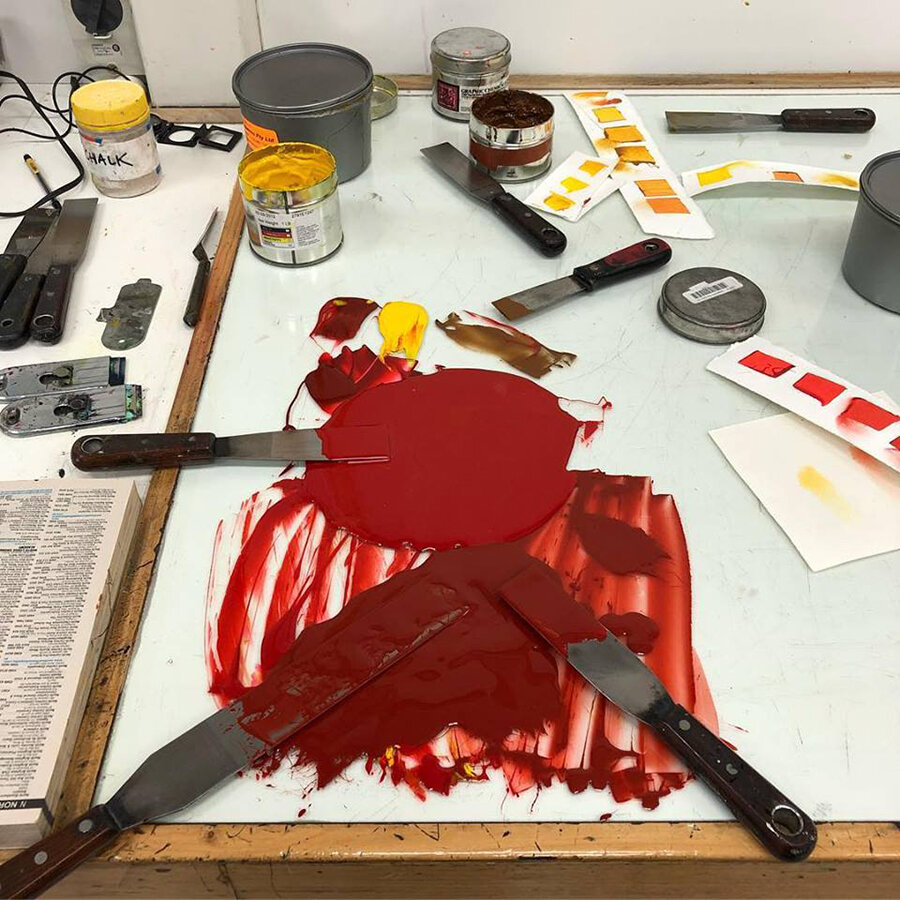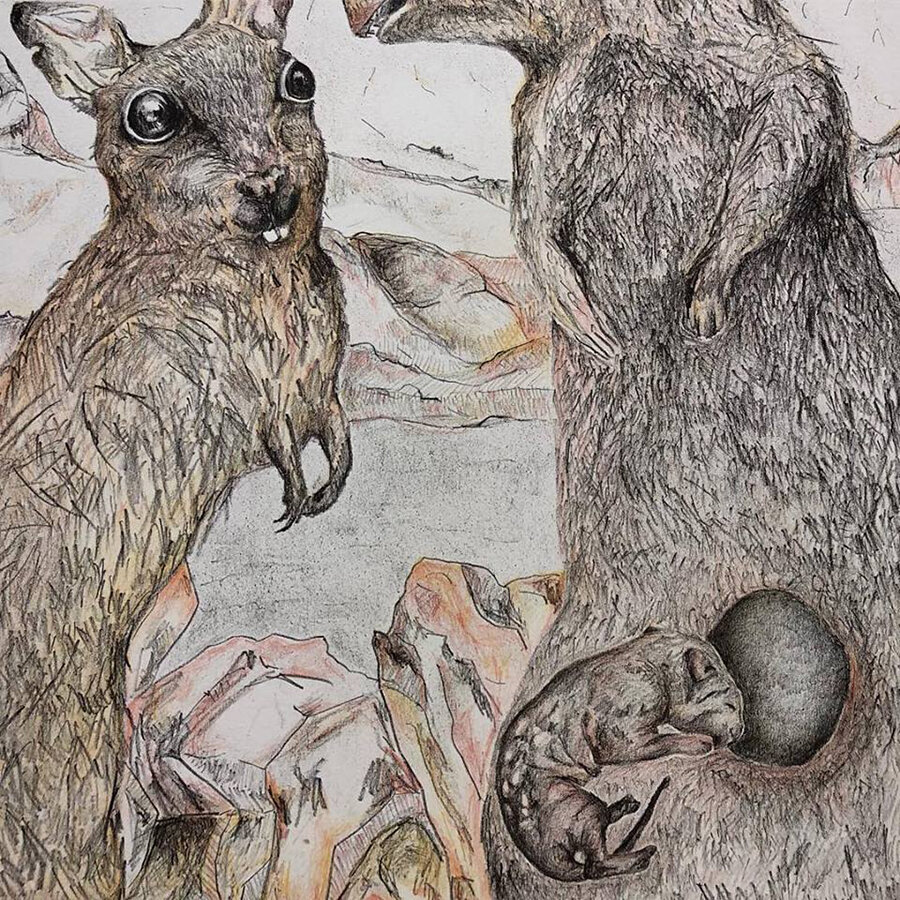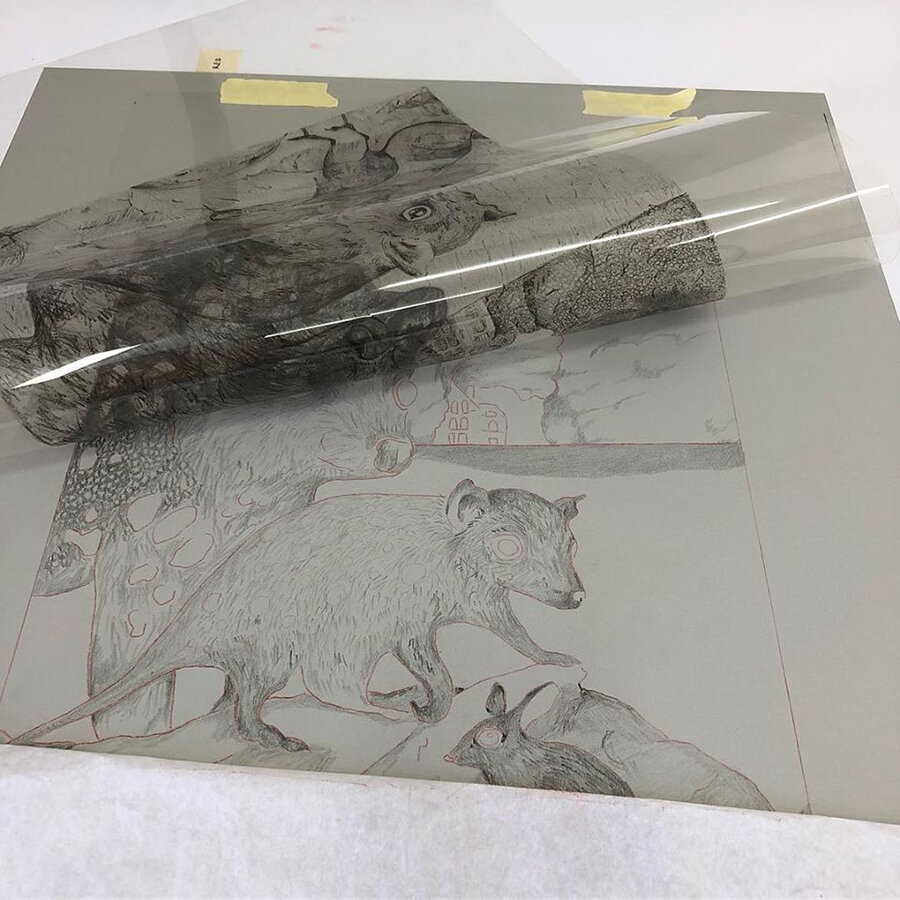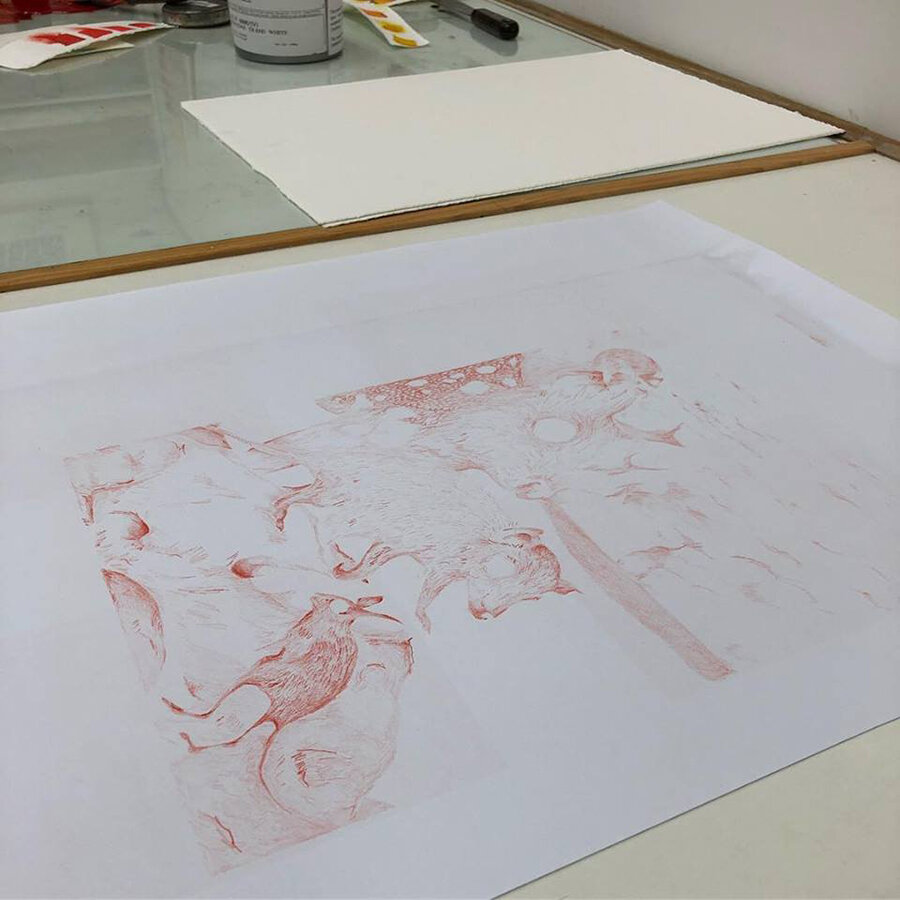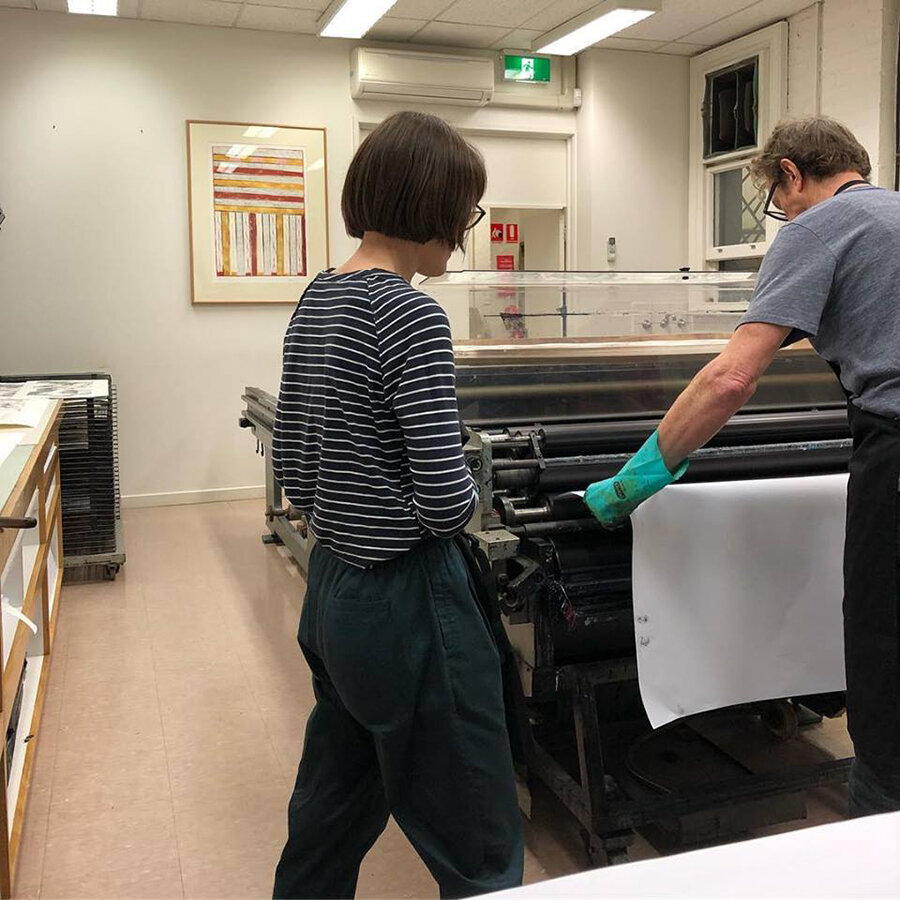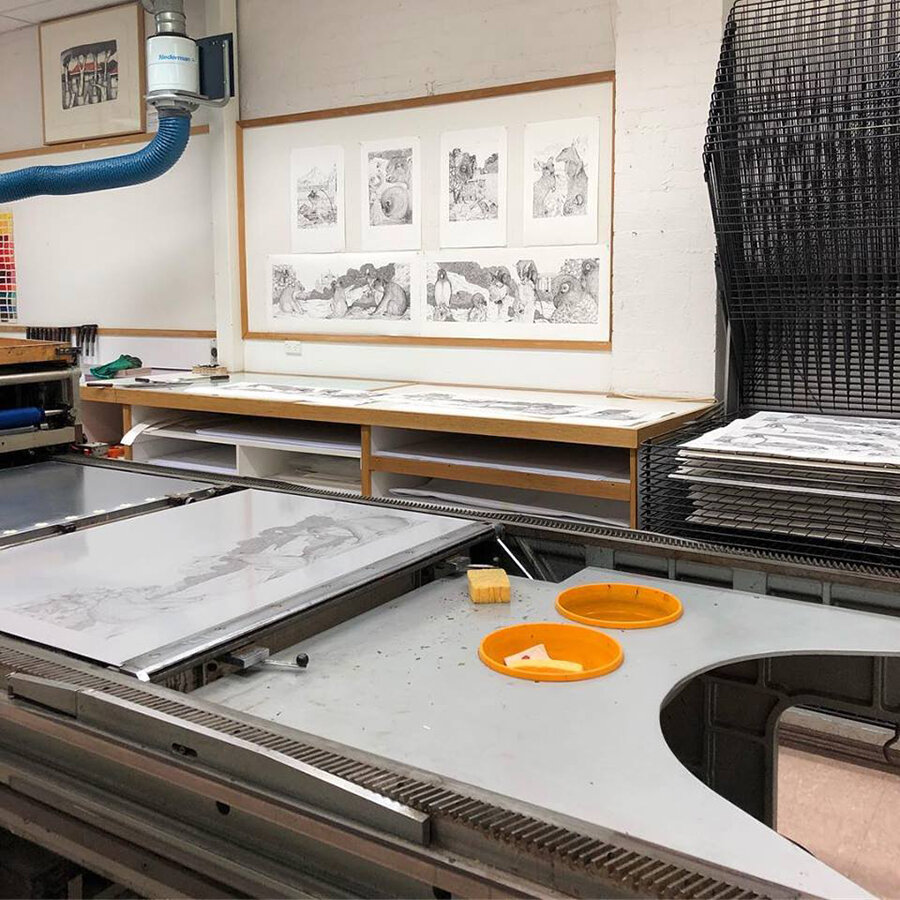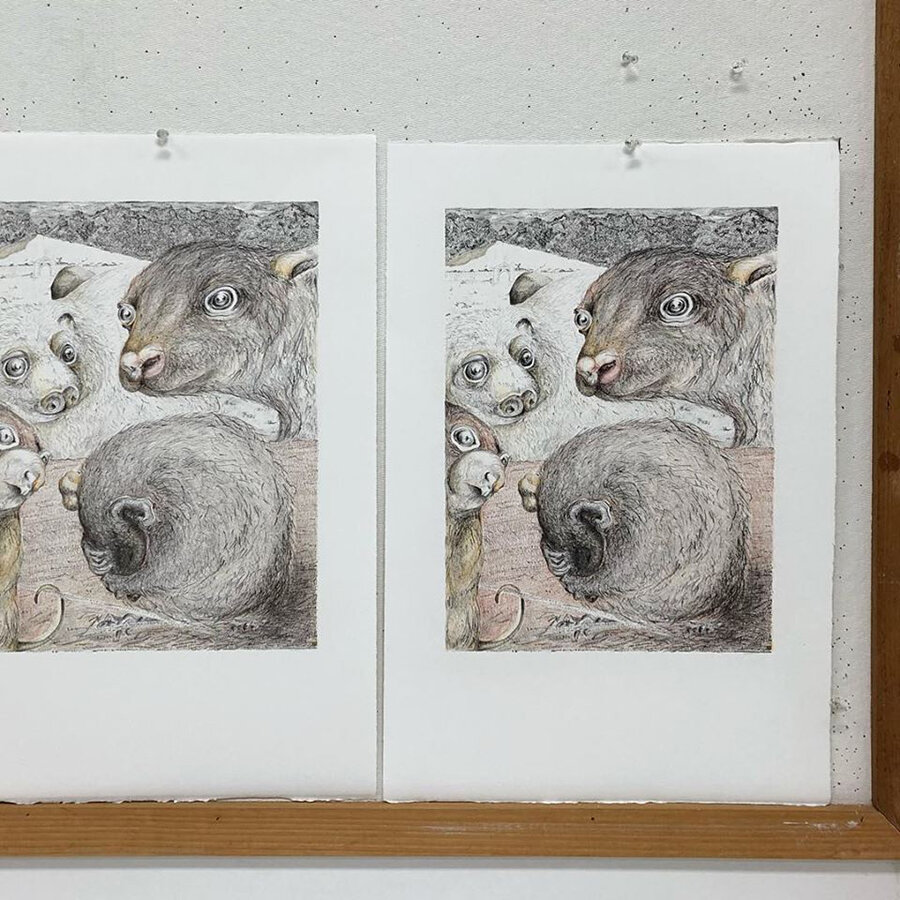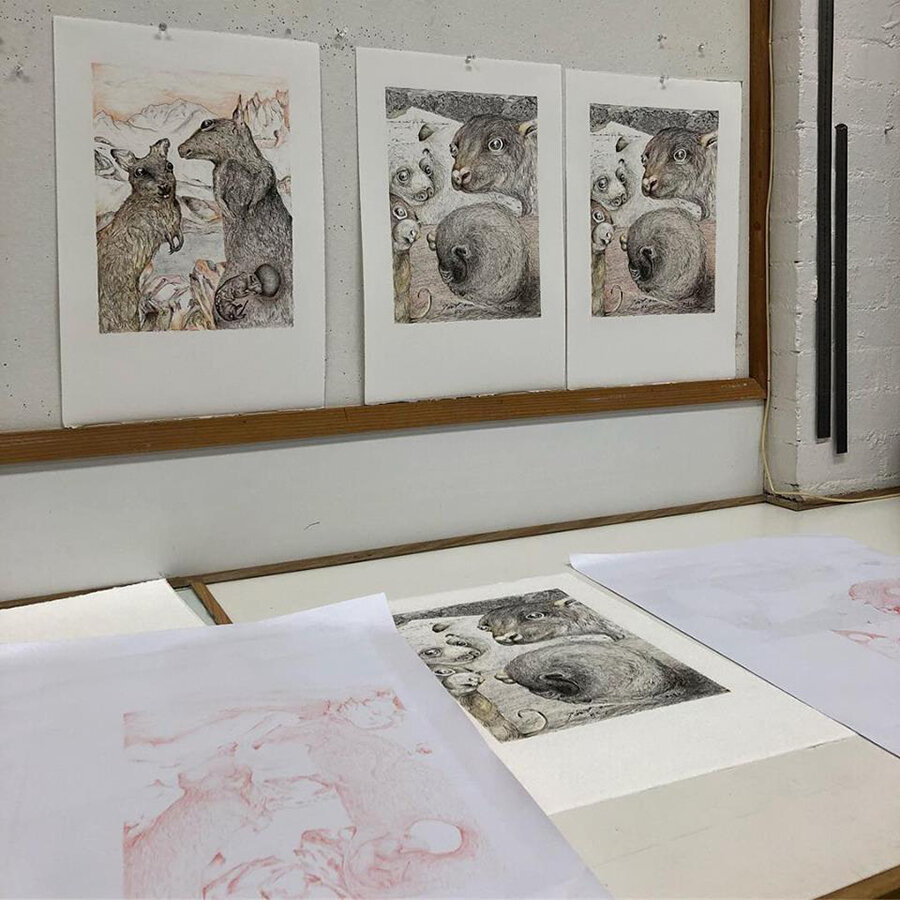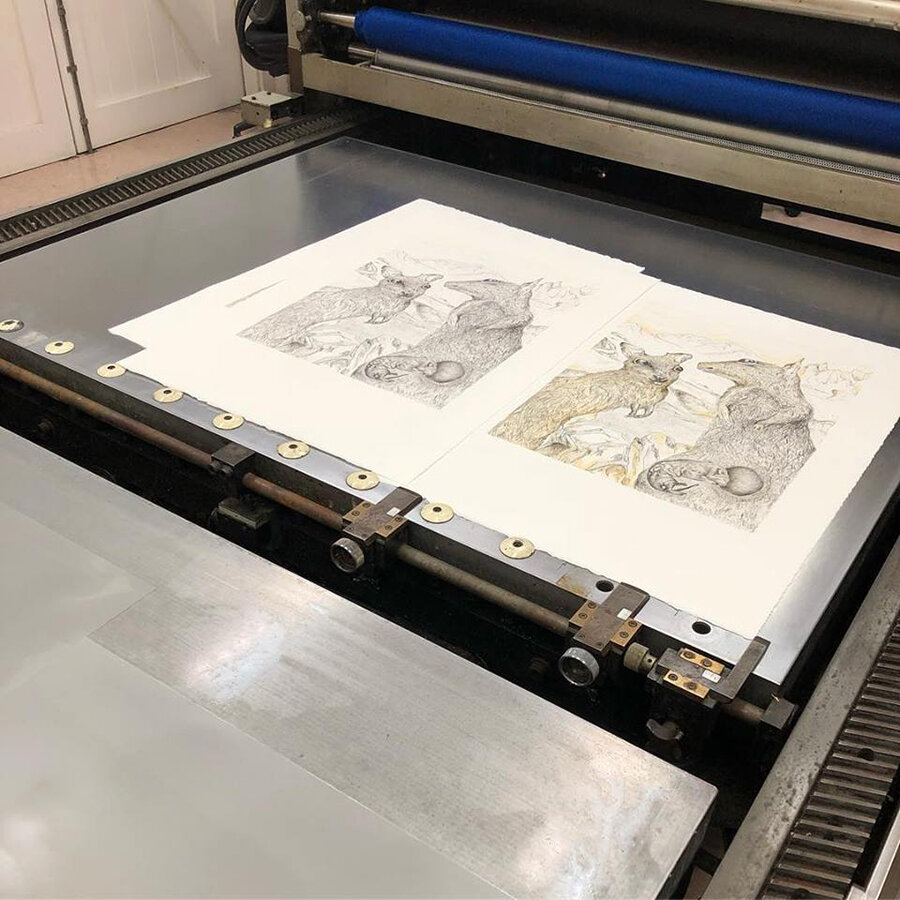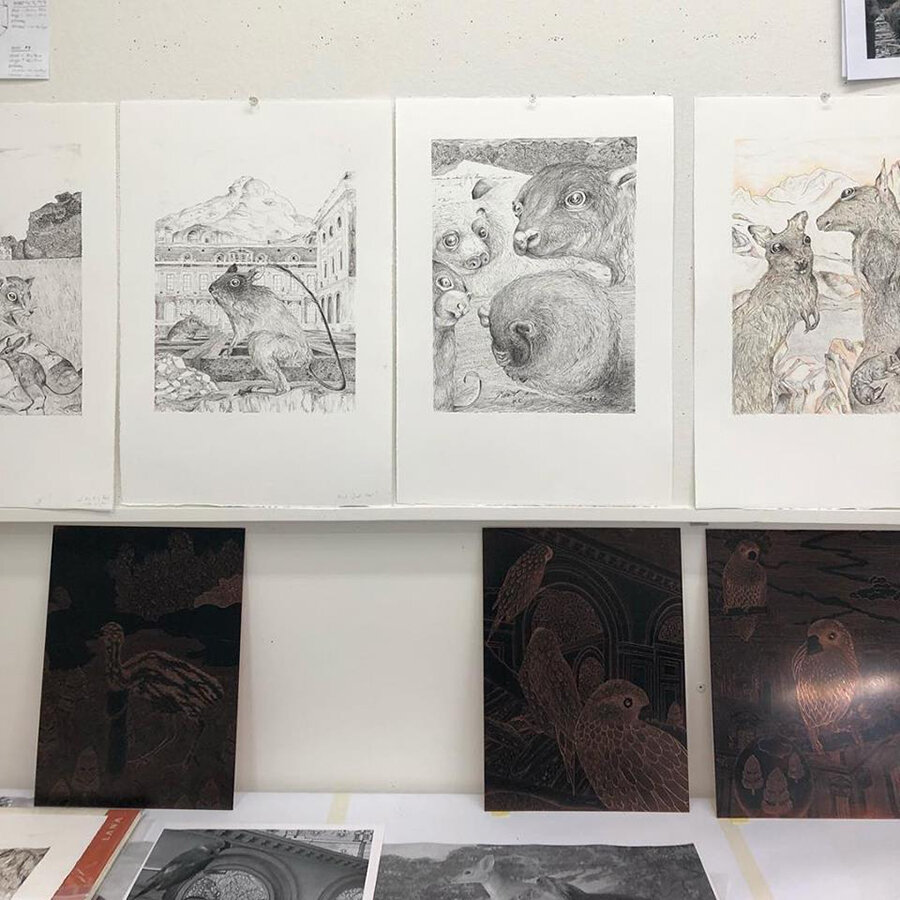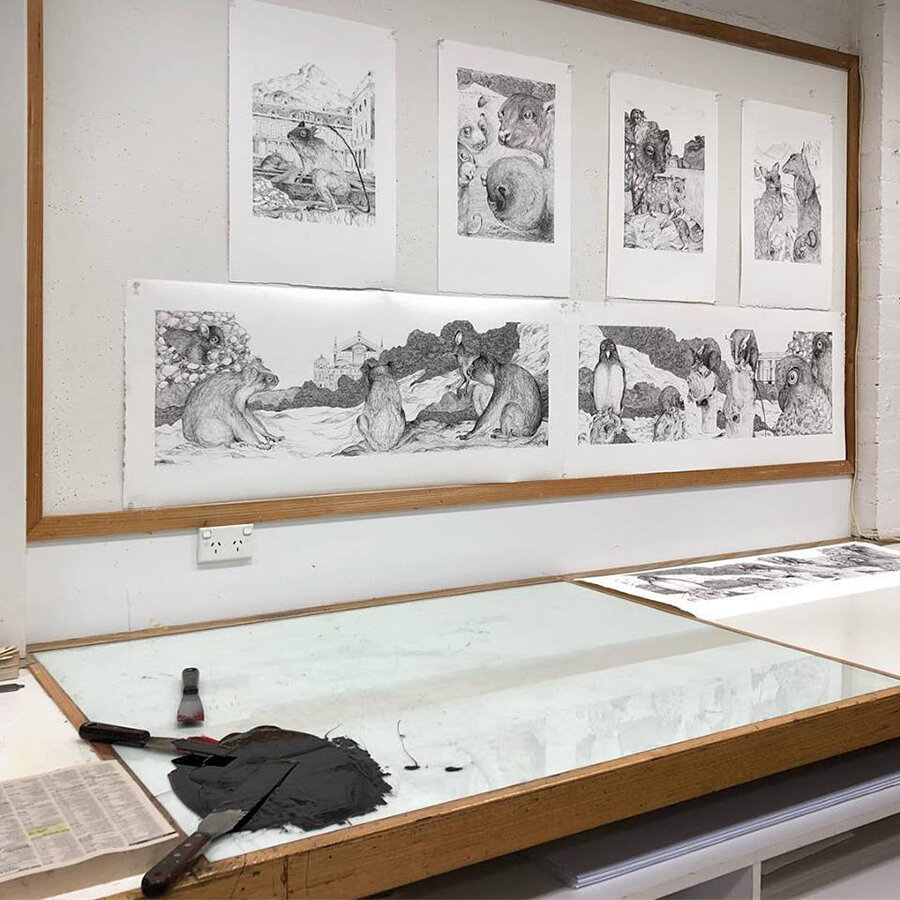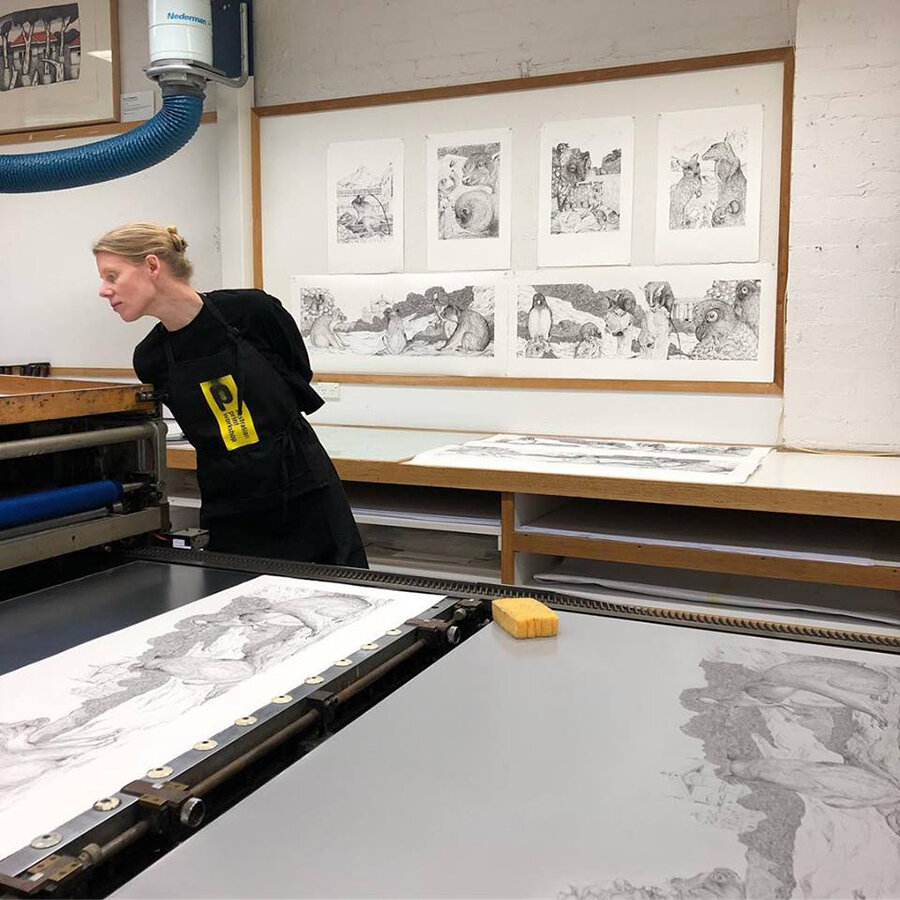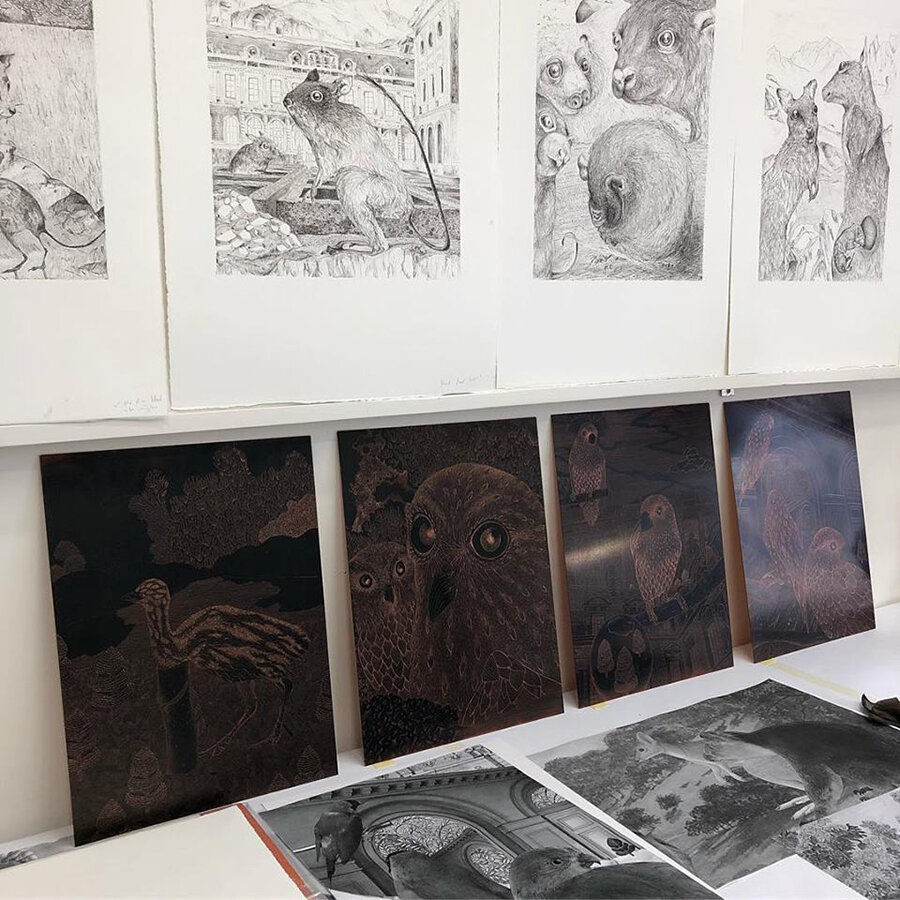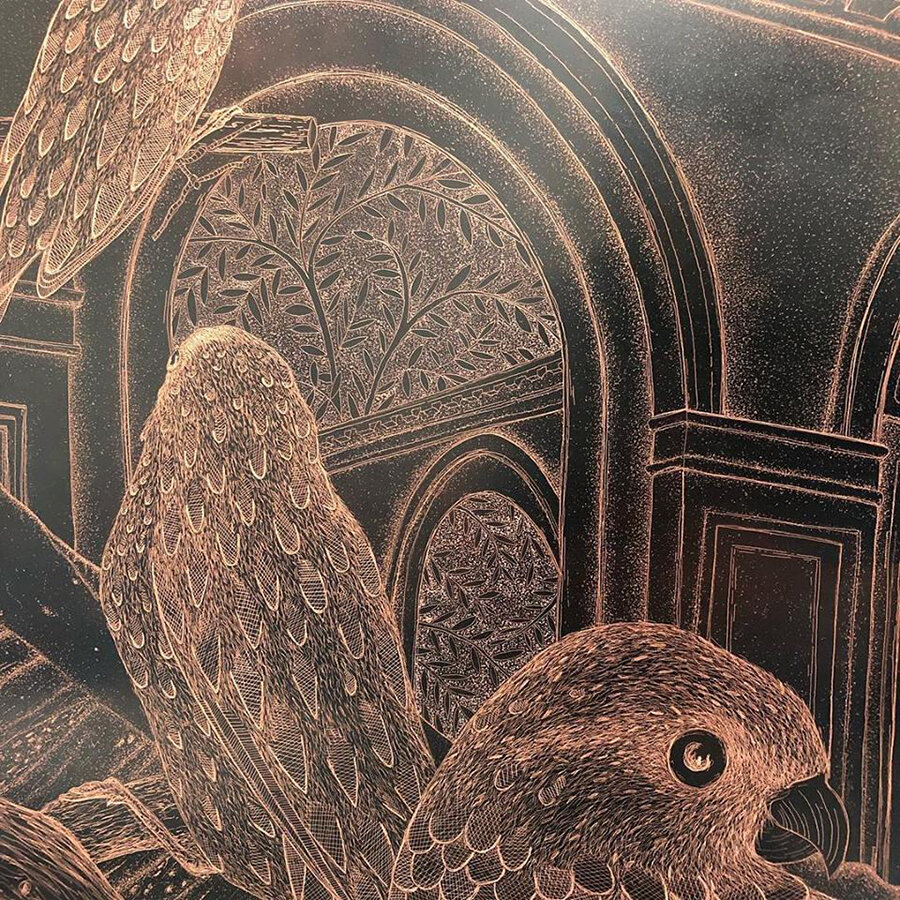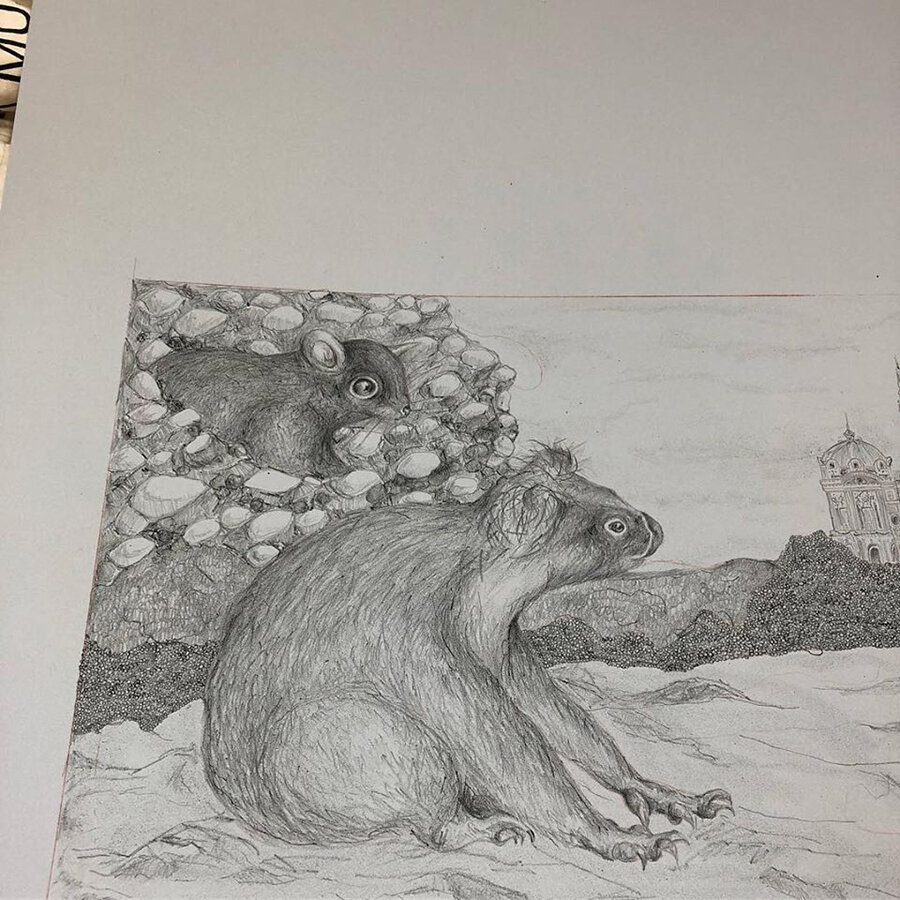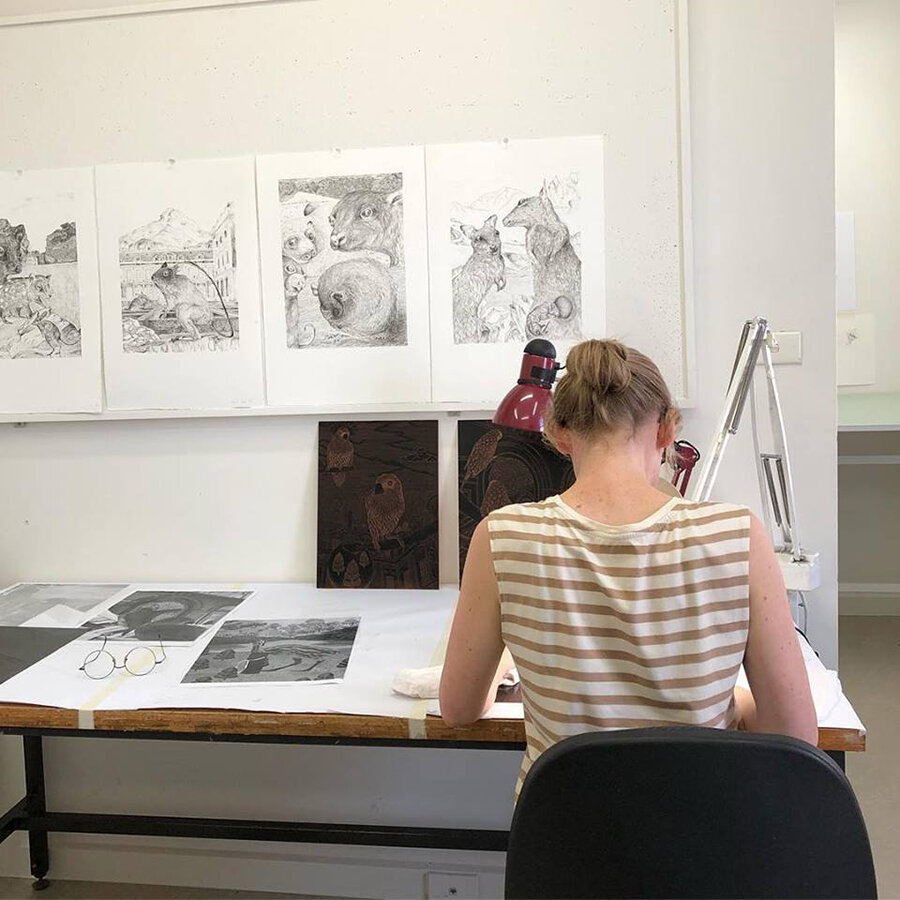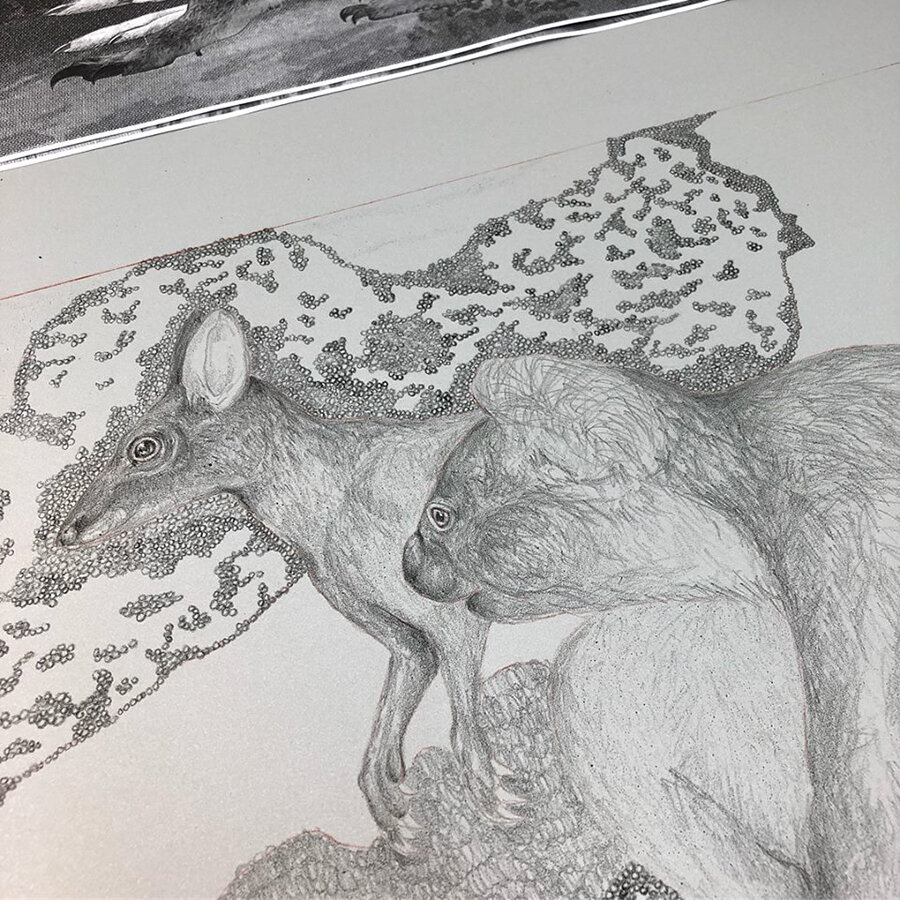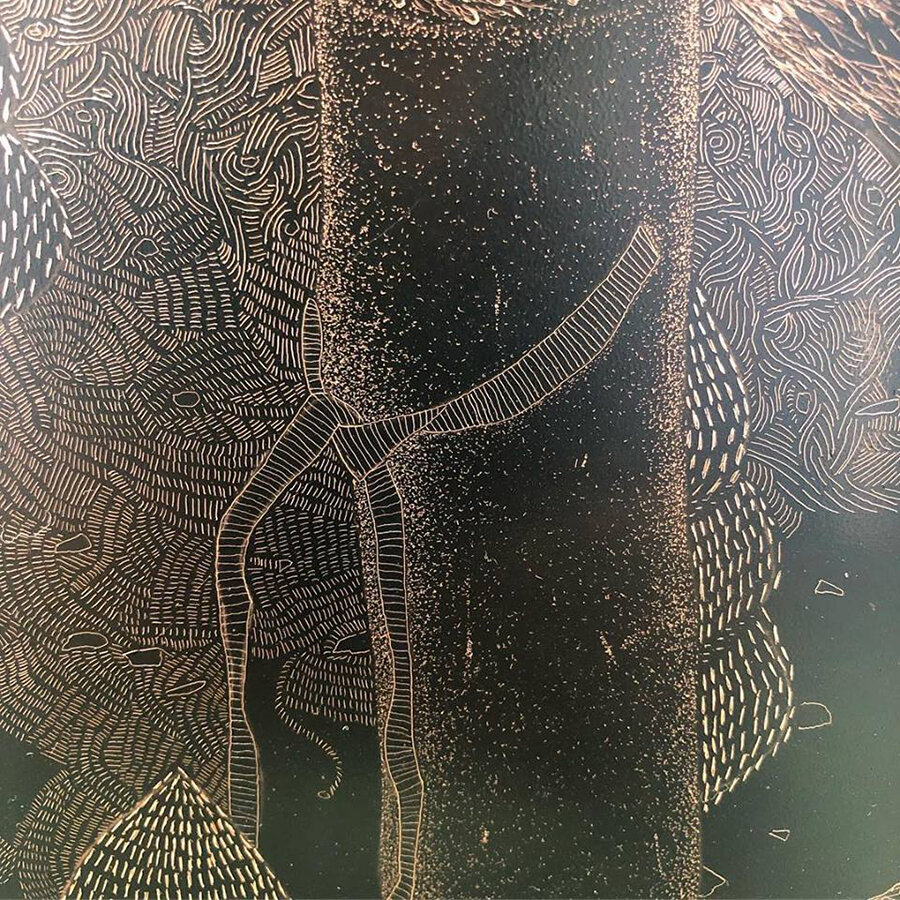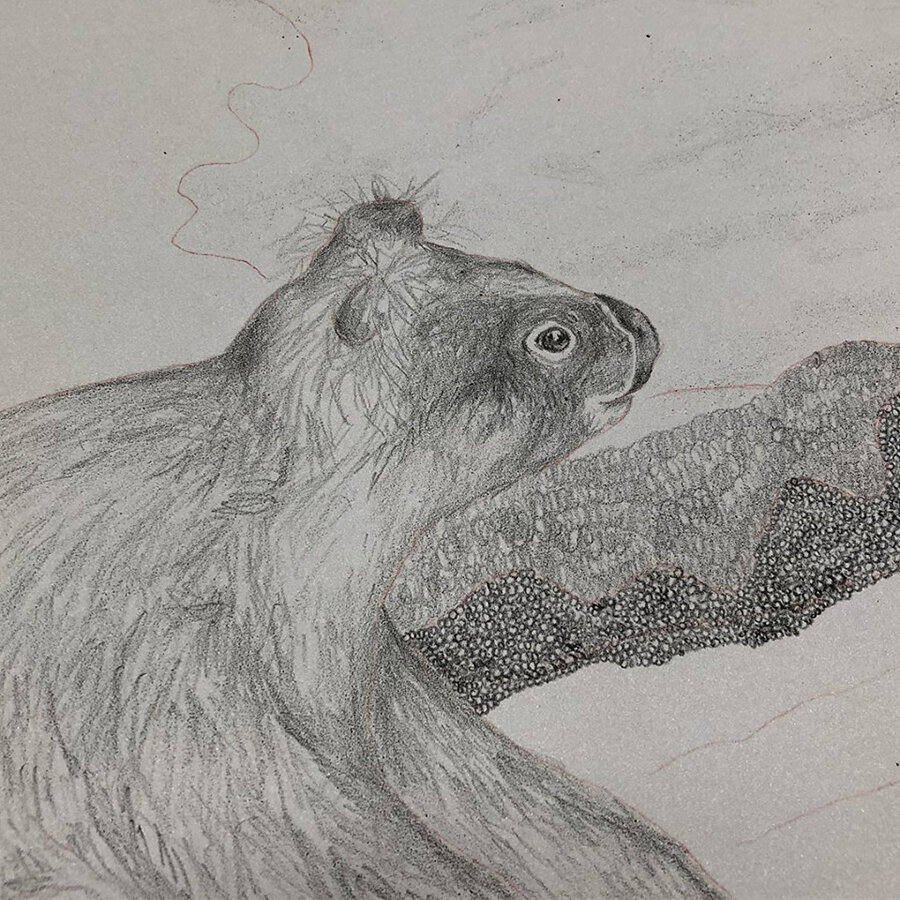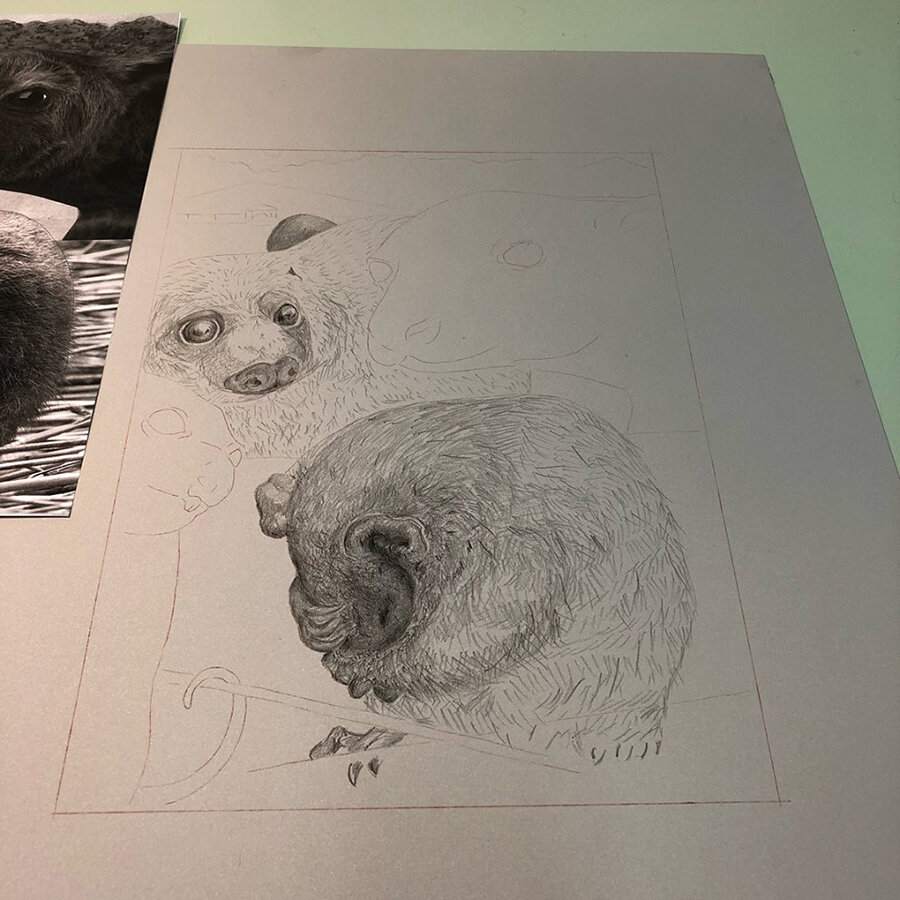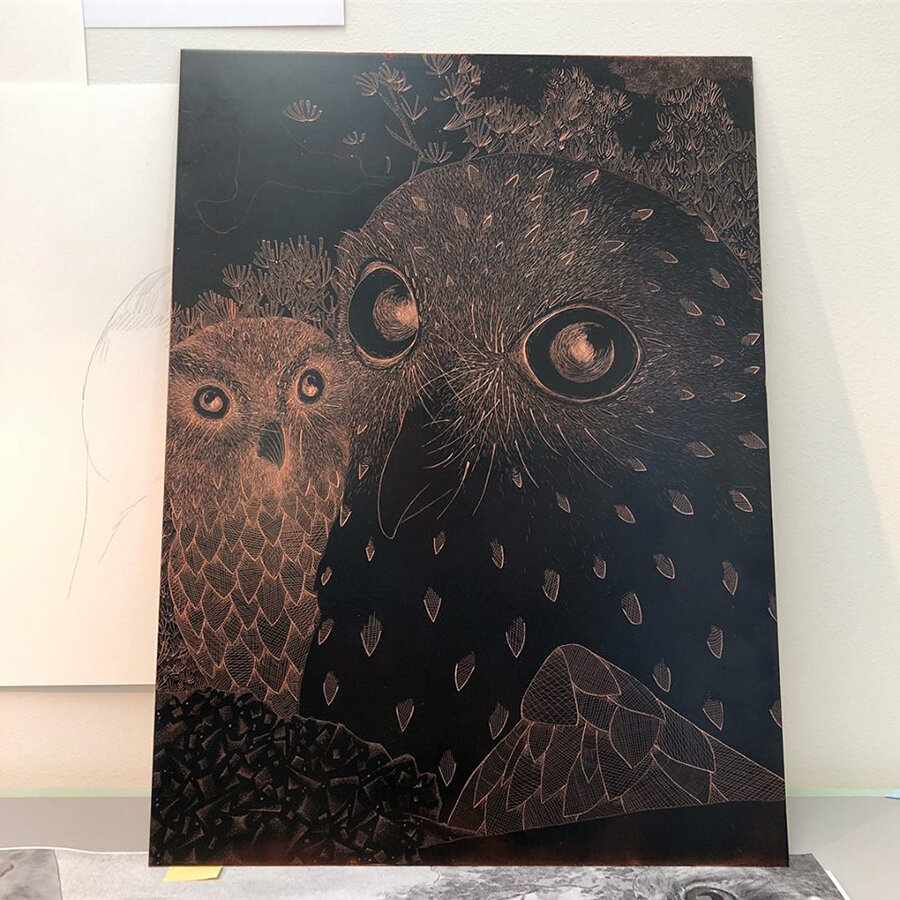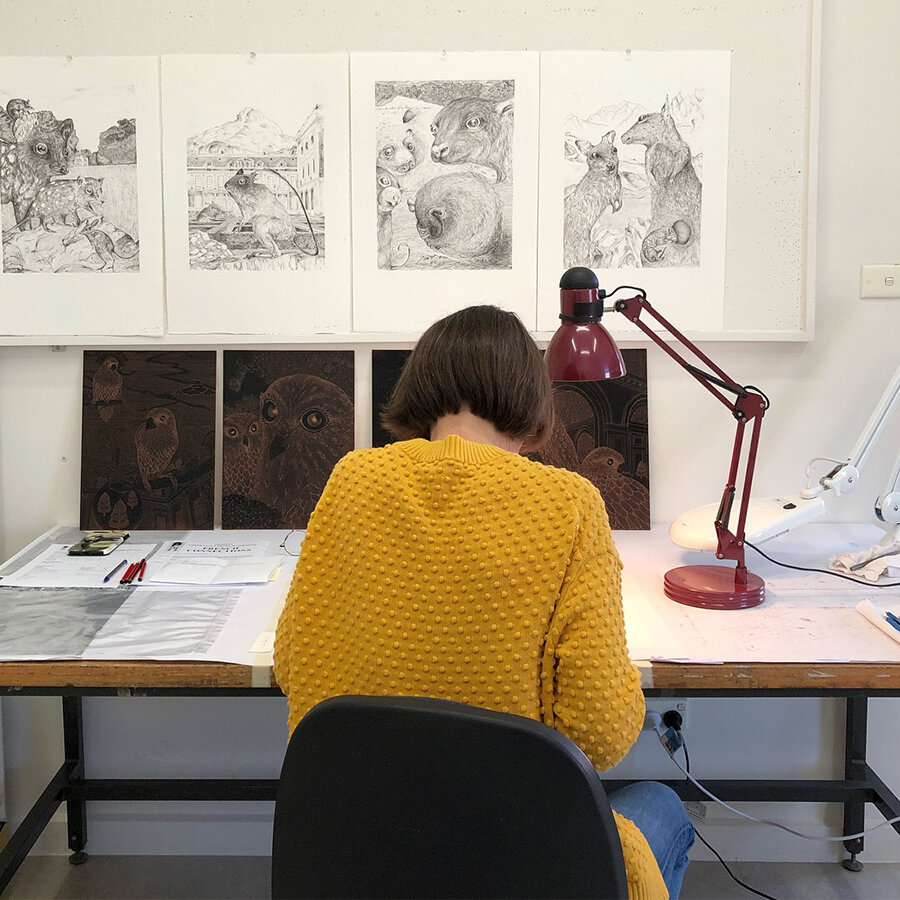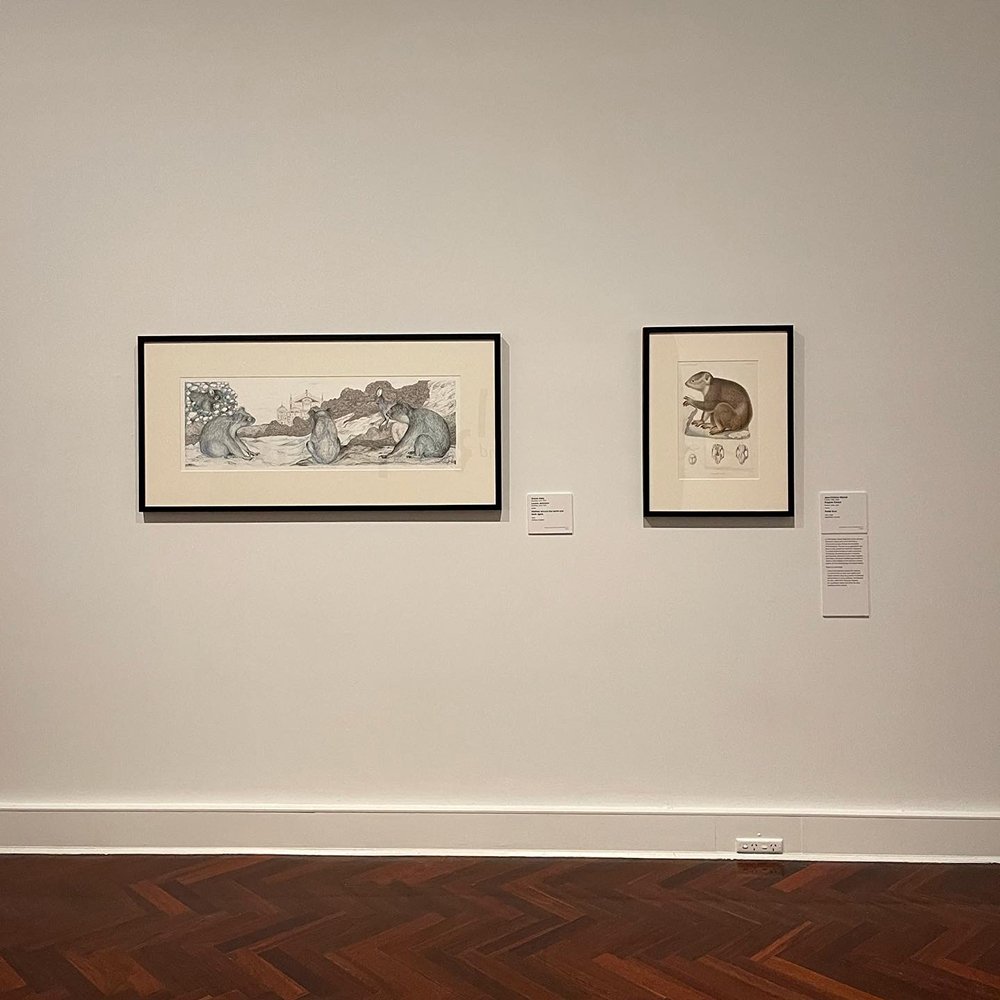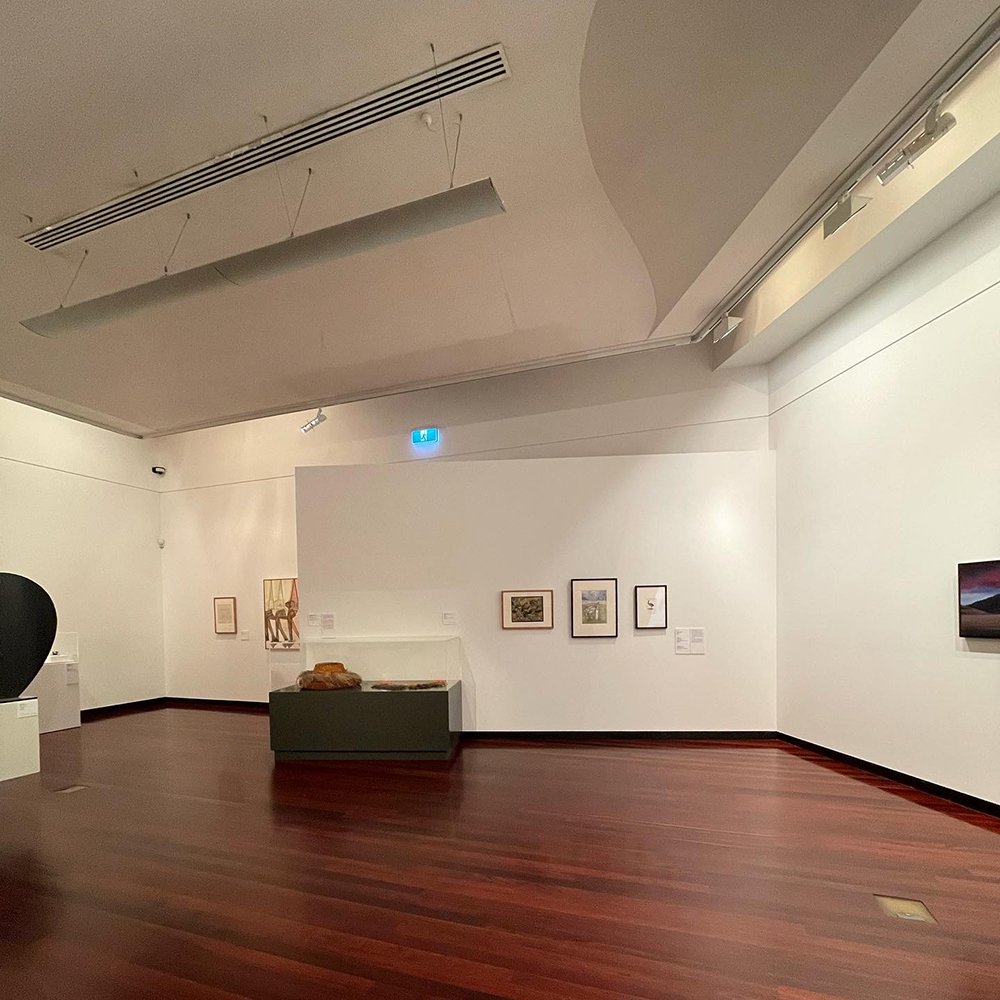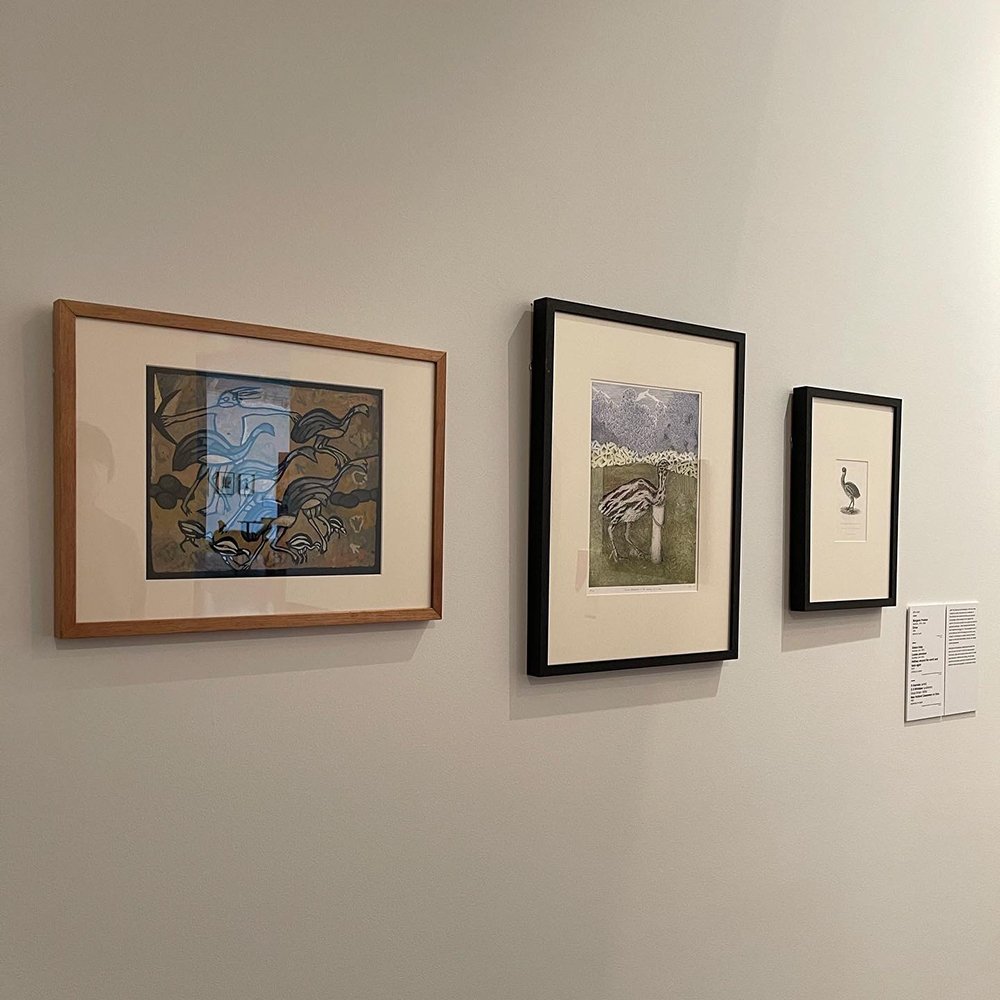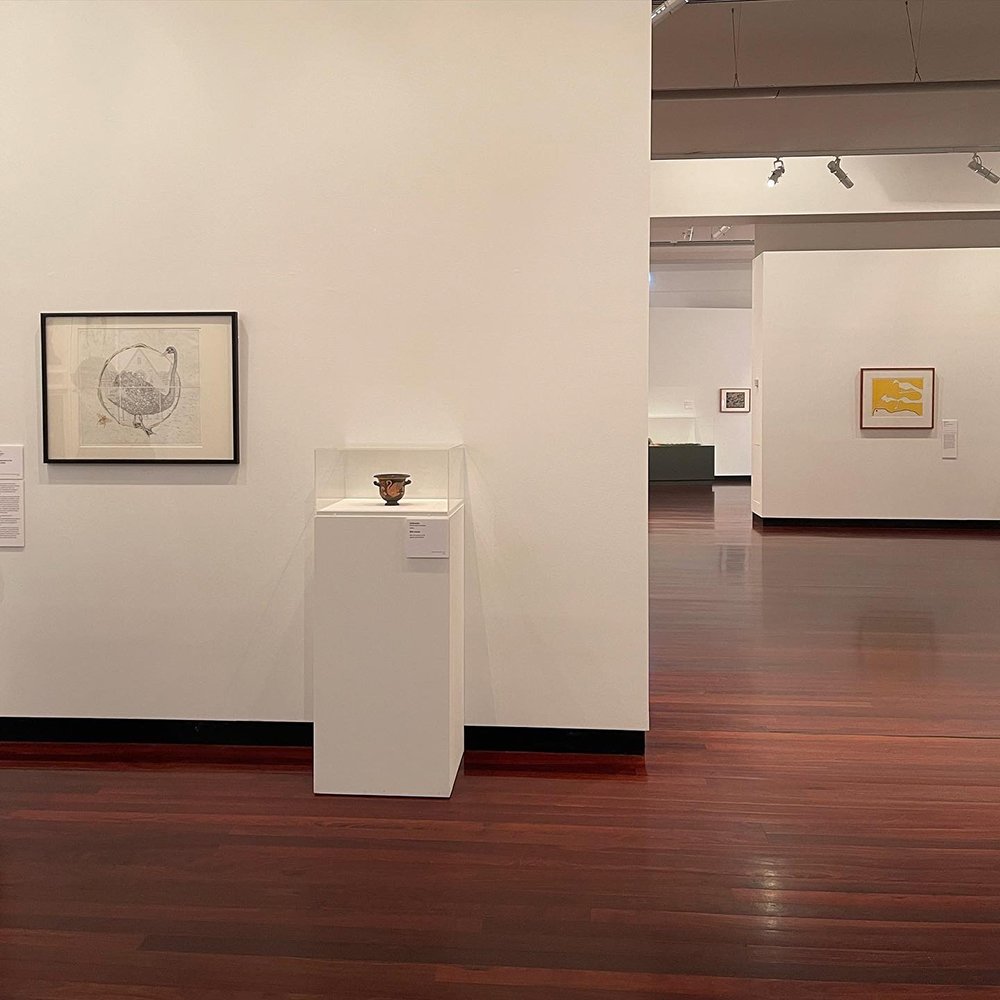THROUGH A GLASS EYE
Just as the collection reveals the collector, our prints reveal us, their very ‘stuffed’ and ‘stilted’ selection feels like a series of awkward self-portraits (of us all, perhaps). And beneath the skin, within their molecular makeup, the specimens reveal more than the mere identities of their owners.
Gracia Haby & Louise Jennison
Through a glass eye
2018–2019
Australian Print Workshop Gallery
210 Gertrude Street, Fitzroy
Saturday 1st – Saturday 29th of June, 2019
This work was produced with APW Printers at Australian Print Workshop, Melbourne, as part of Australian Print Workshop’s French Connections project curated by APW Director Anne Virgo OAM.
Various prints from this suite have been exhibited as part of Significant Others, 2023–2024, Call and response, 2022, and Dark Horse: Wild Beasts and Curious Creatures, 2020, at Art Gallery of Ballarat.
●
Australian Print Workshop is proud to present the results of a major international project French Connections, curated by APW Director Anne Virgo OAM, planned in collaboration with the National Gallery of Australia and made possible by the generous support of The Collie Print Trust.
Four leading contemporary Australian artists, Martin Bell, Megan Cope, Gracia Haby & Louise Jennison joined APW on an ambitious research trip to Paris (May 2018), to explore French Connections with our region — with a particular emphasis on the interplay of natural history, the history of science, empire, art and anthropology relating to early French exploration of Australia and the Pacific, as well as other French/Australian connections.
APW and the Artists’ privileged access to study rarely seen and highly significant collections in leading museums has informed and inspired the production of an exciting new body of work in the print medium. This is the first of a series of French Connections exhibitions at APW Gallery.
Australian Print Workshop
﹏
RELATED LINKS,
#FRENCHCONNECTIONSAPW
THROUGH A GLASS EYE CATALOGUE PDF
FRENCH CONNECTIONS, INTERNATIONAL PROJECT, APW
KEEP A BEADY EYE ON
REEL 2020–2025
RELATED POSTS,
BIRDS, WE’RE CURIOUS FANS
Q & A
FLUTTERING STROKES ON THE PLATE, STILL
OF PINK MARBLE AND PORPHYRY
FILE UNDER ‘EYE’
KEEP AN EYE ON
IN THE MUSEUM
WATERCOLOUR AND PENCIL, BLUE, GREEN, MORE
WHIRR AND CHIME
IN THE DIRECTION THAT ONE IS FACING
A SERIES OF STEPS
FRENCH CONNECTIONS, PART 1
FRENCH CONNECTIONS, PART 2
FRENCH CONNECTIONS, PART 3
FRENCH CONNECTIONS, PART 4
FRENCH CONNECTIONS, PART 5
FRENCH CONNECTIONS, PART 6
FRENCH CONNECTIONS, PART 7
(POST) FRENCH CONNECTIONS, PART 1
(POST) FRENCH CONNECTIONS, PART 2
(POST) FRENCH CONNECTIONS, PART 3
(POST) FRENCH CONNECTIONS, PART 4
Contemplating marble, stucco, velvet, and gilding, Grande Perspective in the memory of a swan, and Halfway around the world and back again were acquired by the Art Gallery of Ballarat, and have since been exhibited in Dark Horse: Wild Beasts and Curious Creatures (2020) and Call and response (2022).
Through a glass eye
Gracia Haby & Louise Jennison
Least Concern (Population stable)
Black swan (Cygnus atratus)
Common spotted cuscus (Spilocuscuc maculatus)
Dusky antechinus (Antechinus swainsonii)
Emu (Dromaius novaehollandiae)
Herbert River ringtail possum (Pseudochirulus herbertensis)
Powerful owl (Ninox strenua)
Red kangaroo (Macropus rufus)
Spinifex hopping mouse (Notomys alexis)
Superb parrot (Polytelis swainsonii)
Western pygmy possum (Cercartetus concinnus)
Least Concern (Population decreasing)
Eastern pygmy possum (Cercartetus nanus)
Winking owl (Ninox connivens)
Near Threatened (Population stable)
Bennett’s tree-kangaroo (Dendrolagus bennettianus)
Gouldian finch (Erythrura gouldiae)
Western quoll (Dasyurus geoffroii)
Vulnerable (Population decreasing)
Fawn hopping mouse (Notomys cervinus)
Koala (Phascolarctos cinereus)
Critically Endangered (Population decreasing)
Leadbeater’s possum (Gymnobelideus leadbeateri)
Extinct
Eastern hare-wallaby (Lagorchestes leporides)
Last recorded sighting: 1889
The fleet-of foot Eastern hare-wallaby, also known as the Common hare wallaby, is an extinct species of wallaby that was native to the inland plains of southeastern Australia. “John Gould recorded that one animal, which had been chased by his dogs for half a kilometre ‘suddenly doubled and came back upon me .… I stood perfectly still and the animal had arrived within 20 feet before it observed me, when …. instead of branching off to the right or left; it bounded clear over my head’”[i].
“As soon the question “What is lost?” is posed, it invariably slips into the question “What remains?” …. loss is inseparable from what remains, for what is lost is known only by what remains of it, by how these remains are produced, read, and sustained”[ii].
As we wandered through Le musée Fragonard, a museum of anatomical oddities and dissections, mounted and spirit specimens, and educational models, located in the École nationale vétérinaire d’Alfort, Maisons-Alfort, France, we thought about all of the animals immortalised in the collection, now with a timber base for earth and glass for sky.
We thought about Sir Joseph Banks’ description of a kangaroo “as large as a grey hound, of a mouse colour and very swift”, which “jumped like a Hare” on two legs, “making vast bounds”[iii]. Before drawers like a confessional, we thought about how “the classification of animals, like that of any group of significant objects, is apt to tell as much about the classifiers as about the classified”[iv].
Before a forest of bronchial trees arranged by scale, with the tiny branched apparatus of a rabbit on display at the front and that of a cow located towards the back, we thought about the shared vulnerability of all living things.
Coiled in jars, a movement of snakes. Suspended in a Sleeping Beauty dream state, a mausoleum of small rodents on the shelf below. Caught mid-leap, a rabbit now forever ready. Six-legged lambs, a cat with an upward spiked spine, a calf with two heads, two lambs joined at the torso in a sad dance on the other side of the glass. In museum collections, where “each individual is only perceived as a token of its inexhaustible taxonomic type”[v], mute remains are anything but. This troupe was a dawn chorus, just like those heard deep and full at the Jardin des Plantes, where cabinets of bones both encased in and stripped of feathers were all labelled with care in a neat cursive script. The immensity of collection; “the enormity of killing”[vi]. (Now, the decision to collect is based on “whether the collection harms the species itself, furthering its overall demise in an area, and …. the ethics of euthanizing a living creature for the advancement of science”[vii]. The importance of recording.)
Looking at forms removed from context or shown en masse offered new readings, and as such a tall case of horses’ teeth reminded us of the soles of human feet (which later became a crown for Two views of a Gouldian finch before a combined view of the Hôtel de Soubise and Hôtel de Guénégaud[viii]). A series of jaw bones shown in profile looked like the sandalled feet of Greek statues; tiny bat skeletons whispered the fragility we know to be held under the skin; and a painted model of a cross section of a snail, which was ballooned to the size of a small dog, revealed the maker’s relish for rendering the differing tactility of working parts.
The temporal region of the skull is blue, whether you are a lapin, a chien, a mouton, or a kangourou, and it is situated in both cerebral hemispheres of the mammalian brain. For hearing and balance, from the Latin word ‘tempus’ or time, it responds to poetry, presumably in all forms. The poetry the rabbit favours might be quite different to ours, but not necessarily so. And since visiting Le musée Fragonard, whenever we rub our temples we picture them blue like the painted skulls on display. Colour maps beneath the skin, making distinct regions comprehensible. This is how we, of Linnean[ix] descent, now catalogue our own world of understanding. We, too, are “‘just’ collections of atoms [albeit still] moving around in accordance with the laws of physics”[x].
From here, we opened the cabinet door, and released a glass-eyed menagerie upon the page. Not rare, but there, save one. First as an idea, then as a collage, before finally pausing as a drawing from which an impression could be made. In these etchings and lithographs before you now, an assemblage of Australian animals in an ill-suited environment. Created in the memory of pressing our noses to glass before a Thylacine specimen, beholding a “liminal creature …. a radical little boundary crosser: both intimate and strange, creaturely and objectified, profoundly dead and holding out the promise of futurity”[xi].
As such, the Empress Josephine’s Black swan appears in present-day Paris, within a drop anchor watercolour inspired by the cartography of Nicolas Baudin[xii] (on six plates we carried Halfway around the world and back again before drawing on); a nimbus fashioned from a hoop of Australian coastline found within des Archives nationales. A pair of Western quolls, a Fawn hopping mouse, and an Eastern pygmy possum still roam the grounds of the Château de Malmaison[xiii]. And perhaps you can hear a Superb parrot and two views of a Gouldian finch On a perch of “cheval usure des dents”, chirping[xiv] in the billiards room repainted in tones of green and Egyptian earth.
Over in Versailles, In the Trianon theatre, before a forest set, a Common spotted cuscus, a Bennett’s tree-kangaroo, a Herbert River ringtail possum, and a Dusky antechinus wound like a ball of twine wait, while an Emu juvenile, mount, beholds the Grande Perspective in the memory of a swan[xv]. Let’s not forget, at the Palais Garnier, Contemplating marble, stucco, velvet, and gilding, three views of a Koala, a Leadbeater’s possum, and a Red kangaroo.
We are “interested in the way in which the past is imagined and inherited”[xvi]. And upon the thread of these borrowed words, in the way that the histories “we tell, that we inhabit, animate our understanding and action …. How we tell the past plays a powerful role in structuring what is nurtured into the future and what is allowed or required to slip away”.
Just as the collection reveals the collector, our prints reveal us, their very ‘stuffed’ and ‘stilted’ selection feels like a series of awkward self-portraits (of us all, perhaps). And beneath the skin, within their molecular makeup, “the specimens reveal more than the mere identities of their owners. Their sizes and shapes show how bodies adapt: how lizards evolve longer legs when faced with invasive fire ants, or how songbirds become smaller as the climate gets hotter and sharper-winged as deforestation forces them into open habitats”[xvii]. How A little palace of pink marble and porphyry makes known three views of a Western pygmy possum, and three views of a Powerful owl. How two views of an extinct Eastern hare-wallaby, mounted specimen, and a Western quoll, spirit specimen, As additional ornamental statues at Bois-Préau uncloak historic amusement[xviii].
These are specimens, removed from action, animated, possibly, by your vantage point in the gallery. An animated afterlife. “Animated precisely by what is not recoverable”[xix].
Notes:
[i] “The last known specimen is a female collected by a Mr K. H. Bennett of Yandenbah, via Booligal, New South Wales. The Australian Museum had dispatched a supply of spirit and collecting materials by rail to Bennett on 23 August 1889 and the specimen was received at the museum by 4 January 1890. It was the only mammal forwarded to the museum by Bennett on this occasion, arriving with a number of birds collected in the Booligal area. It was purchased for five shillings, indicating that it was perhaps already rare.” Eastern hare-wallaby (Lagorchestes leporides), Tim Flannery and Peter Schouten, A Gap in Nature: Discovering the World’s Extinct Animals (Melbourne: Text Publishing), p. 74.
[ii] David Eng and David Kazanijan, ‘Introduction: Mourning Remains’, Loss: The Politics of Mourning, edited by David Eng and David Kazanijan (California: University of California Press, 2003), p. 2. JSTOR, http://www.jstor.org/stable/10.1525/j.ctt1pp71r.5, accessed 3rd May, 2019.
[iii] Raphael Cilento, ‘Sir Joseph Banks, F.R.S., and the Naming of the Kangaroo’, Notes and Records of the Royal Society of London, vol. 26, no. 2, 1971, pp. 157–161. JSTOR, http://www.jstor.org/stable/531160, accessed 10th April, 2018.
[iv] Harriet Ritvo, The Platypus and the Mermaid and Other Figments of the Classifying Imagination (Cambridge: Harvard University Press, 1997), xii.
[v] Matthew Chrulew, ‘Managing Love and Death at the Zoo: The Biopolitics of Endangered Species Preservation’, Australian Humanities Review, edited by Deborah Bird Rose and Thom van Dooren, Issue 50, May 2011, ANU Press, p. 141.
[vi] Neel Ahuja, ‘Intimate Atmospheres: Queer Theory in a Time of Extinctions’, GLQ: A Journal of Lesbian and Gay Studies, vol 21, Numbers 2-3, June 2015. 370.
[vii] Mrinalini Erkenswick Watsa, ‘To collect or not to collect? Experts debate the need for specimens’, Mongabay, 10th December, 2014, https://news.mongabay.com/2014/12/to-collect-or-not-to-collect-experts-debate-the-need-for-specimens/, accessed 11th February, 2019.
[viii] The Archives nationales is housed within Hôtel de Soubise, and the Musée de la Chasse et de la Nature is housed within the grand Hôtel de Guénégaud.
[ix] “Carolus Linnaeus (or Carl von Linné) was born on May 23 1707, and died on January 10 1778. He was a Swedish scientist who laid the foundations for the modern scheme of taxonomy…. Linnaeus named taxa in ways that personally struck him as common-sensical; for example, human beings are Homo sapiens ‘wise man’.” Australian National Herbarium, Carolus Linnaeus biography, https://www.anbg.gov.au/biography/linnaeus.html, accessed 16th January, 2019.
[x] Sean Carroll, The Big Picture: On the Origins of Life, Meaning, and the Universe Itself (London: Oneworld Publications, 2016), p. 3.
[xi] Hannah Stark, ‘The Cultural Politics of Mourning in the Era of Mass Extinction: Thylacine Specimen P762’, Australian Humanities Review, Issue 63, November 2018.
[xii] “Nicolas Thomas Baudin (1754–1803) and Louis-Claude Desaulses de Freycinet (1779–1842) worked together as cartographic surveyors and naturalists …. Baudin was selected to lead an expedition to complete the French cartographic survey of the coast of Australia and conduct other scientific investigations there.” Australian Dictionary of Biography (Melbourne: Melbourne University Press, 1966), vol 1, http://adb.anu.edu.au/biography/baudin-nicolas-thomas-1753, accessed 10th April, 2019.
[xiii] “Josephine’s garden at Malmaison included many species of animals collected from Baudin’s voyages, including kangaroos, emus and black swans. The first kangaroo arrived in 1804, only one of three on board Le Géographe to survive. Others were donated to Josephine over time, but they did not respond well to the European climate and at the time of Josephine’s death at Malmaison in 1814, only one remained alive. The black swans, however, not only survived but thrived, roaming the gardens freely.” ‘Malmaison: Josephine's Garden’, Napoleon: Revolution to Empire, National Gallery Victoria, exhibition website, 2012, https://www.ngv.vic.gov.au/napoleon/napoleon-and-josephine/malmaison-josephines-garden.html, accessed 20th April, 2018.
[xiv] At the Château de Malmaison “there [was] also bouquets of flowers and bird cages in the vestibule whose chirping caught visitors by surprise”. ‘Architecture and Décor’, Musée national des chateâux de Malmaison and Bois-Préau, https://en.musees-nationaux-malmaison.fr/chateau-malmaison/c-architecture-and-decor, accessed 8th September, 2018.
[xv] Before Apollo’s Fountain, “a water feature already existed here in 1636, during the reign of Louis XIII, and was known as the “Lake of the Swans”. Louis XIV later added the spectacular and famous work in gilded lead of Apollo riding his chariot”. ‘The Fountains’, Palace of Versailles, http://en.chateauversailles.fr/discover/estate/gardens/fountains, accessed 20th October, 2018.
[xvi] Thom van Dooran, ‘Life at the Edge of Extinction: Spectral Crows, Haunted Landscapes and the Environmental Humanities’, Humanities Australia, vol. 5, 2014, pp. 14 – 15, https://www.humanities.org.au/wp-content/uploads/2017/04/AAH-Hancock-Lect-VanDooren-2013.pdf, accessed 10th April, 2019.
[xvii] Mrinalini Erkenswick Watsa, ‘To collect or not to collect? Experts debate the need for specimens’, Mongabay, 10th December, 2014.
[xviii] Napoleon wrote of Bois-Préau, to the Empress from Schönbrunn, in September 1809: “The spinster’s house is worth a mere 120,000 francs – they shall never succeed in getting any more for it. However, it is at your entire discretion to do as you wish, since it amuses you, but if you buy it, do not have it torn down merely in order to have a few rocks set in its place.” ‘History of Bois-Préau’, Musée national des chateâux de Malmaison and Bois-Préau, https://en.musees-nationaux-malmaison.fr/chateau-malmaison/park/c-bois-preau, accessed, 8th September, 2018.
[xix] Judith Butler, ‘Afterward: After Loss, What Then?’, Loss: The Politics of Mourning, p. 468. JSTOR, http://www.jstor.org/stable/10.1525/j.ctt1pp71r.5, accessed 19th May, 2019.
Gracia Haby & Louise Jennison, Halfway around the world and back again, hardground etching with hand-colouring. Image drawn directly on to the copper plates by the Artists and processed, proofed and printed in one colour from six plates, by APW Printer Martin King and hand-coloured by the Artists, at Australian Print Workshop, Melbourne, 2019.
The Natural World
ROSALIND ATKINS, DAVID BOSUN, ANDREW BROWNE, SHANE COTTON, MERCE CUNNINGHAM, PETER ELLIS, ADRIENNE GAHA, ANDY GOLDSWORTHY, PEGGY GRIFFITHS, GRACIA HABY AND LOUISE JENNISON, FIONA HALL, KATE HUDSON, KYOKO IMAZU, TIM JONES, LOUIS KARADADA, JENNY KITCHENER, BARBIE KJAR, HERTHA KLUGE-POTT, TIM MAGUIRE, MARION MANIFOLD, EX DE MEDICI, JANICE MURRAY, PATRICIA PICCININI, LISA ROET, CHRIS DE ROSA, CAROLINE ROTHWELL, MELISSA SMITH, LOUISE WEAVER AND JOHN WOLSELEY
SATURDAY 7TH OF AUGUST – SATURDAY 11TH OF SEPTEMBER, 2021
AUSTRALIAN PRINT WORKSHOP, 210 GERTRUDE STREET, FITZROY
This year marks a major milestone for Australian Print Workshop. We are turning 40!
The next 12 months will be a celebration of this significant achievement — providing insights to the enormous breadth and power of contemporary Australian Printmaking and our role in supporting Artists to produce original fine art prints. We look forward to bringing you a program of commemorative print projects, exhibitions, artist scholarships and public events to mark this milestone.
First up is a series of four exhibitions at APW Gallery. Curated from our extensive archive collection of workshop proofs, these exhibitions will showcase key works by a selection of the many artists who have been involved in APW’s print programs over the years. Works by many of Australia's leading contemporary artists will be featured.
Curated around the broad themes of ‘The Natural World’, ‘Figuration’, ‘Line & Colour’ and ‘Place’ these exhibitions reveal the diversity of print mediums and techniques practiced in our much-loved printmaking studios. APW’s history as a centre of innovation is reflected in the bold and challenging nature of these works which have been produced through the support of APW’s various print programs including: Special Projects, Commissions, Scholarships, Artist-in-Residence and Fellowship Programs.
Call and response
SATURDAY 22ND OF JANUARY – SUNDAY 8TH OF MAY, 2022
THE ART GALLERY OF BALLARAT, 40 LYDIARD STREET, N. BALLARAT
The Collection spans the entire history of Australian art post white settlement. In recent years the Gallery has undertaken various projects which explore connections between historical and contemporary works in the collection.
This exhibition pairs works to create conversations across time. It includes works by much-loved Australian artists and some of our most exciting contemporary artists, revealing both continuity as artists of different generations take up the same concerns and themes, as well as differences in style, materials and the meaning inherent in the works.
Call and response features a number of recent acquisitions as well as some never previously exhibited works.
Call and response, 2022
Dark Horse: Wild Beasts and Curious Creatures, 2020
Significant Others
WEDNESDAY 4TH OF NOVEMBER, 2023 – SUNDAY 11TH OF FEBRUARY 2024
THE ART GALLERY OF BALLARAT, 40 LYDIARD STREET, N. BALLARAT
While the term ‘significant other’ has come into everyday use to refer to someone’s intimate partner, it has its origins in psychology, referring to people who have a major influence on one’s quality of life — a parent, mentor or other figure who has shaped a person’s development.
This exhibition celebrates connections between artists and their works in the Gallery’s outstanding Collection, exploring a range of different relationships between pairs of artists — as partners, family members, teachers, mentors or friends.
Artists in the exhibition include Hans Heysen and Nora Heysen, John Brack and Helen Maudsley, Joy Hester and Albert Tucker, Inge King and Grahame King, George Lambert and Thea Proctor, Gracia Haby and Louise Jennison, and many more.
Partners in life and art Gracia Haby and Louise Jennison have been collaborating as Gracia and Louise for more than 20 years, As artists and wildlife carers, their practice examines animal and human worlds, addressing themes of conservation and biodiversity through artists' books, zines, collages, prints and drawings.
Terrain
TUESDAY 3RD OF DECEMBER, 2024 – SATURDAY 1ST OF FEBRUARY, 2025
AUSTRALIAN PRINT WORKSHOP, 210 GERTRUDE STREET, FITZROY
This captivating exhibition brings together a collection of original prints produced by artists in collaboration with APW's highly skilled printers that explore the intersection of home, place, and the hidden stories of our shared natural world. Through a variety of printmaking techniques including Lithography and Intaglio, the works reflect the intimate connections between us and the environments we inhabit. Each piece tells a unique story — whether it's a bird above us, tree branches bended by nature, or a landscape infused with generations of storytelling and history.
The exhibition invites viewers to explore the complex relationships between place and identity, where the idea of "home" transcends physical space to encompass the deep emotional ties we form with the spaces we inhabit. Features striking works by artists Andrew Browne, Megan Cope, Gracia Haby and Louise Jennison, Janice Murray, Melissa Smith and Pedro Wonaeamirri, each print acts as a window into a world where home is not just a place, but a living, breathing story.
…
Terrain includes a selection of original prints produced by artists in collaboration with APW’s highly skilled printers that explore the intersection of home, place, and the hidden stories of our shared natural world.
The Melbourne artists Gracia Haby & Louise Jennison were part of the 2019 APW International Project French Connections — which explored cross-cultural connections with a particular emphasis on the interplay of natural history, science, empire, art and anthropology.
Two prints from the artists collaborative suite of work produced during the project, Two views of a Gouldian finch and On a perch of “cheval usure des dents”, chirping, feature in the APW Gallery as part of Terrain. These beautiful hand-coloured intaglio prints are rich with details from the artists time spent in France as well as instantly regognisable from the natural wildlife which a defining characteristic of their art practice.
(French Connections photographs by Anne Virgo)
